Feed aggregator
Spies, Cowboys, Anarchists, O My: Polostan by Neal Stephenson
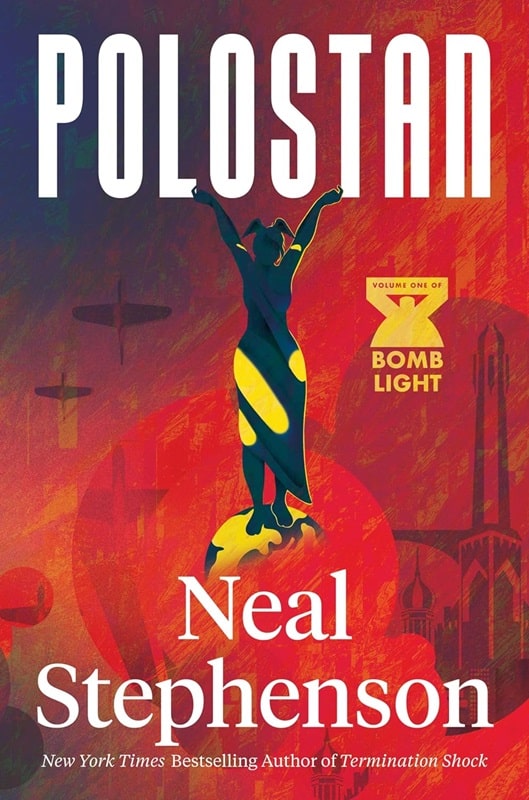
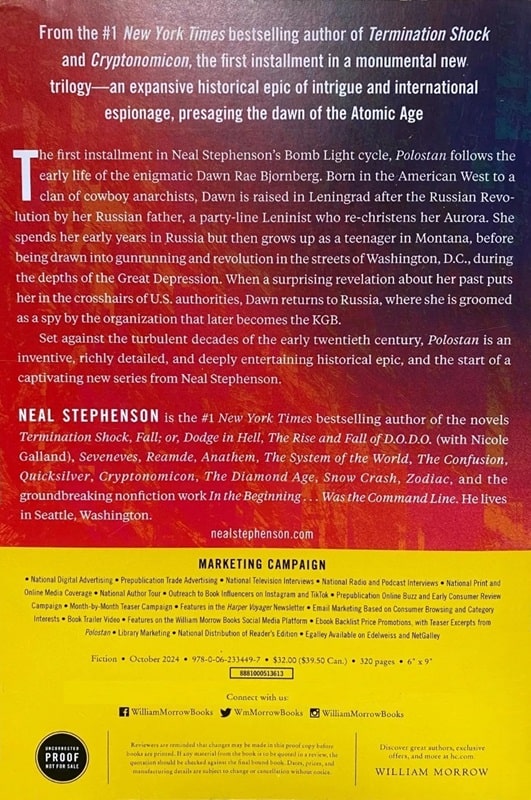
Polostan (William Morrow, October 15, 2024). Cover art uncredited
If, like me, you are a Neal Stephenson fan, you know he has a tendency to get deep into the descriptive weeds. I sometimes imagine his editor suggesting, “Neal, do we really need all this detail?” And then Neal grouchily responds, “If I didn’t think the story needed it, I wouldn’t have written it.”
Case in point from his latest novel, Polostan, a depiction of the 1933 Chicago World’s Fair Century of Progress exhibition where the protagonist, Dawn Rae Bjornberg, also known as Aurora Maximovna Artemyeva, works shilling for a shoe salesman:
She went to the fair early and stayed late, for the work was easy and there were plenty of diversions — that being the point of a fair. Her perambulations soon made her as conversant with the place as if it were an old city…As they were meant to, [the exhibits] drew visitors: 600 Norge salesmen on the B&O from Philly; 176 newsboys on the New York Central from Buffalo; 60 Episcopal bishops; 180 Civilian Conservation Corps workers en route to turpentine camps in the southeast; 100 Minnesota National Guard troops. Paramount Studios executives from Hollywood, Lions from St. Louis, Shriners from Fort Smith…
It goes on like this for quite a while. Do we really need to know that “Five hundred employees of the National Carbon Coated Paper Company of Sturgis, Michigan, arrived on the same train as 270 members of the Jewish Socialist Verband from New York City.” Probably not; it doesn’t further the plot, though it does provide a sort of Proustian vibe.
It’s also a metafictional joke Stephenson tells on himself. After Dawn/Aurora relates her life history to her Soviet inquisitor (which forms a kind of framework to a plethora of narratives, more about that in a second), he remarks, “You’ve been cooperative, if somewhat rambling. But that’s in the nature of your story — you really have been all over the place.”
“All over the place” is also how I’d describe this novel. But in a good way.
Born in 1916, a pivotal time in history when revolution was in the air, Dawn/Aurora’s childhood is split between Montana with her American radical mother and the Soviet Union with her Communist father (hence the American and Russian alter egos). Which makes her an ideal candidate for espionage against one of those countries. But which one is the question.
With an upbringing that includes acquiring equestrian skills, running guns and a fascination with Bonnie and Clyde as well as the Red Woman’s Death Battalion, the attention of then Major George Patton during an encampment of “Bonus Army” protesting World War I veterans in Washington, D.C., an abortion that makes her incapable of further pregnancy (and a matter-of-factly stated no-strings enticement to a prospective lover), and as a captive of con-artist evangelists as well as Soviet secret police OGPU led by the brutal Lavrentiy Beria. She is also witness to a deadly ballon ride by Soviet aeronauts named Elektron and Proton. We’ve already mentioned the Chicago World’s Fair.
But all of that is prologue and epilogue to Dawn’s chance meeting with “Dick,” a boy who impregnates her while on top of an early X-ray machine. Dick is probably Richard Feynman, who assisted in the development of the atomic bomb, but who here is a horny teenager happy to explain to Dawn current thinking in physics about possibly splitting the atom. Which makes her all the more a person of interest to Beria, who Stalin later appoints to head the Soviet atomic program. And which is why this is the first in a planned trilogy called Bomb Light.
Oh, and if you’re curious about what Polostan is supposed to mean, it is coined by British journalist Crisp-Upjohn, whom Aurora is tasked by the the OGPU to compromise, while playing against her during of an exhibition match with the Soviet women’s polo team.
So there is a lot here to unpack. But that Stephenson pulls off in a highly entertaining and brisk way. Because that is what Neal Stephenson does.
What there isn’t is a lot of is pages. While Stephenson is noted for producing doorstops, even for individual books in a series (The Baroque Cycle, for example, adds up to some 3,000 pages across three volumes), Polostan is a mere 303 pages. You might wonder why the author just didn’t produce one big book, other than that genre publishing suffers from a multi-volume series fixation. According to the author, the intent is to focus on a different character in each installment. “As far as the series format is concerned, we made a decision last year to bring it out one normal-sized book at a time, and to configure it in such a way that each volume will focus on one of the main characters. “
Also, Stephenson hasn’t finished writing it. So, there is that.
We wait with bated breath.
David Soyka is one of the founding bloggers at Black Gate. He’s written over 200 articles for us since 2008. His most recent was a review of Playground by Richard Powers.
The Book Devouring Horde Quiz
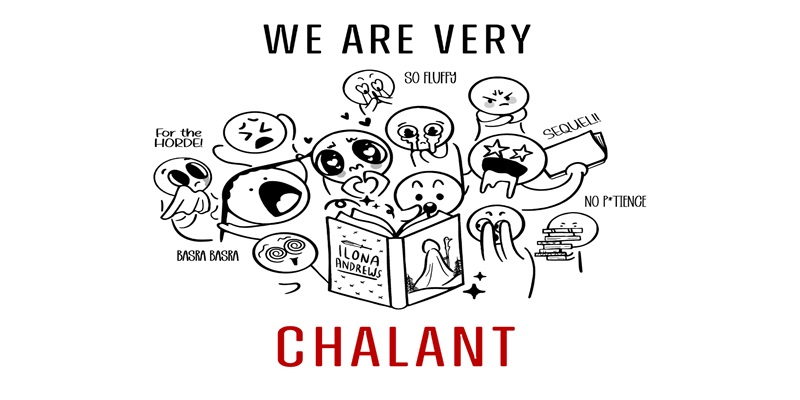
“I heard Realtors have to disclose if the house is haunted,” Leon said.
I looked at Mom in the driver’s seat. She gave me an amused smile. No help there.
“Apparently only four states require you to disclose paranormal activity,” Arabella reported. “Nine states require you to notify the buyer if a death occurred on the premises. And Texas does neither.”
“There were no deaths on the premises. Nobody died in the house, so it can’t possibly be haunted,” I told them.
“How do you know nobody died?” Leon asked.
“Because I checked the records,” Bern rumbled.
“That doesn’t mean anything,” Arabella said.
Clearly, there were two teams in this vehicle: Team Facts and Team Facts Be Damned.”
Andrews, Ilona. Ruby Fever, Hidden Legacy 6. Avon HarperCollins, 2022. Kindle edition, page 3
The Book Devouring Horde, the name for Ilona Andrews fans, stand united as a force to belove. Our fluffiness lies in the way we balance each other’s strengths and weaknesses, quirks and extremes. We remind each other of what is real and what is absolutely, gloriously NOT. And in the end, all that matters is that we all come together in appreciation for the same wonderful books.
But a quick stroll in any BDH comment section will quickly make you understand the reality of the Baylors conversation above. Following several requests and fan group polls, let’s find out which brand of chaos you bring to the Horde table!
Take the quiz below and embrace your destiny.*
*Disclaimer: not your actual destiny. As usual, the results are just for fun because I’m not the real Sorting Hat, I just look like it #wrinklelife. Please don’t take the quiz if this month has taken everything out of you and it could make you real-life upset. Hug(h)s!
Also, the quiz plugin doesn’t play nicely with the newsletter. If you’re getting this in your email, you can click here to come straight to the blog and take it.
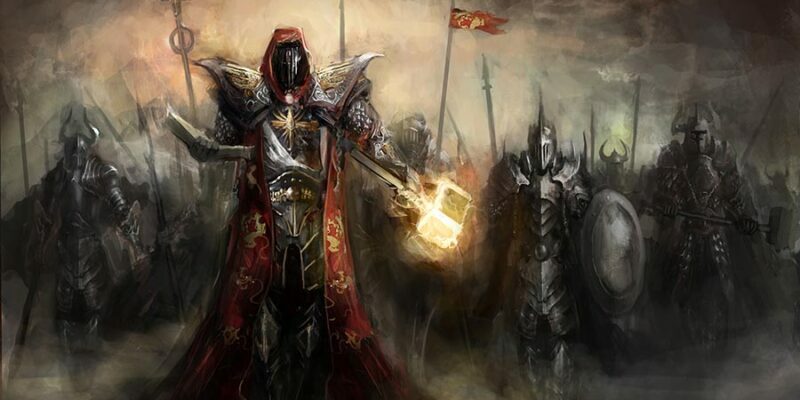
Which BDH team do you belong in?
Ah, the Book Devouring Horde. Whether you're sprinting off into the wilderness of speculation, hold firmly to the foundations of fact, vibrate with anticipation, or discuss everything into the ground- we are a force of nature. Where do you stand, when you stand with us?
1 / 9
Someone shipped Julie and Saiman. Your first instinct is:
 Metal Rose Metal Rose Metal ROOOOOSE!
That’s interesting. I want to hear them out.
Burn it! With FIRE! Burn it with BEAVERS!
Yu Fong? Sure. Ascanio? Maybe. Derek? Most likely, based on all the evidence. Saiman makes no sense. Explain yourself.
Metal Rose Metal Rose Metal ROOOOOSE!
That’s interesting. I want to hear them out.
Burn it! With FIRE! Burn it with BEAVERS!
Yu Fong? Sure. Ascanio? Maybe. Derek? Most likely, based on all the evidence. Saiman makes no sense. Explain yourself.
2 / 9
A BDH colleague posts a theory you don’t agree with:
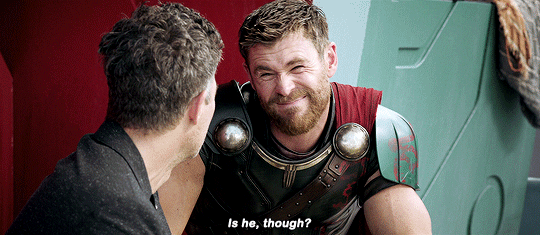 That’s interesting, I like the way you think. I would even agree with you, but then we’d both be wrong.
Your first mistake is that you haven’t taken this far enough! What you first need to understand is that every.single.shifter is a First...
Live and let conspire. I’ll watch how it plays out, and maybe even get a House Andrews answer out of it.
Ever considered doing the action known as “putting two and two together”?
That’s interesting, I like the way you think. I would even agree with you, but then we’d both be wrong.
Your first mistake is that you haven’t taken this far enough! What you first need to understand is that every.single.shifter is a First...
Live and let conspire. I’ll watch how it plays out, and maybe even get a House Andrews answer out of it.
Ever considered doing the action known as “putting two and two together”?
3 / 9
How do you react to the three words most dreaded by the Horde: w*it, p*tience, d*lay?
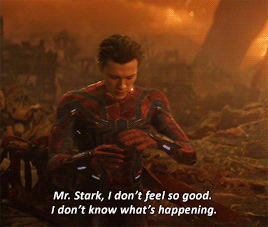 Steady ON. You know there are kids around, right?
It’s not the best, but life happens. We are still beloved.
House Andrews have quit writing. It’s because of all the graphic novels. They'll never go back to real books.
We will murder the words. Patience is futile! Waiting is the mind killer! Delays are the enemy!
Steady ON. You know there are kids around, right?
It’s not the best, but life happens. We are still beloved.
House Andrews have quit writing. It’s because of all the graphic novels. They'll never go back to real books.
We will murder the words. Patience is futile! Waiting is the mind killer! Delays are the enemy!
4 / 9
A serial or snippet you want to reread has been archived on the blog. How do you react?
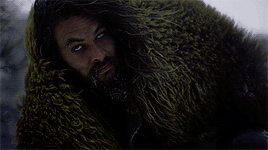 We wish to discuss! Vociferously!
That’s what the Snippet Dark Web is for. I meet with the underground BDH in absconded corners of the internet, and we make the relevant snippet/spoiler trade off.
The Void is darkness, the Void is peace, I am within it, wrapped in its cold embrace...
The authors had their reasons. Hopefully we'll see a final edit of it published.
We wish to discuss! Vociferously!
That’s what the Snippet Dark Web is for. I meet with the underground BDH in absconded corners of the internet, and we make the relevant snippet/spoiler trade off.
The Void is darkness, the Void is peace, I am within it, wrapped in its cold embrace...
The authors had their reasons. Hopefully we'll see a final edit of it published.
5 / 9
Ilona has posted an April Fools' joke about a new book. What do you do?
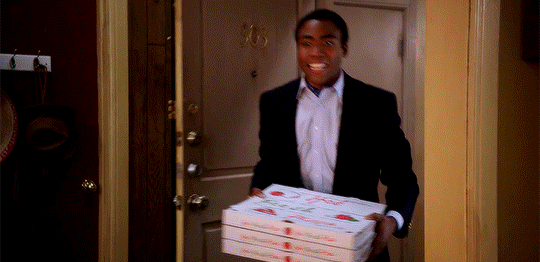 I’ve already requested it from my local librarians and added it to Goodreads, where it has over a thousand reviews so…good luck on keeping this a prank lol
I immediately checked the date and figured out it’s a prank. But you know, they say in every joke there's a kernel of truth…
I go on an emotional rollercoaster before realizing the truth. And another one after realizing the truth.
No backsies. You said it, you write it, we read it. It is known.
I’ve already requested it from my local librarians and added it to Goodreads, where it has over a thousand reviews so…good luck on keeping this a prank lol
I immediately checked the date and figured out it’s a prank. But you know, they say in every joke there's a kernel of truth…
I go on an emotional rollercoaster before realizing the truth. And another one after realizing the truth.
No backsies. You said it, you write it, we read it. It is known.
6 / 9
House Andrews tell us that "The next Innkeeper book will be the end of the missing parents series arc". What does this mean to you?
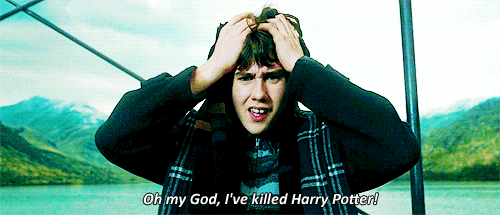 There will never be any more Innkeeper books. We won't find out about Maud! Orro will never cook again! PAPERCUT TO MY SOUL! I told you they sold the series to the muskrats!
End of the series arc doesn't mean the end of the series. They can have several adventures after that, it's a wide Galaxy out there.
Proposal: You write several Gertrude Hunt novellas. Then a Klaus novel. Followed by Helen's series. How Dina met Beast. An Arbitrators Saga, the Jack Camarine spin off, heavily featuring Gaston’s Baha-char business ventures. How Caldenia came to the Inn and other Dominion misadventures and then a Drifen trilogy. Do you wish to discuss?
I do want to know what happens and all the answers, but I don't want it to end. But I’ll preorder it as soon as it’s available!
There will never be any more Innkeeper books. We won't find out about Maud! Orro will never cook again! PAPERCUT TO MY SOUL! I told you they sold the series to the muskrats!
End of the series arc doesn't mean the end of the series. They can have several adventures after that, it's a wide Galaxy out there.
Proposal: You write several Gertrude Hunt novellas. Then a Klaus novel. Followed by Helen's series. How Dina met Beast. An Arbitrators Saga, the Jack Camarine spin off, heavily featuring Gaston’s Baha-char business ventures. How Caldenia came to the Inn and other Dominion misadventures and then a Drifen trilogy. Do you wish to discuss?
I do want to know what happens and all the answers, but I don't want it to end. But I’ll preorder it as soon as it’s available!
7 / 9
There's a new snippet on the blog. How do you react?
 I devour it immediately, thank you!
I’m keeping it for a rainy day.
What about the other series? Does this snippet mean there won't be any more from other series? Have you abandoned them?
Nooooo, I forgot it was a snippet! I got so lost in it and then it was over! Please, House Andrews, may we have some more?
I devour it immediately, thank you!
I’m keeping it for a rainy day.
What about the other series? Does this snippet mean there won't be any more from other series? Have you abandoned them?
Nooooo, I forgot it was a snippet! I got so lost in it and then it was over! Please, House Andrews, may we have some more?
8 / 9
It’s release day of a new Ilona Andrews book, what do you comment?
 I don't comment, I'm DEVOURING!
A long review on the blog. Spoilers might slip. I'm emotionally compromised.
Review on book review sites, questions on the blog release thread.
When is the next one coming out?
I don't comment, I'm DEVOURING!
A long review on the blog. Spoilers might slip. I'm emotionally compromised.
Review on book review sites, questions on the blog release thread.
When is the next one coming out?
9 / 9
House Andrews mention a new character in passing. What's your first thought?
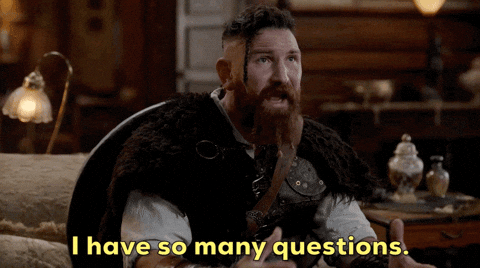 I update my characters chart but wait for more concrete information before making any assumptions.
Never heard the name before, so it's clearly Augustine’s long lost sibling. This means an Arabella trilogy is in the works, with this character as a love interest. And it sounds like an Innkeeper cross-over. I have to tell my friends!
Does this mean a new book? Hope the wait won’t be too long! But aren’t you working on Hugh 2?
If nothing else is put forth in the next 10 working days, I’ll be sure to drop a reminder on the blog. We must discuss!
LinkedIn
Facebook
Twitter
VKontakte
div#ays-quiz-container-8 * { box-sizing: border-box; } /* Styles for Internet Explorer start */ #ays-quiz-container-8 #ays_finish_quiz_8 { } /* Styles for Quiz container */ #ays-quiz-container-8{ min-height: 350px; width:400px; background-color:#fff; background-position:center center;border-radius:0px 0px 0px 0px;box-shadow: 0px 0px 15px 1px rgba(0,0,0,0.4);border: none;} /* Styles for Navigation bar */ #ays-quiz-questions-nav-wrap-8 { width: 100%;border-radius:0px 0px 0px 0px;box-shadow: 0px 0px 15px 1px rgba(0,0,0,0.4);border: none;} #ays-quiz-questions-nav-wrap-8 .ays-quiz-questions-nav-content .ays-quiz-questions-nav-item a.ays_questions_nav_question { color: #000; border-color: #000; background-color: #fff; } #ays-quiz-questions-nav-wrap-8 .ays-quiz-questions-nav-content .ays-quiz-questions-nav-item.ays-quiz-questions-nav-item-active a.ays_questions_nav_question { box-shadow: inset 0 0 5px #000, 0 0 5px #000; } #ays-quiz-questions-nav-wrap-8 .ays-quiz-questions-nav-content .ays-quiz-questions-nav-item.ays-quiz-questions-nav-item-answered a.ays_questions_nav_question { color: #fff; border-color: #fff; background-color: #000; } #ays-quiz-questions-nav-wrap-8 .ays-quiz-questions-nav-content .ays-quiz-questions-nav-item a.ays_questions_nav_question.ays_quiz_correct_answer { color: rgba(39, 174, 96, 1); border-color: rgba(39, 174, 96, 1); background-color: rgba(39, 174, 96, 0.4); } #ays-quiz-questions-nav-wrap-8 .ays-quiz-questions-nav-content .ays-quiz-questions-nav-item a.ays_questions_nav_question.ays_quiz_wrong_answer { color: rgba(243, 134, 129, 1); border-color: rgba(243, 134, 129, 1); background-color: rgba(243, 134, 129, 0.4); } /* Styles for questions */ #ays-quiz-container-8 #ays_finish_quiz_8 div.step { min-height: 350px; } /* Styles for text inside quiz container */ #ays-quiz-container-8.ays-quiz-container .ays-questions-container .ays-start-page *:not(input), #ays-quiz-container-8.ays-quiz-container .ays-questions-container .ays_question_hint, #ays-quiz-container-8.ays-quiz-container .ays-questions-container label[for^="ays-answer-"], #ays-quiz-container-8.ays-quiz-container .ays-questions-container p, #ays-quiz-container-8.ays-quiz-container .ays-questions-container .ays-fs-title, #ays-quiz-container-8.ays-quiz-container .ays-questions-container .ays-fs-subtitle, #ays-quiz-container-8.ays-quiz-container .ays-questions-container .logged_in_message, #ays-quiz-container-8.ays-quiz-container .ays-questions-container .ays-quiz-limitation-count-of-takers, #ays-quiz-container-8.ays-quiz-container .ays-questions-container .ays-quiz-limitation-count-of-takers *, #ays-quiz-container-8.ays-quiz-container .ays-questions-container .ays_score_message, #ays-quiz-container-8.ays-quiz-container .ays-questions-container .ays_message{ color: #000; outline: none; } /* Quiz title / transformation */ #ays-quiz-container-8 .ays-fs-title{ text-transform: uppercase; font-size: 21px; text-align: center; text-shadow: none; } #ays-quiz-container-8 .ays-quiz-password-message-box, #ays-quiz-container-8 .ays-quiz-question-note-message-box, #ays-quiz-container-8 .ays_quiz_question, #ays-quiz-container-8 .ays_quiz_question *:not([class^='enlighter']) { color: #000; } #ays-quiz-container-8 textarea, #ays-quiz-container-8 input::first-letter, #ays-quiz-container-8 select::first-letter, #ays-quiz-container-8 option::first-letter { color: initial !important; } #ays-quiz-container-8 p::first-letter:not(.ays_no_questions_message) { color: #000 !important; background-color: transparent !important; font-size: inherit !important; font-weight: inherit !important; float: none !important; line-height: inherit !important; margin: 0 !important; padding: 0 !important; } #ays-quiz-container-8 .select2-container, #ays-quiz-container-8 .ays-field * { font-size: 15px !important; } #ays-quiz-container-8 .ays-fs-subtitle p { text-align: center ; } #ays-quiz-container-8 .ays_quiz_question p { font-size: 16px; text-align: center; } #ays-quiz-container-8 .ays_quiz_question { text-align: center ; margin-bottom: 10px; } #ays-quiz-container-8 .ays_quiz_question pre { max-width: 100%; white-space: break-spaces; } div#ays-quiz-container-8 .ays-questions-container .ays-field, div#ays-quiz-container-8 .ays-questions-container .ays-field input~label[for^='ays-answer-'], div#ays-quiz-container-8 .ays-questions-container .ays-modern-dark-question *, div#ays-quiz-container-8 .ays-questions-container .ays_quiz_question, div#ays-quiz-container-8 .ays-questions-container .ays_quiz_question *{ word-break: break-word; } #ays-quiz-container-8 .ays-quiz-timer p { font-size: 16px; } #ays-quiz-container-8 section.ays_quiz_redirection_timer_container hr, #ays-quiz-container-8 section.ays_quiz_timer_container hr { margin: 0; } #ays-quiz-container-8 section.ays_quiz_timer_container.ays_quiz_timer_red_warning .ays-quiz-timer { color: red; } #ays-quiz-container-8 .ays_thank_you_fs p { text-align: center; } #ays-quiz-container-8 .information_form input[type='text'], #ays-quiz-container-8 .information_form input[type='url'], #ays-quiz-container-8 .information_form input[type='number'], #ays-quiz-container-8 .information_form input[type='email'], #ays-quiz-container-8 .information_form input[type='tel'], #ays-quiz-container-8 .information_form textarea, #ays-quiz-container-8 .information_form select, #ays-quiz-container-8 .information_form option { color: initial !important; outline: none; margin-left: 0; background-image: unset; } #ays-quiz-container-8 .information_form input[type='checkbox'] { margin: 0 10px; outline: initial; -webkit-appearance: auto; -moz-appearance: auto; position: initial; width: initial; height: initial; border: initial; background: initial; } #ays-quiz-container-8 .information_form input[type='checkbox']::after { content: none; } #ays-quiz-container-8 .wrong_answer_text{ color:#ff4d4d; } #ays-quiz-container-8 .right_answer_text{ color:#33cc33; } #ays-quiz-container-8 .right_answer_text p { font-size:16px; } #ays-quiz-container-8 .wrong_answer_text p { font-size:16px; } #ays-quiz-container-8 .ays_questtion_explanation p { font-size:16px; } #ays-quiz-container-8 .ays_cb_and_a, #ays-quiz-container-8 .ays_cb_and_a * { color: rgb(0,0,0); text-align: center; } #ays-quiz-container-8 iframe { /*min-height: 350px;*/ } #ays-quiz-container-8 label.ays_for_checkbox, #ays-quiz-container-8 span.ays_checkbox_for_span { color: initial !important; display: block; } /* Quiz textarea height */ #ays-quiz-container-8 textarea { height: 100px; min-height: 100px; } /* Quiz rate and passed users count */ #ays-quiz-container-8 .ays_quizn_ancnoxneri_qanak, #ays-quiz-container-8 .ays_quiz_rete_avg{ color:#fff; background-color:#000; } #ays-quiz-container-8 .ays-questions-container > .ays_quizn_ancnoxneri_qanak { padding: 5px 20px; } #ays-quiz-container-8 div.for_quiz_rate.ui.star.rating .icon { color: rgba(0,0,0,0.35); } #ays-quiz-container-8 .ays_quiz_rete_avg div.for_quiz_rate_avg.ui.star.rating .icon { color: rgba(255,255,255,0.5); } #ays-quiz-container-8 .ays_quiz_rete .ays-quiz-rate-link-box .ays-quiz-rate-link { color: #000; } /* Loaders */ #ays-quiz-container-8 div.lds-spinner, #ays-quiz-container-8 div.lds-spinner2 { color: #000; } #ays-quiz-container-8 div.lds-spinner div:after, #ays-quiz-container-8 div.lds-spinner2 div:after { background-color: #000; } #ays-quiz-container-8 .lds-circle, #ays-quiz-container-8 .lds-facebook div, #ays-quiz-container-8 .lds-ellipsis div{ background: #000; } #ays-quiz-container-8 .lds-ripple div{ border-color: #000; } #ays-quiz-container-8 .lds-dual-ring::after, #ays-quiz-container-8 .lds-hourglass::after{ border-color: #000 transparent #000 transparent; } /* Stars */ #ays-quiz-container-8 .ui.rating .icon, #ays-quiz-container-8 .ui.rating .icon:before { font-family: Rating !important; } /* Progress bars */ #ays-quiz-container-8 #ays_finish_quiz_8 .ays-progress { border-color: rgba(0,0,0,0.8); } #ays-quiz-container-8 #ays_finish_quiz_8 .ays-progress-bg { background-color: rgba(0,0,0,0.3); } #ays-quiz-container-8 .ays-progress-value { color: #000; text-align: center; } #ays-quiz-container-8 .ays-progress-bar { background-color: #27AE60; } #ays-quiz-container-8 .ays-question-counter .ays-live-bar-wrap { direction:ltr !important; } #ays-quiz-container-8 .ays-live-bar-fill{ color: #000; border-bottom: 2px solid rgba(0,0,0,0.8); text-shadow: 0px 0px 5px #fff; } #ays-quiz-container-8 .ays-live-bar-fill.ays-live-fourth, #ays-quiz-container-8 .ays-live-bar-fill.ays-live-third, #ays-quiz-container-8 .ays-live-bar-fill.ays-live-second { text-shadow: unset; } #ays-quiz-container-8 .ays-live-bar-percent{ display:none; } /* Music, Sound */ #ays-quiz-container-8 .ays_music_sound { color:rgb(0,0,0); } /* Dropdown questions scroll bar */ #ays-quiz-container-8 blockquote { border-left-color: #000 !important; } /* Quiz Password */ #ays-quiz-container-8 .ays-start-page > input[id^='ays_quiz_password_val_'], #ays-quiz-container-8 .ays-quiz-password-toggle-visibility-box { width: 100%; margin: 0 auto; } /* Question hint */ #ays-quiz-container-8 .ays_question_hint_container .ays_question_hint_text { background-color:#fff; box-shadow: 0 0 15px 3px rgba(0,0,0,0.6); max-width: 270px; } #ays-quiz-container-8 .ays_question_hint_container .ays_question_hint_text p { max-width: unset; } #ays-quiz-container-8 .ays_questions_hint_max_width_class { max-width: 80%; } /* Information form */ #ays-quiz-container-8 .ays-form-title{ color:rgb(0,0,0); } /* Quiz timer */ #ays-quiz-container-8 div.ays-quiz-redirection-timer, #ays-quiz-container-8 div.ays-quiz-timer{ color: #000; text-align: center; } #ays-quiz-container-8 div.ays-quiz-timer.ays-quiz-message-before-timer:before { font-weight: 500; } /* Quiz buttons */ #ays-quiz-container-8 input#ays-submit, #ays-quiz-container-8 #ays_finish_quiz_8 .action-button, div#ays-quiz-container-8 #ays_finish_quiz_8 .action-button.ays_restart_button { background-color: #27AE60; color:#333; font-size: 17px; padding: 10px 20px; border-radius: 3px; white-space: nowrap; letter-spacing: 0; box-shadow: unset; white-space: normal; word-break: break-word; } #ays-quiz-container-8 input#ays-submit, #ays-quiz-container-8 #ays_finish_quiz_8 input.action-button { } #ays-quiz-container-8 #ays_finish_quiz_8 a[class~=ajax_add_to_cart]{ background-color: #fff; color:#333; padding: 10px 5px; font-size: 14px; border-radius: 3px; white-space: nowrap; border: 1px solid #333; } #ays-quiz-container-8 #ays_finish_quiz_8 .action-button.ays_check_answer { padding: 5px 10px; font-size: 17px !important; } #ays-quiz-container-8 #ays_finish_quiz_8 .action-button.ays_download_certificate { white-space: nowrap; padding: 5px 10px; } #ays-quiz-container-8 #ays_finish_quiz_8 .action-button.ays_arrow { color:#333!important; white-space: nowrap; padding: 5px 10px; } #ays-quiz-container-8 input#ays-submit:hover, #ays-quiz-container-8 input#ays-submit:focus, #ays-quiz-container-8 #ays_finish_quiz_8 .action-button:hover, #ays-quiz-container-8 #ays_finish_quiz_8 .action-button:focus { box-shadow: 0 0 0 2px #333; background-color: #27AE60; } #ays-quiz-container-8 .ays_restart_button { color: #333; } #ays-quiz-container-8 .ays_restart_button_p { display: flex; justify-content: center; flex-wrap: wrap; } #ays-quiz-container-8 .ays_buttons_div { justify-content: center; } #ays-quiz-container-8 .step:first-of-type .ays_buttons_div { justify-content: center !important; } #ays-quiz-container-8 input[type='button'], #ays-quiz-container-8 input[type='submit'] { color: #333 !important; outline: none; } #ays-quiz-container-8 #ays_finish_quiz_8 i.ays_early_finish.action-button[disabled]:hover, #ays-quiz-container-8 #ays_finish_quiz_8 i.ays_early_finish.action-button[disabled]:focus, #ays-quiz-container-8 #ays_finish_quiz_8 i.ays_early_finish.action-button[disabled], #ays-quiz-container-8 #ays_finish_quiz_8 i.ays_arrow.action-button[disabled]:hover, #ays-quiz-container-8 #ays_finish_quiz_8 i.ays_arrow.action-button[disabled]:focus, #ays-quiz-container-8 #ays_finish_quiz_8 i.ays_arrow.action-button[disabled] { color: #aaa !important; } #ays-quiz-container-8 .ays_finish.action-button{ margin: 10px 5px; } #ays-quiz-container-8 .ays-share-btn.ays-share-btn-branded { color: #fff; } /* Question answers */ #ays-quiz-container-8 .ays-field { border-color: #444; border-style: solid; border-width: 1px; box-shadow: none;flex-direction: row-reverse; } #ays-quiz-container-8 .ays-quiz-answers .ays-field:hover{ opacity: 1; } #ays-quiz-container-8 #ays_finish_quiz_8 .ays-field label.ays_answer_caption[for^='ays-answer-'] { z-index: 1; position:initial;bottom:0;} #ays-quiz-container-8 #ays_finish_quiz_8 .ays-field input~label[for^='ays-answer-'] { padding: 5px; } #ays-quiz-container-8 #ays_finish_quiz_8 .ays-field { margin-bottom: 10px; } #ays-quiz-container-8 #ays_finish_quiz_8 .ays-field.ays_grid_view_item { width: calc(50% - 5px); } #ays-quiz-container-8 #ays_finish_quiz_8 .ays-field.ays_grid_view_item:nth-child(odd) { margin-right: 5px; } #ays-quiz-container-8 #ays_finish_quiz_8 .ays-field input:checked+label:before { border-color: #27AE60; background: #27AE60; background-clip: content-box; } #ays-quiz-container-8 .ays-quiz-answers div.ays-text-right-answer { color: #000; } /* Answer maximum length of a text field */ #ays-quiz-container-8 .ays_quiz_question_text_message{ color: #000; text-align: left; font-size: 12px; } div#ays-quiz-container-8 div.ays_quiz_question_text_error_message { color: #ff0000; } /* Questions answer image */ #ays-quiz-container-8 .ays-answer-image { width:15em; height:150px; object-fit: cover; } /* Questions answer right/wrong icons */ #ays-quiz-container-8 .ays-field input~label.answered.correct:after{ content: url('http://ilona-andrews.com/wp-content/plugins/quiz-maker/public/images/correct.png'); } #ays-quiz-container-8 .ays-field input~label.answered.wrong:after{ content: url('http://ilona-andrews.com/wp-content/plugins/quiz-maker/public/images/wrong.png'); } #ays-quiz-container-8 .ays-field label.answered:last-of-type:after{ height: auto; left: 10px;top: 10px;} /* Dropdown questions */ #ays-quiz-container-8 .select2-container--default .select2-search--dropdown .select2-search__field:focus, #ays-quiz-container-8 .select2-container--default .select2-search--dropdown .select2-search__field { outline: unset; padding: 0.75rem; } #ays-quiz-container-8 #ays_finish_quiz_8 .ays-field .select2-container--default .select2-selection--single { border-bottom: 2px solid #27AE60; background-color: #27AE60; } #ays-quiz-container-8 .ays-field .select2-container--default .select2-selection--single .select2-selection__rendered, #ays-quiz-container-8 .ays-field .select2-container--default .select2-selection--single .select2-selection__placeholder, #ays-quiz-container-8 .ays-field .select2-container--default .select2-selection--single .select2-selection__arrow { color: #d8519f; } #ays-quiz-container-8 .ays-field .select2-container--default .select2-selection--single .select2-selection__rendered, #ays-quiz-container-8 .select2-container--default .select2-results__option--highlighted[aria-selected] { background-color: #27AE60; } #ays-quiz-container-8 .ays-field .select2-container--default, #ays-quiz-container-8 .ays-field .select2-container--default .selection, #ays-quiz-container-8 .ays-field .select2-container--default .dropdown-wrapper, #ays-quiz-container-8 .ays-field .select2-container--default .select2-selection--single .select2-selection__rendered, #ays-quiz-container-8 .ays-field .select2-container--default .select2-selection--single .select2-selection__rendered .select2-selection__placeholder, #ays-quiz-container-8 .ays-field .select2-container--default .select2-selection--single .select2-selection__arrow, #ays-quiz-container-8 .ays-field .select2-container--default .select2-selection--single .select2-selection__arrow b[role='presentation'] { font-size: 16px !important; } #ays-quiz-container-8 .select2-container--default .select2-results__option { padding: 6px; } /* Dropdown questions scroll bar */ #ays-quiz-container-8 .select2-results__options::-webkit-scrollbar { width: 7px; } #ays-quiz-container-8 .select2-results__options::-webkit-scrollbar-track { background-color: rgba(255,255,255,0.35); } #ays-quiz-container-8 .select2-results__options::-webkit-scrollbar-thumb { transition: .3s ease-in-out; background-color: rgba(255,255,255,0.55); } #ays-quiz-container-8 .select2-results__options::-webkit-scrollbar-thumb:hover { transition: .3s ease-in-out; background-color: rgba(255,255,255,0.85); } /* WooCommerce product */ #ays-quiz-container-8 .ays-woo-block { background-color: rgba(39,174,96,0.8); } #ays-quiz-container-8 .ays-woo-product-block h4.ays-woo-product-title > a { color: #000; } /* Audio / Video */ #ays-quiz-container-8 .mejs-container .mejs-time{ box-sizing: unset; } #ays-quiz-container-8 .mejs-container .mejs-time-rail { padding-top: 15px; } #ays-quiz-container-8 .mejs-container .mejs-mediaelement video { margin: 0; } /* Limitation */ #ays-quiz-container-8 .ays-quiz-limitation-count-of-takers { padding: 50px; } #ays-quiz-container-8 div.ays-quiz-results-toggle-block span.ays-show-res-toggle.ays-res-toggle-show, #ays-quiz-container-8 div.ays-quiz-results-toggle-block span.ays-show-res-toggle.ays-res-toggle-hide{ color: #000; } #ays-quiz-container-8 div.ays-quiz-results-toggle-block input:checked + label.ays_switch_toggle { border: 1px solid #000; } #ays-quiz-container-8 div.ays-quiz-results-toggle-block input:checked + label.ays_switch_toggle { border: 1px solid #000; } #ays-quiz-container-8 div.ays-quiz-results-toggle-block input:checked + label.ays_switch_toggle:after{ background: #000; } #ays-quiz-container-8.ays_quiz_elegant_dark div.ays-quiz-results-toggle-block input:checked + label.ays_switch_toggle:after, #ays-quiz-container-8.ays_quiz_rect_dark div.ays-quiz-results-toggle-block input:checked + label.ays_switch_toggle:after{ background: #000; } /* Hestia theme (Version: 3.0.16) | Start */ #ays-quiz-container-8 .mejs-container .mejs-inner .mejs-controls .mejs-button > button:hover, #ays-quiz-container-8 .mejs-container .mejs-inner .mejs-controls .mejs-button > button { box-shadow: unset; background-color: transparent; } #ays-quiz-container-8 .mejs-container .mejs-inner .mejs-controls .mejs-button > button { margin: 10px 6px; } /* Hestia theme (Version: 3.0.16) | End */ /* Go theme (Version: 1.4.3) | Start */ #ays-quiz-container-8 label[for^='ays-answer']:before, #ays-quiz-container-8 label[for^='ays-answer']:before { -webkit-mask-image: unset; mask-image: unset; } #ays-quiz-container-8.ays_quiz_classic_light .ays-field input:checked+label.answered:before, #ays-quiz-container-8.ays_quiz_classic_dark .ays-field input:checked+label.answered:before { background-color: #27AE60 !important; } #ays-quiz-container-8.ays_quiz_classic_light .ays-field input:checked+label.answered.correct:before, #ays-quiz-container-8.ays_quiz_classic_dark .ays-field input:checked+label.answered.correct:before { background-color: #27ae60 !important; } #ays-quiz-container-8.ays_quiz_classic_light .ays-field input:checked+label.answered.wrong:before, #ays-quiz-container-8.ays_quiz_classic_dark .ays-field input:checked+label.answered.wrong:before { background-color: #cc3700 !important; } /* Go theme (Version: 1.4.3) | End */ #ays-quiz-container-8 .ays_quiz_results fieldset.ays_fieldset .ays_quiz_question .wp-video { width: 100% !important; max-width: 100%; } /* Classic Dark / Classic Light */ /* Dropdown questions right/wrong styles */ #ays-quiz-container-8.ays_quiz_classic_dark .correct_div, #ays-quiz-container-8.ays_quiz_classic_light .correct_div{ border-color: green !important; opacity: 1 !important; background-color: rgba(39,174,96,0.4) !important; } #ays-quiz-container-8.ays_quiz_classic_dark .correct_div .selected-field, #ays-quiz-container-8.ays_quiz_classic_light .correct_div .selected-field { padding: 0px 10px 0px 10px; color: green !important; } #ays-quiz-container-8.ays_quiz_classic_dark .wrong_div, #ays-quiz-container-8.ays_quiz_classic_light .wrong_div{ border-color: red !important; opacity: 1 !important; background-color: rgba(243,134,129,0.4) !important; } #ays-quiz-container-8.ays_quiz_classic_dark .ays-field.checked_answer_div.wrong_div input:checked~label, #ays-quiz-container-8.ays_quiz_classic_light .ays-field.checked_answer_div.wrong_div input:checked~label { background-color: rgba(243,134,129,0.4) !important; } #ays-quiz-container-8 .ays_question_result .ays-field .ays_quiz_hide_correct_answer:after{ content: '' !important; } #ays-quiz-container-8 .ays-quiz-close-full-screen { fill: #000; } #ays-quiz-container-8 .ays-quiz-open-full-screen { fill: #000; } @media screen and (max-width: 768px){ #ays-quiz-container-8{ max-width: 100%; } div#ays-quiz-container-8.ays_quiz_modern_light .step, div#ays-quiz-container-8.ays_quiz_modern_dark .step { padding-right: 0px !important; padding-top: 0px !important; } div#ays-quiz-container-8.ays_quiz_modern_light div.step[data-question-id], div#ays-quiz-container-8.ays_quiz_modern_dark div.step[data-question-id] { background-size: cover !important; background-position: center center !important; } div#ays-quiz-container-8.ays_quiz_modern_light .ays-abs-fs:not(.ays-start-page):not(.ays-end-page), div#ays-quiz-container-8.ays_quiz_modern_dark .ays-abs-fs:not(.ays-start-page):not(.ays-end-page) { width: 100%; } #ays-quiz-container-8 .ays_quiz_question p { font-size: 16px; } #ays-quiz-container-8 .select2-container, #ays-quiz-container-8 .ays-field * { font-size: 15px !important; } div#ays-quiz-container-8 input#ays-submit, div#ays-quiz-container-8 #ays_finish_quiz_8 .action-button, div#ays-quiz-container-8 #ays_finish_quiz_8 .action-button.ays_restart_button { font-size: 17px; } div#ays-quiz-container-8 div.ays-questions-container div.ays-woo-block { width: 100%; } /* Quiz title / mobile font size */ div#ays-quiz-container-8 .ays-fs-title { font-size: 21px; } } /* Custom css styles */ /* RTL direction styles */
#ays-quiz-container-8 p {
margin: 0.625em;
}
#ays-quiz-container-8 .ays-field.checked_answer_div input:checked~label {
background-color: rgba(39,174,96,0.6);
}
#ays-quiz-container-8.ays_quiz_classic_light .enable_correction .ays-field.checked_answer_div input:checked+label,
#ays-quiz-container-8.ays_quiz_classic_dark .enable_correction .ays-field.checked_answer_div input:checked+label {
background-color: transparent;
}
#ays-quiz-container-8.ays-quiz-container.ays_quiz_classic_light .ays-questions-container .ays-field:hover label[for^='ays-answer-'],
#ays-quiz-container-8 .ays-field:hover{
background: rgba(39,174,96,0.8);
color: #fff;
transition: all .3s;
}
#ays-quiz-container-8 #ays_finish_quiz_8 .action-button:hover,
#ays-quiz-container-8 #ays_finish_quiz_8 .action-button:focus {
box-shadow: 0 0 0 2px rgba(255, 255, 255, 0.5), 0 0 0 3px #333;
background: #27AE60;
}
if(typeof aysQuizOptions === 'undefined'){
var aysQuizOptions = [];
}
aysQuizOptions['8'] = 'eyJxdWl6X3ZlcnNpb24iOiI4LjcuNCIsImNvcmVfdmVyc2lvbiI6IjYuNy4xIiwicGhwX3ZlcnNpb24iOiI4LjIuMjciLCJjb2xvciI6IiMyN0FFNjAiLCJiZ19jb2xvciI6IiNmZmYiLCJ0ZXh0X2NvbG9yIjoiIzAwMCIsImhlaWdodCI6MzUwLCJ3aWR0aCI6NDAwLCJlbmFibGVfbG9nZ2VkX3VzZXJzIjoib2ZmIiwiaW5mb3JtYXRpb25fZm9ybSI6ImRpc2FibGUiLCJmb3JtX25hbWUiOiJvZmYiLCJmb3JtX2VtYWlsIjoib2ZmIiwiZm9ybV9waG9uZSI6Im9mZiIsImltYWdlX3dpZHRoIjoiIiwiaW1hZ2VfaGVpZ2h0IjoiIiwiZW5hYmxlX2NvcnJlY3Rpb24iOiJvZmYiLCJlbmFibGVfcHJvZ3Jlc3NfYmFyIjoib2ZmIiwiZW5hYmxlX3F1ZXN0aW9uc19yZXN1bHQiOiJvZmYiLCJyYW5kb21pemVfcXVlc3Rpb25zIjoib24iLCJyYW5kb21pemVfYW5zd2VycyI6Im9mZiIsImVuYWJsZV9xdWVzdGlvbnNfY291bnRlciI6Im9uIiwiZW5hYmxlX3Jlc3RyaWN0aW9uX3Bhc3MiOiJvZmYiLCJlbmFibGVfcmVzdHJpY3Rpb25fcGFzc191c2VycyI6Im9mZiIsInJlc3RyaWN0aW9uX3Bhc3NfbWVzc2FnZSI6IiIsInJlc3RyaWN0aW9uX3Bhc3NfdXNlcnNfbWVzc2FnZSI6IiIsInVzZXJfcm9sZSI6W10sImF5c191c2Vyc19zZWFyY2giOltdLCJjdXN0b21fY3NzIjoiIiwibGltaXRfdXNlcnMiOiJvZmYiLCJsaW1pdGF0aW9uX21lc3NhZ2UiOiIiLCJyZWRpcmVjdF91cmwiOiIiLCJyZWRpcmVjdGlvbl9kZWxheSI6MCwiYW5zd2Vyc192aWV3IjoibGlzdCIsImVuYWJsZV9ydGxfZGlyZWN0aW9uIjoib2ZmIiwiZW5hYmxlX2xvZ2dlZF91c2Vyc19tZXNzYWdlIjoiIiwicXVlc3Rpb25zX2NvdW50IjoiIiwiZW5hYmxlX3F1ZXN0aW9uX2JhbmsiOiJvZmYiLCJlbmFibGVfbGl2ZV9wcm9ncmVzc19iYXIiOiJvZmYiLCJlbmFibGVfcGVyY2VudF92aWV3Ijoib2ZmIiwiZW5hYmxlX2F2ZXJhZ2Vfc3RhdGlzdGljYWwiOiJvZmYiLCJlbmFibGVfbmV4dF9idXR0b24iOiJvZmYiLCJlbmFibGVfcHJldmlvdXNfYnV0dG9uIjoib2ZmIiwiZW5hYmxlX2Fycm93cyI6Im9mZiIsInRpbWVyX3RleHQiOiIiLCJxdWl6X3RoZW1lIjoiY2xhc3NpY19saWdodCIsImVuYWJsZV9zb2NpYWxfYnV0dG9ucyI6Im9uIiwiZmluYWxfcmVzdWx0X3RleHQiOiIiLCJlbmFibGVfcGFzc19jb3VudCI6Im9uIiwiaGlkZV9zY29yZSI6Im9uIiwicmF0ZV9mb3JtX3RpdGxlIjoiIiwiYm94X3NoYWRvd19jb2xvciI6IiMwMDAiLCJxdWl6X2JvcmRlcl9yYWRpdXMiOiIwIiwicXVpel9iZ19pbWFnZSI6IiIsInF1aXpfYm9yZGVyX3dpZHRoIjoiMSIsInF1aXpfYm9yZGVyX3N0eWxlIjoic29saWQiLCJxdWl6X2JvcmRlcl9jb2xvciI6IiMwMDAiLCJxdWl6X2xvYWRlciI6ImRlZmF1bHQiLCJxdWVzdF9hbmltYXRpb24iOiJzaGFrZSIsImVuYWJsZV9iZ19tdXNpYyI6Im9mZiIsInF1aXpfYmdfbXVzaWMiOiIiLCJhbnN3ZXJzX2ZvbnRfc2l6ZSI6MTUsInNob3dfY3JlYXRlX2RhdGUiOiJvZmYiLCJzaG93X2F1dGhvciI6Im9mZiIsImVuYWJsZV9lYXJseV9maW5pc2giOiJvZmYiLCJhbnN3ZXJzX3J3X3RleHRzIjoiZGlzYWJsZSIsImRpc2FibGVfc3RvcmVfZGF0YSI6Im9mZiIsImVuYWJsZV9iYWNrZ3JvdW5kX2dyYWRpZW50Ijoib2ZmIiwiYmFja2dyb3VuZF9ncmFkaWVudF9jb2xvcl8xIjoiIzAwMCIsImJhY2tncm91bmRfZ3JhZGllbnRfY29sb3JfMiI6IiNmZmYiLCJxdWl6X2dyYWRpZW50X2RpcmVjdGlvbiI6InZlcnRpY2FsIiwicmVkaXJlY3RfYWZ0ZXJfc3VibWl0Ijoib2ZmIiwic3VibWl0X3JlZGlyZWN0X3VybCI6IiIsInN1Ym1pdF9yZWRpcmVjdF9kZWxheSI6IjAiLCJwcm9ncmVzc19iYXJfc3R5bGUiOiJmaXJzdCIsImVuYWJsZV9leGl0X2J1dHRvbiI6Im9mZiIsImV4aXRfcmVkaXJlY3RfdXJsIjoiIiwiaW1hZ2Vfc2l6aW5nIjoiY292ZXIiLCJxdWl6X2JnX2ltYWdlX3Bvc2l0aW9uIjoiY2VudGVyIGNlbnRlciIsImN1c3RvbV9jbGFzcyI6IiIsImVuYWJsZV9zb2NpYWxfbGlua3MiOiJvZmYiLCJzb2NpYWxfbGlua3MiOnsibGlua2VkaW5fbGluayI6IiIsImZhY2Vib29rX2xpbmsiOiIiLCJ0d2l0dGVyX2xpbmsiOiIiLCJ2a29udGFrdGVfbGluayI6IiIsImluc3RhZ3JhbV9saW5rIjoiIiwieW91dHViZV9saW5rIjoiIn0sInNob3dfcXVpel90aXRsZSI6Im9uIiwic2hvd19xdWl6X2Rlc2MiOiJvbiIsInNob3dfbG9naW5fZm9ybSI6Im9mZiIsIm1vYmlsZV9tYXhfd2lkdGgiOiIiLCJsaW1pdF91c2Vyc19ieSI6ImlwIiwiZXhwbGFuYXRpb25fdGltZSI6IjQiLCJlbmFibGVfY2xlYXJfYW5zd2VyIjoib2ZmIiwic2hvd19jYXRlZ29yeSI6Im9mZiIsInNob3dfcXVlc3Rpb25fY2F0ZWdvcnkiOiJvZmYiLCJhbnN3ZXJzX3BhZGRpbmciOiI1IiwiYW5zd2Vyc19ib3JkZXIiOiJvbiIsImFuc3dlcnNfYm9yZGVyX3dpZHRoIjoiMSIsImFuc3dlcnNfYm9yZGVyX3N0eWxlIjoic29saWQiLCJhbnN3ZXJzX2JvcmRlcl9jb2xvciI6IiM0NDQiLCJhbnNfaW1nX2hlaWdodCI6IjE1MCIsImFuc19pbWdfY2FwdGlvbl9zdHlsZSI6Im91dHNpZGUiLCJhbnNfaW1nX2NhcHRpb25fcG9zaXRpb24iOiJib3R0b20iLCJhbnN3ZXJzX2JveF9zaGFkb3ciOiJvZmYiLCJhbnN3ZXJzX2JveF9zaGFkb3dfY29sb3IiOiIjMDAwIiwic2hvd19hbnN3ZXJzX2NhcHRpb24iOiJvbiIsImFuc3dlcnNfbWFyZ2luIjoxMCwiYW5zX3JpZ2h0X3dyb25nX2ljb24iOiJkZWZhdWx0IiwiZGlzcGxheV9zY29yZSI6ImJ5X3BvaW50cyIsImVuYWJsZV9yd19hc253ZXJzX3NvdW5kcyI6Im9mZiIsInF1aXpfYmdfaW1nX2luX2ZpbmlzaF9wYWdlIjoib2ZmIiwiZmluaXNoX2FmdGVyX3dyb25nX2Fuc3dlciI6Im9mZiIsImFmdGVyX3RpbWVyX3RleHQiOiIiLCJlbmFibGVfZW50ZXJfa2V5Ijoib24iLCJzaG93X3JhdGVfYWZ0ZXJfcmF0ZSI6Im9uIiwiYnV0dG9uc190ZXh0X2NvbG9yIjoiIzMzMyIsImJ1dHRvbnNfcG9zaXRpb24iOiJjZW50ZXIiLCJidXR0b25zX3NpemUiOiJtZWRpdW0iLCJidXR0b25zX2ZvbnRfc2l6ZSI6IjE3IiwiYnV0dG9uc193aWR0aCI6IiIsImJ1dHRvbnNfbGVmdF9yaWdodF9wYWRkaW5nIjoiMjAiLCJidXR0b25zX3RvcF9ib3R0b21fcGFkZGluZyI6IjEwIiwiYnV0dG9uc19ib3JkZXJfcmFkaXVzIjoiMyIsImVuYWJsZV9hdWRpb19hdXRvcGxheSI6Im9mZiIsImVuYWJsZV9sZWF2ZV9wYWdlIjoib24iLCJzaG93X29ubHlfd3JvbmdfYW5zd2VyIjoib2ZmIiwicGFzc19zY29yZSI6MCwicGFzc19zY29yZV9tZXNzYWdlIjoiPGg0IHN0eWxlPVwidGV4dC1hbGlnbjogY2VudGVyO1wiPkNvbmdyYXR1bGF0aW9ucyE8XC9oND5cclxuPHAgc3R5bGU9XCJ0ZXh0LWFsaWduOiBjZW50ZXI7XCI+WW91IHBhc3NlZCB0aGUgcXVpeiE8XC9wPiIsImZhaWxfc2NvcmVfbWVzc2FnZSI6IjxoNCBzdHlsZT1cInRleHQtYWxpZ246IGNlbnRlcjtcIj5Pb3BzITxcL2g0PlxyXG48cCBzdHlsZT1cInRleHQtYWxpZ246IGNlbnRlcjtcIj5Zb3UgaGF2ZSBub3QgcGFzc2VkIHRoZSBxdWl6IVxyXG5UcnkgYWdhaW4hPFwvcD4iLCJhbnN3ZXJzX29iamVjdF9maXQiOiJjb3ZlciIsInF1aXpfbWF4X3Bhc3NfY291bnQiOjEsInF1ZXN0aW9uX2ZvbnRfc2l6ZSI6MTYsInF1aXpfd2lkdGhfYnlfcGVyY2VudGFnZV9weCI6InBpeGVscyIsInF1ZXN0aW9uc19oaW50X2ljb25fb3JfdGV4dCI6ImRlZmF1bHQiLCJxdWVzdGlvbnNfaGludF92YWx1ZSI6IiIsImVuYWJsZV9lYXJseV9maW5zaF9jb21maXJtX2JveCI6Im9uIiwiaGlkZV9jb3JyZWN0X2Fuc3dlcnMiOiJvZmYiLCJxdWl6X2xvYWRlcl90ZXh0X3ZhbHVlIjoiIiwic2hvd19pbmZvcm1hdGlvbl9mb3JtIjoib24iLCJzaG93X3F1ZXN0aW9uc19leHBsYW5hdGlvbiI6ImRpc2FibGUiLCJlbmFibGVfcXVlc3Rpb25zX29yZGVyaW5nX2J5X2NhdCI6Im9mZiIsImVuYWJsZV9zZW5kX21haWxfdG9fdXNlcl9ieV9wYXNzX3Njb3JlIjoib2ZmIiwiZW5hYmxlX3NlbmRfbWFpbF90b19hZG1pbl9ieV9wYXNzX3Njb3JlIjoib2ZmIiwic2hvd19xdWVzdGlvbnNfbnVtYmVyaW5nIjoibm9uZSIsInNob3dfYW5zd2Vyc19udW1iZXJpbmciOiJub25lIiwicXVpel9sb2FkZXJfY3VzdG9tX2dpZiI6IiIsImRpc2FibGVfaG92ZXJfZWZmZWN0Ijoib2ZmIiwicXVpel9sb2FkZXJfY3VzdG9tX2dpZl93aWR0aCI6MTAwLCJxdWl6X3RpdGxlX3RyYW5zZm9ybWF0aW9uIjoidXBwZXJjYXNlIiwicXVpel9pbWFnZV93aWR0aF9ieV9wZXJjZW50YWdlX3B4IjoicGl4ZWxzIiwicXVpel9pbWFnZV9oZWlnaHQiOiIiLCJxdWl6X2JnX2ltZ19vbl9zdGFydF9wYWdlIjoib2ZmIiwicXVpel9ib3hfc2hhZG93X3hfb2Zmc2V0IjowLCJxdWl6X2JveF9zaGFkb3dfeV9vZmZzZXQiOjAsInF1aXpfYm94X3NoYWRvd196X29mZnNldCI6MTUsInF1aXpfcXVlc3Rpb25fdGV4dF9hbGlnbm1lbnQiOiJjZW50ZXIiLCJxdWl6X2Fycm93X3R5cGUiOiJkZWZhdWx0IiwicXVpel9zaG93X3dyb25nX2Fuc3dlcnNfZmlyc3QiOiJvZmYiLCJxdWl6X2Rpc3BsYXlfYWxsX3F1ZXN0aW9ucyI6Im9mZiIsInF1aXpfdGltZXJfcmVkX3dhcm5pbmciOiJvZmYiLCJxdWl6X3NjaGVkdWxlX3RpbWV6b25lIjoiVVRDLTYiLCJxdWVzdGlvbnNfaGludF9idXR0b25fdmFsdWUiOiIiLCJxdWl6X3RhY2tlcnNfbWVzc2FnZSI6IlRoaXMgcXVpeiBpcyBleHBpcmVkISIsInF1aXpfZW5hYmxlX2xpbmtlZGluX3NoYXJlX2J1dHRvbiI6Im9uIiwicXVpel9lbmFibGVfZmFjZWJvb2tfc2hhcmVfYnV0dG9uIjoib24iLCJxdWl6X2VuYWJsZV90d2l0dGVyX3NoYXJlX2J1dHRvbiI6Im9uIiwicXVpel9lbmFibGVfdmtvbnRha3RlX3NoYXJlX2J1dHRvbiI6Im9uIiwicXVpel9tYWtlX3Jlc3BvbnNlc19hbm9ueW1vdXMiOiJvZmYiLCJxdWl6X21ha2VfYWxsX3Jldmlld19saW5rIjoib2ZmIiwicXVpel9tZXNzYWdlX2JlZm9yZV90aW1lciI6IiIsInF1aXpfcGFzc3dvcmRfbWVzc2FnZSI6IiIsImVuYWJsZV9zZWVfcmVzdWx0X2NvbmZpcm1fYm94Ijoib2ZmIiwiZGlzcGxheV9maWVsZHNfbGFiZWxzIjoib2ZmIiwicXVpel9lbmFibGVfcGFzc3dvcmRfdmlzaWJpbGl0eSI6Im9mZiIsInF1ZXN0aW9uX21vYmlsZV9mb250X3NpemUiOjE2LCJhbnN3ZXJzX21vYmlsZV9mb250X3NpemUiOjE1LCJzb2NpYWxfYnV0dG9uc19oZWFkaW5nIjoiIiwic29jaWFsX2xpbmtzX2hlYWRpbmciOiIiLCJxdWl6X2VuYWJsZV9xdWVzdGlvbl9jYXRlZ29yeV9kZXNjcmlwdGlvbiI6Im9mZiIsInF1aXpfbWVzc2FnZV9iZWZvcmVfcmVkaXJlY3RfdGltZXIiOiIiLCJidXR0b25zX21vYmlsZV9mb250X3NpemUiOjE3LCJxdWl6X2Fuc3dlcl9ib3hfc2hhZG93X3hfb2Zmc2V0IjowLCJxdWl6X2Fuc3dlcl9ib3hfc2hhZG93X3lfb2Zmc2V0IjowLCJxdWl6X2Fuc3dlcl9ib3hfc2hhZG93X3pfb2Zmc2V0IjoxMCwicXVpel9lbmFibGVfdGl0bGVfdGV4dF9zaGFkb3ciOiJvZmYiLCJxdWl6X3RpdGxlX3RleHRfc2hhZG93X2NvbG9yIjoiIzMzMyIsInJpZ2h0X2Fuc3dlcnNfZm9udF9zaXplIjoxNiwid3JvbmdfYW5zd2Vyc19mb250X3NpemUiOjE2LCJxdWVzdF9leHBsYW5hdGlvbl9mb250X3NpemUiOjE2LCJxdWl6X3dhaXRpbmdfdGltZSI6Im9mZiIsInF1aXpfdGl0bGVfdGV4dF9zaGFkb3dfeF9vZmZzZXQiOjIsInF1aXpfdGl0bGVfdGV4dF9zaGFkb3dfeV9vZmZzZXQiOjIsInF1aXpfdGl0bGVfdGV4dF9zaGFkb3dfel9vZmZzZXQiOjIsInF1aXpfc2hvd19vbmx5X3dyb25nX2Fuc3dlcnMiOiJvZmYiLCJxdWl6X3RpdGxlX2ZvbnRfc2l6ZSI6MjEsInF1aXpfdGl0bGVfbW9iaWxlX2ZvbnRfc2l6ZSI6MjEsInF1aXpfcGFzc3dvcmRfd2lkdGgiOiIiLCJxdWl6X3Jldmlld19wbGFjZWhvbGRlcl90ZXh0IjoiIiwicXVpel9tYWtlX3Jldmlld19yZXF1aXJlZCI6Im9mZiIsInF1aXpfZW5hYmxlX3Jlc3VsdHNfdG9nZ2xlIjoib2ZmIiwicXVlc3Rpb25fY291bnRfcGVyX3BhZ2UiOm51bGwsInF1ZXN0aW9uX2NvdW50X3Blcl9wYWdlX251bWJlciI6IiIsIm1haWxfbWVzc2FnZSI6IiIsImVuYWJsZV9jZXJ0aWZpY2F0ZSI6Im9mZiIsImVuYWJsZV9jZXJ0aWZpY2F0ZV93aXRob3V0X3NlbmQiOiJvZmYiLCJjZXJ0aWZpY2F0ZV9wYXNzIjoiMCIsImZvcm1fdGl0bGUiOiIiLCJjZXJ0aWZpY2F0ZV90aXRsZSI6IjxzcGFuIHN0eWxlPVwiZm9udC1zaXplOiA1MHB4OyBmb250LXdlaWdodDogYm9sZDtcIj5DZXJ0aWZpY2F0ZSBvZiBDb21wbGV0aW9uPFwvc3Bhbj4iLCJjZXJ0aWZpY2F0ZV9ib2R5IjoiPHNwYW4gc3R5bGU9XCJmb250LXNpemU6IDI1cHg7XCI+PGk+VGhpcyBpcyB0byBjZXJ0aWZ5IHRoYXQ8XC9pPjxcL3NwYW4+XHJcblxyXG48c3BhbiBzdHlsZT1cImZvbnQtc2l6ZTogMzBweDtcIj48Yj4lJXVzZXJfbmFtZSUlPFwvYj48XC9zcGFuPlxyXG5cclxuPHNwYW4gc3R5bGU9XCJmb250LXNpemU6IDI1cHg7XCI+PGk+aGFzIGNvbXBsZXRlZCB0aGUgcXVpejxcL2k+PFwvc3Bhbj5cclxuXHJcbjxzcGFuIHN0eWxlPVwiZm9udC1zaXplOiAzMHB4O1wiPlwiJSVxdWl6X25hbWUlJVwiPFwvc3Bhbj5cclxuXHJcbjxzcGFuIHN0eWxlPVwiZm9udC1zaXplOiAyMHB4O1wiPndpdGggYSBzY29yZSBvZiA8Yj4lJXNjb3JlJSU8XC9iPjxcL3NwYW4+XHJcblxyXG48c3BhbiBzdHlsZT1cImZvbnQtc2l6ZTogMjVweDtcIj48aT5kYXRlZDxcL2k+PFwvc3Bhbj5cclxuPHNwYW4gc3R5bGU9XCJmb250LXNpemU6IDMwcHg7XCI+JSVjdXJyZW50X2RhdGUlJTxcL3NwYW4+IiwibWFpbGNoaW1wX2xpc3QiOiIiLCJlbmFibGVfbWFpbGNoaW1wIjoib2ZmIiwiZW5hYmxlX2RvdWJsZV9vcHRfaW4iOiJvZmYiLCJhY3RpdmVfZGF0ZV9jaGVjayI6Im9mZiIsImFjdGl2ZUludGVydmFsIjoiMjAyNS0wMS0zMSAxMTowODowNyIsImRlYWN0aXZlSW50ZXJ2YWwiOiIyMDI1LTAxLTMxIDExOjA4OjA3IiwiYWN0aXZlX2RhdGVfbWVzc2FnZSI6IlRoZSBxdWl6IGhhcyBleHBpcmVkISIsImFjdGl2ZV9kYXRlX3ByZV9zdGFydF9tZXNzYWdlIjoiVGhlIHF1aXogd2lsbCBiZSBhdmFpbGFibGUgc29vbiEiLCJjaGVja2JveF9zY29yZV9ieSI6Im9uIiwiY2FsY3VsYXRlX3Njb3JlIjoiYnlfcG9pbnRzIiwic2VuZF9yZXN1bHRzX3VzZXIiOiJvZmYiLCJzZW5kX2ludGVydmFsX21zZyI6Im9mZiIsInF1ZXN0aW9uX2JhbmtfdHlwZSI6ImdlbmVyYWwiLCJxdWVzdGlvbnNfYmFua19jYXRfY291bnQiOnsiMSI6IiJ9LCJlbmFibGVfdGFja2Vyc19jb3VudCI6Im9mZiIsInRhY2tlcnNfY291bnQiOiIiLCJzZW5kX3Jlc3VsdHNfYWRtaW4iOiJvbiIsInNlbmRfaW50ZXJ2YWxfbXNnX3RvX2FkbWluIjoib2ZmIiwic2hvd19pbnRlcnZhbF9tZXNzYWdlIjoib24iLCJhbGxvd19jb2xsZWN0aW5nX2xvZ2dlZF9pbl91c2Vyc19kYXRhIjoib2ZmIiwicXVpel9wYXNzX3Njb3JlIjoiMCIsInNlbmRfY2VydGlmaWNhdGVfdG9fYWRtaW4iOiJvZmYiLCJjZXJ0aWZpY2F0ZV9pbWFnZSI6IiIsImNlcnRpZmljYXRlX2ZyYW1lIjoiZGVmYXVsdCIsImNlcnRpZmljYXRlX29yaWVudGF0aW9uIjoibCIsIm1ha2VfcXVlc3Rpb25zX3JlcXVpcmVkIjoib2ZmIiwiZW5hYmxlX3Bhc3N3b3JkIjoib2ZmIiwicGFzc3dvcmRfcXVpeiI6IiIsIm1haWxfbWVzc2FnZV9hZG1pbiI6IiIsInNlbmRfbWFpbF90b19zaXRlX2FkbWluIjoib24iLCJnZW5lcmF0ZV9wYXNzd29yZCI6ImdlbmVyYWwiLCJnZW5lcmF0ZWRfcGFzc3dvcmRzIjp7ImNyZWF0ZWRfcGFzc3dvcmRzIjpbXSwiYWN0aXZlX3Bhc3N3b3JkcyI6W10sInVzZWRfcGFzc3dvcmRzIjpbXX0sImRpc3BsYXlfc2NvcmVfYnkiOiJieV9rZXl3b3JkcyIsInNob3dfc2NoZWR1bGVfdGltZXIiOiJvZmYiLCJzaG93X3RpbWVyX3R5cGUiOiJjb3VudGRvd24iLCJwcm9ncmVzc19saXZlX2Jhcl9zdHlsZSI6ImRlZmF1bHQiLCJlbmFibGVfZnVsbF9zY3JlZW5fbW9kZSI6Im9mZiIsImVuYWJsZV9uYXZpZ2F0aW9uX2JhciI6Im9mZiIsImhpZGVfbGltaXRfYXR0ZW1wdHNfbm90aWNlIjoib2ZmIiwidHVybl9vbl9leHRyYV9zZWN1cml0eV9jaGVjayI6Im9uIiwiZW5hYmxlX3RvcF9rZXl3b3JkcyI6Im9mZiIsImFzc2lnbl9rZXl3b3JkcyI6W3siYXNzaWduX3RvcF9rZXl3b3JkIjoiQSIsImFzc2lnbl90b3Bfa2V5d29yZF90ZXh0IjoiIn0seyJhc3NpZ25fdG9wX2tleXdvcmQiOiJCIiwiYXNzaWduX3RvcF9rZXl3b3JkX3RleHQiOiIifSx7ImFzc2lnbl90b3Bfa2V5d29yZCI6IkMiLCJhc3NpZ25fdG9wX2tleXdvcmRfdGV4dCI6IiJ9LHsiYXNzaWduX3RvcF9rZXl3b3JkIjoiRCIsImFzc2lnbl90b3Bfa2V5d29yZF90ZXh0IjoiIn1dLCJxdWl6X2VuYWJsZV9jb3Vwb24iOiJvZmYiLCJxdWl6X2NvdXBvbnNfYXJyYXkiOnsicXVpel9hY3RpdmVfY291cG9ucyI6W10sInF1aXpfaW5hY3RpdmVfY291cG9ucyI6W119LCJhcHBseV9wb2ludHNfdG9fa2V5d29yZHMiOiJvZmYiLCJsaW1pdF9hdHRlbXB0c19jb3VudF9ieV91c2VyX3JvbGUiOiIiLCJlbmFibGVfYXV0b3N0YXJ0Ijoib2ZmIiwicGF5cGFsX2Ftb3VudCI6bnVsbCwicGF5cGFsX2N1cnJlbmN5IjpudWxsLCJwYXlwYWxfbWVzc2FnZSI6IiIsImVuYWJsZV9zdHJpcGUiOiJvZmYiLCJzdHJpcGVfYW1vdW50IjoiIiwic3RyaXBlX2N1cnJlbmN5IjoiIiwic3RyaXBlX21lc3NhZ2UiOiJZb3UgbmVlZCB0byBwYXkgdG8gcGFzcyB0aGlzIHF1aXouIiwicGF5bWVudF90eXBlIjoicHJlcGF5IiwiZW5hYmxlX21vbml0b3IiOiJvZmYiLCJtb25pdG9yX2xpc3QiOiIiLCJhY3RpdmVfY2FtcF9saXN0IjoiIiwiZW5hYmxlX3NsYWNrIjoib2ZmIiwic2xhY2tfY29udmVyc2F0aW9uIjoiIiwiYWN0aXZlX2NhbXBfYXV0b21hdGlvbiI6IiIsImVuYWJsZV9hY3RpdmVfY2FtcCI6Im9mZiIsImVuYWJsZV96YXBpZXIiOiJvZmYiLCJlbmFibGVfZ29vZ2xlX3NoZWV0cyI6Im9mZiIsInNwcmVhZHNoZWV0X2lkIjoiIiwiZ29vZ2xlX3NoZWV0X2N1c3RvbV9maWVsZHMiOltdLCJxdWl6X2F0dHJpYnV0ZXMiOm51bGwsInF1aXpfYXR0cmlidXRlc19hY3RpdmVfb3JkZXIiOm51bGwsInF1aXpfYXR0cmlidXRlc19wYXNzaXZlX29yZGVyIjpbImF5c19mb3JtX25hbWUiLCJheXNfZm9ybV9lbWFpbCIsImF5c19mb3JtX3Bob25lIl0sInJlcXVpcmVkX2ZpZWxkcyI6bnVsbCwiZW5hYmxlX3RpbWVyIjoib2ZmIiwidGltZXIiOjEwMCwiZW5hYmxlX3F1aXpfcmF0ZSI6Im9mZiIsImVuYWJsZV9yYXRlX2F2ZyI6Im9mZiIsImVuYWJsZV9ib3hfc2hhZG93Ijoib24iLCJlbmFibGVfYm9yZGVyIjoib2ZmIiwicXVpel90aW1lcl9pbl90aXRsZSI6Im9mZiIsImVuYWJsZV9yYXRlX2NvbW1lbnRzIjoib2ZmIiwiZW5hYmxlX3Jlc3RhcnRfYnV0dG9uIjoib2ZmIiwiYXV0b2ZpbGxfdXNlcl9kYXRhIjoib2ZmIiwiZW5hYmxlX2NvcHlfcHJvdGVjdGlvbiI6Im9mZiIsImVuYWJsZV9wYXlwYWwiOiJvZmYiLCJheXNfZW5hYmxlX3Jlc3RyaWN0aW9uX3Bhc3MiOiJvZmYiLCJheXNfZW5hYmxlX3Jlc3RyaWN0aW9uX3Bhc3NfdXNlcnMiOiJvZmYiLCJyZXN1bHRfdGV4dCI6bnVsbCwiZW5hYmxlX3Jlc3VsdCI6Im9mZiIsImVuYWJsZV9tYWRfbWltaSI6Im9mZiIsIm1hZF9taW1pX2xpc3QiOiIiLCJlbmFibGVfY29udmVydEtpdCI6Im9mZiIsImNvbnZlcnRLaXRfZm9ybV9pZCI6IiIsImVuYWJsZV9nZXRSZXNwb25zZSI6Im9mZiIsImdldFJlc3BvbnNlX2xpc3QiOiIiLCJzdWJtaXRfcmVkaXJlY3RfYWZ0ZXIiOiIiLCJyd19hbnN3ZXJzX3NvdW5kcyI6ZmFsc2UsImlkIjoiOCIsInRpdGxlIjoiV2hpY2ggQkRIIHRlYW0gZG8geW91IGJlbG9uZyBpbj8iLCJkZXNjcmlwdGlvbiI6IkFoLCB0aGUgQm9vayBEZXZvdXJpbmcgSG9yZGUuIFdoZXRoZXIgeW91J3JlIHNwcmludGluZyBvZmYgaW50byB0aGUgd2lsZGVybmVzcyBvZiBzcGVjdWxhdGlvbiwgaG9sZCBmaXJtbHkgdG8gdGhlIGZvdW5kYXRpb25zIG9mIGZhY3QsIHZpYnJhdGUgd2l0aCBhbnRpY2lwYXRpb24sIG9yIGRpc2N1c3MgZXZlcnl0aGluZyBpbnRvIHRoZSBncm91bmQtIHdlIGFyZSBhIGZvcmNlIG9mIG5hdHVyZS4gV2hlcmUgZG8geW91IHN0YW5kLCB3aGVuIHlvdSBzdGFuZCB3aXRoIHVzPyIsInF1aXpfaW1hZ2UiOiJodHRwczpcL1wvaWxvbmEtYW5kcmV3cy5jb21cL3dwLWNvbnRlbnRcL3VwbG9hZHNcLzIwMThcLzAzXC9LbmlnaHRzLWluLWFybW9yLWUxNjAwNDQ5MzQxNDAwLmpwZyIsInF1aXpfY2F0ZWdvcnlfaWQiOiIxIiwicXVlc3Rpb25faWRzIjoiNjYsNjUsNjQsNjMsNjIsNjEsNjAsNTksNTgiLCJvcmRlcmluZyI6IjgiLCJwdWJsaXNoZWQiOiIxIiwiaW50ZXJ2YWxzIjoiW3tcImludGVydmFsX21pblwiOlwiMFwiLFwiaW50ZXJ2YWxfbWF4XCI6XCIyNVwiLFwiaW50ZXJ2YWxfdGV4dFwiOlwiVGVhbSBGYWN0cyBiZSBEYW1uZWQgY2FsbHMgeW91IGhvbWUhXFxyXFxuWW91IGFyZSBhIHJ1bW9yLXdyYW5nbGluZyBwaW9uZWVyLCBsaXZpbmcgYnkgdGhlIGZsaWNrZXJpbmcgZ2xvdyBvZiB0aGUgYmxvZyBmaXJlIHBpdHMsIHN3YXBwaW5nIHdpbGQgdGhlb3JpZXMgbGlrZSBvbGQgbGVnZW5kcywgc3Vydml2aW5nIG9uIHRoZSBzcGFyc2UgcmF0aW9ucyBvZiBzbmlwcGV0cyBhbmQgb2ZmLWhhbmQgYXV0aG9yIGNvbW1lbnRzLiBZb3UgbGVhcCBhY3Jvc3MgY2FueW9ucyBvZiBsb2dpYywgaHVudCBmb3IgY3J5cHRpYyBjbHVlcyBpbiB0aGUgYXNoZXMgb2YgZGVsZXRlZCBwb3N0cywgYW5kIHdyYXAgeW91cnNlbGYgaW4gdGhlIHRhdHRlcmVkIGNsb2FrIG9mIGhvcGUgYXMgeW91IHN0YXJlIGludG8gdGhlIGZsYW1lcywgd2FpdGluZyBmb3IgYSBzaWduLiBcXHJcXG5Zb3VyIG5hdHVyYWwgaGFiaXRhdDogRmFuZG9tIHNwYWNlcywgZnJhbnRpY2FsbHkgaW50ZXJwcmV0aW5nIHZhZ3VlIGVtb2ppcyBmcm9tIHRoZSBhdXRob3JzLlxcclxcbldpdGhvdXQgdGhlIHByb3VkIHBpb25lZXJzIG9mIFRlYW0gRmFjdHMgQmUgRGFtbmVkLCB3ZVxcdTIwMTlkIGhhdmUgZmFyIGxlc3MgZnVuLCBhbmQgbm8gY29tbWVudCBzZWN0aW9uIHdvdWxkIGV2ZXIgcmVhY2ggaXRzIHRydWUsIHVuaGluZ2VkIHBvdGVudGlhbC5cIixcImludGVydmFsX2ltYWdlXCI6XCJodHRwczpcXFwvXFxcL2lsb25hLWFuZHJld3MuY29tXFxcL3dwLWNvbnRlbnRcXFwvdXBsb2Fkc1xcXC8yMDIxXFxcLzA1XFxcL01vb25saWdodC1wYXRoLXdlcmV3b2xmLmpwZ1wiLFwiaW50ZXJ2YWxfcmVkaXJlY3RfdXJsXCI6XCJcIixcImludGVydmFsX3JlZGlyZWN0X2RlbGF5XCI6XCJcIixcImludGVydmFsX3dwcm9kdWN0XCI6XCJcIixcImludGVydmFsX2tleXdvcmRcIjpcIkJcIn0se1wiaW50ZXJ2YWxfbWluXCI6XCIyNlwiLFwiaW50ZXJ2YWxfbWF4XCI6XCI1MFwiLFwiaW50ZXJ2YWxfdGV4dFwiOlwiWW91IGFyZSBhIG1lbWJlciBvZiBUZWFtIEZhY3RzIGFyZSBLaW5nLlxcclxcbkFuIGFuY2hvciBpbiB0aGUgaHVycmljYW5lIG9mIGZhbmRvbSBjaGFvcywgdGhlIHdhdGNodG93ZXIgb2YgcmF0aW9uYWwgdGhvdWdodCwgeW91IHdlcmUgYmFzaWNhbGx5IENhdGFsaW5hIEJheWxvciBpbiBhbm90aGVyIGxpZmUuIFlvdSBkbyBub3QgdGhlb3JpemUgd2lsZGx5XFx1MjAxNHlvdSBjcm9zcy1yZWZlcmVuY2UuIFlvdSBkbyBub3QgYmxpbmRseSBzcGVjdWxhdGVcXHUyMDE0eW91IGZhY3QtY2hlY2ssIGFuZCB5b3Ugc3RhbmQgYXMgdGhlIHN0YWx3YXJ0IHJlbWluZGVyIHRoYXQgXFxcIk5vIHJlbGVhc2UgZGF0ZSB5ZXRcXFwiIG1lYW5zIGV4YWN0bHkgdGhhdFxcdTIwMTRub3QgYW4gYXBvY2FseXB0aWMgcHJvcGhlY3kuIFxcclxcbllvdXIgbmF0dXJhbCBoYWJpdGF0OiBNYWtpbmcgY2F1dGlvdXNseSBvcHRpbWlzdGljIGJsb2cgY29tbWVudHMsIHdoaWxlIGtlZXBpbmcgYSBmaXJtIGV5ZSBvbiB0aG9zZSB0aW1lbGluZXMhXFxyXFxuV2l0aG91dCB0aGUgY29vbCBoZWFkcyBvZiBUZWFtIEZhY3RzLCB3ZVxcdTIwMTlkIGJlIHJ1bm5pbmcgaW4gY2lyY2xlcywgdHJpcHBpbmcgb3ZlciB3aWxkIHRoZW9yaWVzLCBhbmQgcHJvYmFibHkgYmVsaWV2ZSBLbGF1cyB3YXMgYWN0dWFsbHkgYSBkcmFnb24uXCIsXCJpbnRlcnZhbF9pbWFnZVwiOlwiaHR0cHM6XFxcL1xcXC9pbG9uYS1hbmRyZXdzLmNvbVxcXC93cC1jb250ZW50XFxcL3VwbG9hZHNcXFwvMjAxOVxcXC8xMlxcXC9GcmlzdC1TY2hvbGFyLVRoZWsuanBnXCIsXCJpbnRlcnZhbF9yZWRpcmVjdF91cmxcIjpcIlwiLFwiaW50ZXJ2YWxfcmVkaXJlY3RfZGVsYXlcIjpcIlwiLFwiaW50ZXJ2YWxfd3Byb2R1Y3RcIjpcIlwiLFwiaW50ZXJ2YWxfa2V5d29yZFwiOlwiQVwifSx7XCJpbnRlcnZhbF9taW5cIjpcIjUxXCIsXCJpbnRlcnZhbF9tYXhcIjpcIjc1XCIsXCJpbnRlcnZhbF90ZXh0XCI6XCJZb3Ugc3RhbmQgd2l0aCBUZWFtIENoYWxhbnQuXFxyXFxuWW91IHByaWRlIHlvdXJzZWxmIG9uIHlvdXIgcCp0aWVuY2VcXHUyMDE0YW5kIHlldCwgaGVyZSB5b3UgYXJlLCB2aWJyYXRpbmcgd2l0aCBiYXJlbHkgY29udGFpbmVkIGFudGljaXBhdGlvbi4gWW91IGFyZSBoYXBweSB0byBnbyB3aXRoIHRoZSBmbG93LCBidXQgeW91IHdvdWxkIGxpa2UgdG8ga25vdyB3aGF0IHRpbWUgdGhlIGZsb3cgc3RhcnRzIGFuZCBob3cgbWFueSBwYWlycyBvZiBzb2NrcyB5b3UgbmVlZCB0byBwYWNrIGZvciBpdC4gXFxyXFxuWW91IHJlZnJlc2ggdGhlIGJsb2cganVzdCBvbmNlIChvciAxNSB0aW1lcykgYSBkYXksIGp1c3QgaW4gY2FzZSwgYW5kIHlvdSB3YW50IHRvIGJlIGZsdWZmeS4gWW91IHRyeSB0byBiZSBmbHVmZnkuIEJ1dFxcdTIwMjYgaGF2ZSB0aGUgYXV0aG9ycyBjb25zaWRlcmVkIG1heWJlIGp1c3Qgb25lIHRpbnkgbGl0dGxlIHVwZGF0ZT8gQSBtb3JzZWw/IEEgY3J1bWI/XFxyXFxuWW91ciBuYXR1cmFsIGhhYml0YXQ6IHRoZSBmZWF0dXJlZCByZWxlYXNlIHBhZ2UsIGNvdW50aW5nIGRvd24gdGhlIGRheXMgb24gdGhlIHRyYWNrZXIuXFxyXFxuV2l0aG91dCB0aGUgZW1vdGlvbmFsIGRlcHRoIG9mIFRlYW0gQ2hhbGFudCwgd2VcXHUyMDE5ZCBsb3NlIHRoZSBzaGVlciBwYXNzaW9uLCB0aGUgbG9uZ2luZywgdGhlIGRlc3BlcmF0ZSBqb3kgb2Ygd2FpdGluZyBmb3IgdGhlIG5leHQgYm9vayAod2hpbGUgcHJldGVuZGluZyB3ZVxcdTIwMTlyZSBmaW5lIHRocm91Z2ggZHJhbWF0aWMgc2lnaHMpLiBUaGV5IGFyZSBvdXIgYmVhdGluZyBoZWFydC5cIixcImludGVydmFsX2ltYWdlXCI6XCJodHRwczpcXFwvXFxcL2lsb25hLWFuZHJld3MuY29tXFxcL3dwLWNvbnRlbnRcXFwvdXBsb2Fkc1xcXC8yMDI0XFxcLzEyXFxcL0Vtb3Rpb25sYS1zdXBwb3J0LmpwZ1wiLFwiaW50ZXJ2YWxfcmVkaXJlY3RfdXJsXCI6XCJcIixcImludGVydmFsX3JlZGlyZWN0X2RlbGF5XCI6XCJcIixcImludGVydmFsX3dwcm9kdWN0XCI6XCJcIixcImludGVydmFsX2tleXdvcmRcIjpcIkNcIn0se1wiaW50ZXJ2YWxfbWluXCI6XCI3NlwiLFwiaW50ZXJ2YWxfbWF4XCI6XCIxMDBcIixcImludGVydmFsX3RleHRcIjpcIllvdSBiZWxvbmcgdG8gVGVhbSBEdXNoZWd1Yi5cXHJcXG5UaGUgRHVzaGVndWIgRGl2aXNpb24gREVWT1VSUyB0aGUgYm9va3MsIHRlYXJpbmcgdGhyb3VnaCBzdG9yaWVzIGxpa2UgaHVuZ3J5LCBwYWdlLXNocmVkZGluZyBiZWFzdHMuIFlvdSBndXlzIGRvIG5vdCBmZWFyIHNwb2lsZXJzXFx1MjAxNHRoZXkgb25seSBtYWtlIHlvdSBzdHJvbmdlciEgWW91ciBuYXR1cmFsIGhhYml0YXQ6IFRoZSBjb21tZW50cyBzZWN0aW9uLCB2aWJyYXRpbmcgd2l0aCBlbmVyZ3ksIGFybWVkIHdpdGggUHJvcG9zYWwgIzM3OiBOZXcgU3Bpbi1vZmZzIGFuZCBXaHkgVGhleSBBcmUgTmVjZXNzYXJ5LlxcclxcbldpdGhvdXQgdGhlIGluc2F0aWFibGUgaHVuZ2VyIG9mIFRlYW0gRHVzaGVndWJcXHUyMDE0Y3JlZWVlaywgaGlzc3NzcywgaGlzc3Nzc3MsIGtub2NrXFx1MjAxNHdlXFx1MjAxOWQgcHJvYmFibHkgYWNjZXB0IHRoaW5ncyBmYXIgdG9vIGVhc2lseSBhbmQgZGlzY3VzcyBhIGxvdCBsZXNzLiBXaGljaCB3b3VsZCBiZSB0cmFnaWMuXCIsXCJpbnRlcnZhbF9pbWFnZVwiOlwiaHR0cHM6XFxcL1xcXC9pbG9uYS1hbmRyZXdzLmNvbVxcXC93cC1jb250ZW50XFxcL3VwbG9hZHNcXFwvMjAyNFxcXC8wOVxcXC9EdXNoZWd1Yi1mZWF0dXJlZC5qcGdcIixcImludGVydmFsX3JlZGlyZWN0X3VybFwiOlwiXCIsXCJpbnRlcnZhbF9yZWRpcmVjdF9kZWxheVwiOlwiXCIsXCJpbnRlcnZhbF93cHJvZHVjdFwiOlwiXCIsXCJpbnRlcnZhbF9rZXl3b3JkXCI6XCJEXCJ9XSIsImF1dGhvcl9pZCI6IjQ0NzciLCJwb3N0X2lkIjpudWxsLCJjcmVhdGVfZGF0ZSI6IjIwMjUtMDEtMzEgMDk6MDM6MDYiLCJxdWl6X3VybCI6IiIsImlzX3VzZXJfbG9nZ2VkX2luIjpmYWxzZSwicXVpel9hbmltYXRpb25fdG9wIjoxMDAsInF1aXpfZW5hYmxlX2FuaW1hdGlvbl90b3AiOiJvbiIsInN0b3JlX2FsbF9ub3RfZmluaXNoZWRfcmVzdWx0cyI6ZmFsc2V9';
I update my characters chart but wait for more concrete information before making any assumptions.
Never heard the name before, so it's clearly Augustine’s long lost sibling. This means an Arabella trilogy is in the works, with this character as a love interest. And it sounds like an Innkeeper cross-over. I have to tell my friends!
Does this mean a new book? Hope the wait won’t be too long! But aren’t you working on Hugh 2?
If nothing else is put forth in the next 10 working days, I’ll be sure to drop a reminder on the blog. We must discuss!
LinkedIn
Facebook
Twitter
VKontakte
div#ays-quiz-container-8 * { box-sizing: border-box; } /* Styles for Internet Explorer start */ #ays-quiz-container-8 #ays_finish_quiz_8 { } /* Styles for Quiz container */ #ays-quiz-container-8{ min-height: 350px; width:400px; background-color:#fff; background-position:center center;border-radius:0px 0px 0px 0px;box-shadow: 0px 0px 15px 1px rgba(0,0,0,0.4);border: none;} /* Styles for Navigation bar */ #ays-quiz-questions-nav-wrap-8 { width: 100%;border-radius:0px 0px 0px 0px;box-shadow: 0px 0px 15px 1px rgba(0,0,0,0.4);border: none;} #ays-quiz-questions-nav-wrap-8 .ays-quiz-questions-nav-content .ays-quiz-questions-nav-item a.ays_questions_nav_question { color: #000; border-color: #000; background-color: #fff; } #ays-quiz-questions-nav-wrap-8 .ays-quiz-questions-nav-content .ays-quiz-questions-nav-item.ays-quiz-questions-nav-item-active a.ays_questions_nav_question { box-shadow: inset 0 0 5px #000, 0 0 5px #000; } #ays-quiz-questions-nav-wrap-8 .ays-quiz-questions-nav-content .ays-quiz-questions-nav-item.ays-quiz-questions-nav-item-answered a.ays_questions_nav_question { color: #fff; border-color: #fff; background-color: #000; } #ays-quiz-questions-nav-wrap-8 .ays-quiz-questions-nav-content .ays-quiz-questions-nav-item a.ays_questions_nav_question.ays_quiz_correct_answer { color: rgba(39, 174, 96, 1); border-color: rgba(39, 174, 96, 1); background-color: rgba(39, 174, 96, 0.4); } #ays-quiz-questions-nav-wrap-8 .ays-quiz-questions-nav-content .ays-quiz-questions-nav-item a.ays_questions_nav_question.ays_quiz_wrong_answer { color: rgba(243, 134, 129, 1); border-color: rgba(243, 134, 129, 1); background-color: rgba(243, 134, 129, 0.4); } /* Styles for questions */ #ays-quiz-container-8 #ays_finish_quiz_8 div.step { min-height: 350px; } /* Styles for text inside quiz container */ #ays-quiz-container-8.ays-quiz-container .ays-questions-container .ays-start-page *:not(input), #ays-quiz-container-8.ays-quiz-container .ays-questions-container .ays_question_hint, #ays-quiz-container-8.ays-quiz-container .ays-questions-container label[for^="ays-answer-"], #ays-quiz-container-8.ays-quiz-container .ays-questions-container p, #ays-quiz-container-8.ays-quiz-container .ays-questions-container .ays-fs-title, #ays-quiz-container-8.ays-quiz-container .ays-questions-container .ays-fs-subtitle, #ays-quiz-container-8.ays-quiz-container .ays-questions-container .logged_in_message, #ays-quiz-container-8.ays-quiz-container .ays-questions-container .ays-quiz-limitation-count-of-takers, #ays-quiz-container-8.ays-quiz-container .ays-questions-container .ays-quiz-limitation-count-of-takers *, #ays-quiz-container-8.ays-quiz-container .ays-questions-container .ays_score_message, #ays-quiz-container-8.ays-quiz-container .ays-questions-container .ays_message{ color: #000; outline: none; } /* Quiz title / transformation */ #ays-quiz-container-8 .ays-fs-title{ text-transform: uppercase; font-size: 21px; text-align: center; text-shadow: none; } #ays-quiz-container-8 .ays-quiz-password-message-box, #ays-quiz-container-8 .ays-quiz-question-note-message-box, #ays-quiz-container-8 .ays_quiz_question, #ays-quiz-container-8 .ays_quiz_question *:not([class^='enlighter']) { color: #000; } #ays-quiz-container-8 textarea, #ays-quiz-container-8 input::first-letter, #ays-quiz-container-8 select::first-letter, #ays-quiz-container-8 option::first-letter { color: initial !important; } #ays-quiz-container-8 p::first-letter:not(.ays_no_questions_message) { color: #000 !important; background-color: transparent !important; font-size: inherit !important; font-weight: inherit !important; float: none !important; line-height: inherit !important; margin: 0 !important; padding: 0 !important; } #ays-quiz-container-8 .select2-container, #ays-quiz-container-8 .ays-field * { font-size: 15px !important; } #ays-quiz-container-8 .ays-fs-subtitle p { text-align: center ; } #ays-quiz-container-8 .ays_quiz_question p { font-size: 16px; text-align: center; } #ays-quiz-container-8 .ays_quiz_question { text-align: center ; margin-bottom: 10px; } #ays-quiz-container-8 .ays_quiz_question pre { max-width: 100%; white-space: break-spaces; } div#ays-quiz-container-8 .ays-questions-container .ays-field, div#ays-quiz-container-8 .ays-questions-container .ays-field input~label[for^='ays-answer-'], div#ays-quiz-container-8 .ays-questions-container .ays-modern-dark-question *, div#ays-quiz-container-8 .ays-questions-container .ays_quiz_question, div#ays-quiz-container-8 .ays-questions-container .ays_quiz_question *{ word-break: break-word; } #ays-quiz-container-8 .ays-quiz-timer p { font-size: 16px; } #ays-quiz-container-8 section.ays_quiz_redirection_timer_container hr, #ays-quiz-container-8 section.ays_quiz_timer_container hr { margin: 0; } #ays-quiz-container-8 section.ays_quiz_timer_container.ays_quiz_timer_red_warning .ays-quiz-timer { color: red; } #ays-quiz-container-8 .ays_thank_you_fs p { text-align: center; } #ays-quiz-container-8 .information_form input[type='text'], #ays-quiz-container-8 .information_form input[type='url'], #ays-quiz-container-8 .information_form input[type='number'], #ays-quiz-container-8 .information_form input[type='email'], #ays-quiz-container-8 .information_form input[type='tel'], #ays-quiz-container-8 .information_form textarea, #ays-quiz-container-8 .information_form select, #ays-quiz-container-8 .information_form option { color: initial !important; outline: none; margin-left: 0; background-image: unset; } #ays-quiz-container-8 .information_form input[type='checkbox'] { margin: 0 10px; outline: initial; -webkit-appearance: auto; -moz-appearance: auto; position: initial; width: initial; height: initial; border: initial; background: initial; } #ays-quiz-container-8 .information_form input[type='checkbox']::after { content: none; } #ays-quiz-container-8 .wrong_answer_text{ color:#ff4d4d; } #ays-quiz-container-8 .right_answer_text{ color:#33cc33; } #ays-quiz-container-8 .right_answer_text p { font-size:16px; } #ays-quiz-container-8 .wrong_answer_text p { font-size:16px; } #ays-quiz-container-8 .ays_questtion_explanation p { font-size:16px; } #ays-quiz-container-8 .ays_cb_and_a, #ays-quiz-container-8 .ays_cb_and_a * { color: rgb(0,0,0); text-align: center; } #ays-quiz-container-8 iframe { /*min-height: 350px;*/ } #ays-quiz-container-8 label.ays_for_checkbox, #ays-quiz-container-8 span.ays_checkbox_for_span { color: initial !important; display: block; } /* Quiz textarea height */ #ays-quiz-container-8 textarea { height: 100px; min-height: 100px; } /* Quiz rate and passed users count */ #ays-quiz-container-8 .ays_quizn_ancnoxneri_qanak, #ays-quiz-container-8 .ays_quiz_rete_avg{ color:#fff; background-color:#000; } #ays-quiz-container-8 .ays-questions-container > .ays_quizn_ancnoxneri_qanak { padding: 5px 20px; } #ays-quiz-container-8 div.for_quiz_rate.ui.star.rating .icon { color: rgba(0,0,0,0.35); } #ays-quiz-container-8 .ays_quiz_rete_avg div.for_quiz_rate_avg.ui.star.rating .icon { color: rgba(255,255,255,0.5); } #ays-quiz-container-8 .ays_quiz_rete .ays-quiz-rate-link-box .ays-quiz-rate-link { color: #000; } /* Loaders */ #ays-quiz-container-8 div.lds-spinner, #ays-quiz-container-8 div.lds-spinner2 { color: #000; } #ays-quiz-container-8 div.lds-spinner div:after, #ays-quiz-container-8 div.lds-spinner2 div:after { background-color: #000; } #ays-quiz-container-8 .lds-circle, #ays-quiz-container-8 .lds-facebook div, #ays-quiz-container-8 .lds-ellipsis div{ background: #000; } #ays-quiz-container-8 .lds-ripple div{ border-color: #000; } #ays-quiz-container-8 .lds-dual-ring::after, #ays-quiz-container-8 .lds-hourglass::after{ border-color: #000 transparent #000 transparent; } /* Stars */ #ays-quiz-container-8 .ui.rating .icon, #ays-quiz-container-8 .ui.rating .icon:before { font-family: Rating !important; } /* Progress bars */ #ays-quiz-container-8 #ays_finish_quiz_8 .ays-progress { border-color: rgba(0,0,0,0.8); } #ays-quiz-container-8 #ays_finish_quiz_8 .ays-progress-bg { background-color: rgba(0,0,0,0.3); } #ays-quiz-container-8 .ays-progress-value { color: #000; text-align: center; } #ays-quiz-container-8 .ays-progress-bar { background-color: #27AE60; } #ays-quiz-container-8 .ays-question-counter .ays-live-bar-wrap { direction:ltr !important; } #ays-quiz-container-8 .ays-live-bar-fill{ color: #000; border-bottom: 2px solid rgba(0,0,0,0.8); text-shadow: 0px 0px 5px #fff; } #ays-quiz-container-8 .ays-live-bar-fill.ays-live-fourth, #ays-quiz-container-8 .ays-live-bar-fill.ays-live-third, #ays-quiz-container-8 .ays-live-bar-fill.ays-live-second { text-shadow: unset; } #ays-quiz-container-8 .ays-live-bar-percent{ display:none; } /* Music, Sound */ #ays-quiz-container-8 .ays_music_sound { color:rgb(0,0,0); } /* Dropdown questions scroll bar */ #ays-quiz-container-8 blockquote { border-left-color: #000 !important; } /* Quiz Password */ #ays-quiz-container-8 .ays-start-page > input[id^='ays_quiz_password_val_'], #ays-quiz-container-8 .ays-quiz-password-toggle-visibility-box { width: 100%; margin: 0 auto; } /* Question hint */ #ays-quiz-container-8 .ays_question_hint_container .ays_question_hint_text { background-color:#fff; box-shadow: 0 0 15px 3px rgba(0,0,0,0.6); max-width: 270px; } #ays-quiz-container-8 .ays_question_hint_container .ays_question_hint_text p { max-width: unset; } #ays-quiz-container-8 .ays_questions_hint_max_width_class { max-width: 80%; } /* Information form */ #ays-quiz-container-8 .ays-form-title{ color:rgb(0,0,0); } /* Quiz timer */ #ays-quiz-container-8 div.ays-quiz-redirection-timer, #ays-quiz-container-8 div.ays-quiz-timer{ color: #000; text-align: center; } #ays-quiz-container-8 div.ays-quiz-timer.ays-quiz-message-before-timer:before { font-weight: 500; } /* Quiz buttons */ #ays-quiz-container-8 input#ays-submit, #ays-quiz-container-8 #ays_finish_quiz_8 .action-button, div#ays-quiz-container-8 #ays_finish_quiz_8 .action-button.ays_restart_button { background-color: #27AE60; color:#333; font-size: 17px; padding: 10px 20px; border-radius: 3px; white-space: nowrap; letter-spacing: 0; box-shadow: unset; white-space: normal; word-break: break-word; } #ays-quiz-container-8 input#ays-submit, #ays-quiz-container-8 #ays_finish_quiz_8 input.action-button { } #ays-quiz-container-8 #ays_finish_quiz_8 a[class~=ajax_add_to_cart]{ background-color: #fff; color:#333; padding: 10px 5px; font-size: 14px; border-radius: 3px; white-space: nowrap; border: 1px solid #333; } #ays-quiz-container-8 #ays_finish_quiz_8 .action-button.ays_check_answer { padding: 5px 10px; font-size: 17px !important; } #ays-quiz-container-8 #ays_finish_quiz_8 .action-button.ays_download_certificate { white-space: nowrap; padding: 5px 10px; } #ays-quiz-container-8 #ays_finish_quiz_8 .action-button.ays_arrow { color:#333!important; white-space: nowrap; padding: 5px 10px; } #ays-quiz-container-8 input#ays-submit:hover, #ays-quiz-container-8 input#ays-submit:focus, #ays-quiz-container-8 #ays_finish_quiz_8 .action-button:hover, #ays-quiz-container-8 #ays_finish_quiz_8 .action-button:focus { box-shadow: 0 0 0 2px #333; background-color: #27AE60; } #ays-quiz-container-8 .ays_restart_button { color: #333; } #ays-quiz-container-8 .ays_restart_button_p { display: flex; justify-content: center; flex-wrap: wrap; } #ays-quiz-container-8 .ays_buttons_div { justify-content: center; } #ays-quiz-container-8 .step:first-of-type .ays_buttons_div { justify-content: center !important; } #ays-quiz-container-8 input[type='button'], #ays-quiz-container-8 input[type='submit'] { color: #333 !important; outline: none; } #ays-quiz-container-8 #ays_finish_quiz_8 i.ays_early_finish.action-button[disabled]:hover, #ays-quiz-container-8 #ays_finish_quiz_8 i.ays_early_finish.action-button[disabled]:focus, #ays-quiz-container-8 #ays_finish_quiz_8 i.ays_early_finish.action-button[disabled], #ays-quiz-container-8 #ays_finish_quiz_8 i.ays_arrow.action-button[disabled]:hover, #ays-quiz-container-8 #ays_finish_quiz_8 i.ays_arrow.action-button[disabled]:focus, #ays-quiz-container-8 #ays_finish_quiz_8 i.ays_arrow.action-button[disabled] { color: #aaa !important; } #ays-quiz-container-8 .ays_finish.action-button{ margin: 10px 5px; } #ays-quiz-container-8 .ays-share-btn.ays-share-btn-branded { color: #fff; } /* Question answers */ #ays-quiz-container-8 .ays-field { border-color: #444; border-style: solid; border-width: 1px; box-shadow: none;flex-direction: row-reverse; } #ays-quiz-container-8 .ays-quiz-answers .ays-field:hover{ opacity: 1; } #ays-quiz-container-8 #ays_finish_quiz_8 .ays-field label.ays_answer_caption[for^='ays-answer-'] { z-index: 1; position:initial;bottom:0;} #ays-quiz-container-8 #ays_finish_quiz_8 .ays-field input~label[for^='ays-answer-'] { padding: 5px; } #ays-quiz-container-8 #ays_finish_quiz_8 .ays-field { margin-bottom: 10px; } #ays-quiz-container-8 #ays_finish_quiz_8 .ays-field.ays_grid_view_item { width: calc(50% - 5px); } #ays-quiz-container-8 #ays_finish_quiz_8 .ays-field.ays_grid_view_item:nth-child(odd) { margin-right: 5px; } #ays-quiz-container-8 #ays_finish_quiz_8 .ays-field input:checked+label:before { border-color: #27AE60; background: #27AE60; background-clip: content-box; } #ays-quiz-container-8 .ays-quiz-answers div.ays-text-right-answer { color: #000; } /* Answer maximum length of a text field */ #ays-quiz-container-8 .ays_quiz_question_text_message{ color: #000; text-align: left; font-size: 12px; } div#ays-quiz-container-8 div.ays_quiz_question_text_error_message { color: #ff0000; } /* Questions answer image */ #ays-quiz-container-8 .ays-answer-image { width:15em; height:150px; object-fit: cover; } /* Questions answer right/wrong icons */ #ays-quiz-container-8 .ays-field input~label.answered.correct:after{ content: url('http://ilona-andrews.com/wp-content/plugins/quiz-maker/public/images/correct.png'); } #ays-quiz-container-8 .ays-field input~label.answered.wrong:after{ content: url('http://ilona-andrews.com/wp-content/plugins/quiz-maker/public/images/wrong.png'); } #ays-quiz-container-8 .ays-field label.answered:last-of-type:after{ height: auto; left: 10px;top: 10px;} /* Dropdown questions */ #ays-quiz-container-8 .select2-container--default .select2-search--dropdown .select2-search__field:focus, #ays-quiz-container-8 .select2-container--default .select2-search--dropdown .select2-search__field { outline: unset; padding: 0.75rem; } #ays-quiz-container-8 #ays_finish_quiz_8 .ays-field .select2-container--default .select2-selection--single { border-bottom: 2px solid #27AE60; background-color: #27AE60; } #ays-quiz-container-8 .ays-field .select2-container--default .select2-selection--single .select2-selection__rendered, #ays-quiz-container-8 .ays-field .select2-container--default .select2-selection--single .select2-selection__placeholder, #ays-quiz-container-8 .ays-field .select2-container--default .select2-selection--single .select2-selection__arrow { color: #d8519f; } #ays-quiz-container-8 .ays-field .select2-container--default .select2-selection--single .select2-selection__rendered, #ays-quiz-container-8 .select2-container--default .select2-results__option--highlighted[aria-selected] { background-color: #27AE60; } #ays-quiz-container-8 .ays-field .select2-container--default, #ays-quiz-container-8 .ays-field .select2-container--default .selection, #ays-quiz-container-8 .ays-field .select2-container--default .dropdown-wrapper, #ays-quiz-container-8 .ays-field .select2-container--default .select2-selection--single .select2-selection__rendered, #ays-quiz-container-8 .ays-field .select2-container--default .select2-selection--single .select2-selection__rendered .select2-selection__placeholder, #ays-quiz-container-8 .ays-field .select2-container--default .select2-selection--single .select2-selection__arrow, #ays-quiz-container-8 .ays-field .select2-container--default .select2-selection--single .select2-selection__arrow b[role='presentation'] { font-size: 16px !important; } #ays-quiz-container-8 .select2-container--default .select2-results__option { padding: 6px; } /* Dropdown questions scroll bar */ #ays-quiz-container-8 .select2-results__options::-webkit-scrollbar { width: 7px; } #ays-quiz-container-8 .select2-results__options::-webkit-scrollbar-track { background-color: rgba(255,255,255,0.35); } #ays-quiz-container-8 .select2-results__options::-webkit-scrollbar-thumb { transition: .3s ease-in-out; background-color: rgba(255,255,255,0.55); } #ays-quiz-container-8 .select2-results__options::-webkit-scrollbar-thumb:hover { transition: .3s ease-in-out; background-color: rgba(255,255,255,0.85); } /* WooCommerce product */ #ays-quiz-container-8 .ays-woo-block { background-color: rgba(39,174,96,0.8); } #ays-quiz-container-8 .ays-woo-product-block h4.ays-woo-product-title > a { color: #000; } /* Audio / Video */ #ays-quiz-container-8 .mejs-container .mejs-time{ box-sizing: unset; } #ays-quiz-container-8 .mejs-container .mejs-time-rail { padding-top: 15px; } #ays-quiz-container-8 .mejs-container .mejs-mediaelement video { margin: 0; } /* Limitation */ #ays-quiz-container-8 .ays-quiz-limitation-count-of-takers { padding: 50px; } #ays-quiz-container-8 div.ays-quiz-results-toggle-block span.ays-show-res-toggle.ays-res-toggle-show, #ays-quiz-container-8 div.ays-quiz-results-toggle-block span.ays-show-res-toggle.ays-res-toggle-hide{ color: #000; } #ays-quiz-container-8 div.ays-quiz-results-toggle-block input:checked + label.ays_switch_toggle { border: 1px solid #000; } #ays-quiz-container-8 div.ays-quiz-results-toggle-block input:checked + label.ays_switch_toggle { border: 1px solid #000; } #ays-quiz-container-8 div.ays-quiz-results-toggle-block input:checked + label.ays_switch_toggle:after{ background: #000; } #ays-quiz-container-8.ays_quiz_elegant_dark div.ays-quiz-results-toggle-block input:checked + label.ays_switch_toggle:after, #ays-quiz-container-8.ays_quiz_rect_dark div.ays-quiz-results-toggle-block input:checked + label.ays_switch_toggle:after{ background: #000; } /* Hestia theme (Version: 3.0.16) | Start */ #ays-quiz-container-8 .mejs-container .mejs-inner .mejs-controls .mejs-button > button:hover, #ays-quiz-container-8 .mejs-container .mejs-inner .mejs-controls .mejs-button > button { box-shadow: unset; background-color: transparent; } #ays-quiz-container-8 .mejs-container .mejs-inner .mejs-controls .mejs-button > button { margin: 10px 6px; } /* Hestia theme (Version: 3.0.16) | End */ /* Go theme (Version: 1.4.3) | Start */ #ays-quiz-container-8 label[for^='ays-answer']:before, #ays-quiz-container-8 label[for^='ays-answer']:before { -webkit-mask-image: unset; mask-image: unset; } #ays-quiz-container-8.ays_quiz_classic_light .ays-field input:checked+label.answered:before, #ays-quiz-container-8.ays_quiz_classic_dark .ays-field input:checked+label.answered:before { background-color: #27AE60 !important; } #ays-quiz-container-8.ays_quiz_classic_light .ays-field input:checked+label.answered.correct:before, #ays-quiz-container-8.ays_quiz_classic_dark .ays-field input:checked+label.answered.correct:before { background-color: #27ae60 !important; } #ays-quiz-container-8.ays_quiz_classic_light .ays-field input:checked+label.answered.wrong:before, #ays-quiz-container-8.ays_quiz_classic_dark .ays-field input:checked+label.answered.wrong:before { background-color: #cc3700 !important; } /* Go theme (Version: 1.4.3) | End */ #ays-quiz-container-8 .ays_quiz_results fieldset.ays_fieldset .ays_quiz_question .wp-video { width: 100% !important; max-width: 100%; } /* Classic Dark / Classic Light */ /* Dropdown questions right/wrong styles */ #ays-quiz-container-8.ays_quiz_classic_dark .correct_div, #ays-quiz-container-8.ays_quiz_classic_light .correct_div{ border-color: green !important; opacity: 1 !important; background-color: rgba(39,174,96,0.4) !important; } #ays-quiz-container-8.ays_quiz_classic_dark .correct_div .selected-field, #ays-quiz-container-8.ays_quiz_classic_light .correct_div .selected-field { padding: 0px 10px 0px 10px; color: green !important; } #ays-quiz-container-8.ays_quiz_classic_dark .wrong_div, #ays-quiz-container-8.ays_quiz_classic_light .wrong_div{ border-color: red !important; opacity: 1 !important; background-color: rgba(243,134,129,0.4) !important; } #ays-quiz-container-8.ays_quiz_classic_dark .ays-field.checked_answer_div.wrong_div input:checked~label, #ays-quiz-container-8.ays_quiz_classic_light .ays-field.checked_answer_div.wrong_div input:checked~label { background-color: rgba(243,134,129,0.4) !important; } #ays-quiz-container-8 .ays_question_result .ays-field .ays_quiz_hide_correct_answer:after{ content: '' !important; } #ays-quiz-container-8 .ays-quiz-close-full-screen { fill: #000; } #ays-quiz-container-8 .ays-quiz-open-full-screen { fill: #000; } @media screen and (max-width: 768px){ #ays-quiz-container-8{ max-width: 100%; } div#ays-quiz-container-8.ays_quiz_modern_light .step, div#ays-quiz-container-8.ays_quiz_modern_dark .step { padding-right: 0px !important; padding-top: 0px !important; } div#ays-quiz-container-8.ays_quiz_modern_light div.step[data-question-id], div#ays-quiz-container-8.ays_quiz_modern_dark div.step[data-question-id] { background-size: cover !important; background-position: center center !important; } div#ays-quiz-container-8.ays_quiz_modern_light .ays-abs-fs:not(.ays-start-page):not(.ays-end-page), div#ays-quiz-container-8.ays_quiz_modern_dark .ays-abs-fs:not(.ays-start-page):not(.ays-end-page) { width: 100%; } #ays-quiz-container-8 .ays_quiz_question p { font-size: 16px; } #ays-quiz-container-8 .select2-container, #ays-quiz-container-8 .ays-field * { font-size: 15px !important; } div#ays-quiz-container-8 input#ays-submit, div#ays-quiz-container-8 #ays_finish_quiz_8 .action-button, div#ays-quiz-container-8 #ays_finish_quiz_8 .action-button.ays_restart_button { font-size: 17px; } div#ays-quiz-container-8 div.ays-questions-container div.ays-woo-block { width: 100%; } /* Quiz title / mobile font size */ div#ays-quiz-container-8 .ays-fs-title { font-size: 21px; } } /* Custom css styles */ /* RTL direction styles */
#ays-quiz-container-8 p {
margin: 0.625em;
}
#ays-quiz-container-8 .ays-field.checked_answer_div input:checked~label {
background-color: rgba(39,174,96,0.6);
}
#ays-quiz-container-8.ays_quiz_classic_light .enable_correction .ays-field.checked_answer_div input:checked+label,
#ays-quiz-container-8.ays_quiz_classic_dark .enable_correction .ays-field.checked_answer_div input:checked+label {
background-color: transparent;
}
#ays-quiz-container-8.ays-quiz-container.ays_quiz_classic_light .ays-questions-container .ays-field:hover label[for^='ays-answer-'],
#ays-quiz-container-8 .ays-field:hover{
background: rgba(39,174,96,0.8);
color: #fff;
transition: all .3s;
}
#ays-quiz-container-8 #ays_finish_quiz_8 .action-button:hover,
#ays-quiz-container-8 #ays_finish_quiz_8 .action-button:focus {
box-shadow: 0 0 0 2px rgba(255, 255, 255, 0.5), 0 0 0 3px #333;
background: #27AE60;
}
if(typeof aysQuizOptions === 'undefined'){
var aysQuizOptions = [];
}
aysQuizOptions['8'] = 'eyJxdWl6X3ZlcnNpb24iOiI4LjcuNCIsImNvcmVfdmVyc2lvbiI6IjYuNy4xIiwicGhwX3ZlcnNpb24iOiI4LjIuMjciLCJjb2xvciI6IiMyN0FFNjAiLCJiZ19jb2xvciI6IiNmZmYiLCJ0ZXh0X2NvbG9yIjoiIzAwMCIsImhlaWdodCI6MzUwLCJ3aWR0aCI6NDAwLCJlbmFibGVfbG9nZ2VkX3VzZXJzIjoib2ZmIiwiaW5mb3JtYXRpb25fZm9ybSI6ImRpc2FibGUiLCJmb3JtX25hbWUiOiJvZmYiLCJmb3JtX2VtYWlsIjoib2ZmIiwiZm9ybV9waG9uZSI6Im9mZiIsImltYWdlX3dpZHRoIjoiIiwiaW1hZ2VfaGVpZ2h0IjoiIiwiZW5hYmxlX2NvcnJlY3Rpb24iOiJvZmYiLCJlbmFibGVfcHJvZ3Jlc3NfYmFyIjoib2ZmIiwiZW5hYmxlX3F1ZXN0aW9uc19yZXN1bHQiOiJvZmYiLCJyYW5kb21pemVfcXVlc3Rpb25zIjoib24iLCJyYW5kb21pemVfYW5zd2VycyI6Im9mZiIsImVuYWJsZV9xdWVzdGlvbnNfY291bnRlciI6Im9uIiwiZW5hYmxlX3Jlc3RyaWN0aW9uX3Bhc3MiOiJvZmYiLCJlbmFibGVfcmVzdHJpY3Rpb25fcGFzc191c2VycyI6Im9mZiIsInJlc3RyaWN0aW9uX3Bhc3NfbWVzc2FnZSI6IiIsInJlc3RyaWN0aW9uX3Bhc3NfdXNlcnNfbWVzc2FnZSI6IiIsInVzZXJfcm9sZSI6W10sImF5c191c2Vyc19zZWFyY2giOltdLCJjdXN0b21fY3NzIjoiIiwibGltaXRfdXNlcnMiOiJvZmYiLCJsaW1pdGF0aW9uX21lc3NhZ2UiOiIiLCJyZWRpcmVjdF91cmwiOiIiLCJyZWRpcmVjdGlvbl9kZWxheSI6MCwiYW5zd2Vyc192aWV3IjoibGlzdCIsImVuYWJsZV9ydGxfZGlyZWN0aW9uIjoib2ZmIiwiZW5hYmxlX2xvZ2dlZF91c2Vyc19tZXNzYWdlIjoiIiwicXVlc3Rpb25zX2NvdW50IjoiIiwiZW5hYmxlX3F1ZXN0aW9uX2JhbmsiOiJvZmYiLCJlbmFibGVfbGl2ZV9wcm9ncmVzc19iYXIiOiJvZmYiLCJlbmFibGVfcGVyY2VudF92aWV3Ijoib2ZmIiwiZW5hYmxlX2F2ZXJhZ2Vfc3RhdGlzdGljYWwiOiJvZmYiLCJlbmFibGVfbmV4dF9idXR0b24iOiJvZmYiLCJlbmFibGVfcHJldmlvdXNfYnV0dG9uIjoib2ZmIiwiZW5hYmxlX2Fycm93cyI6Im9mZiIsInRpbWVyX3RleHQiOiIiLCJxdWl6X3RoZW1lIjoiY2xhc3NpY19saWdodCIsImVuYWJsZV9zb2NpYWxfYnV0dG9ucyI6Im9uIiwiZmluYWxfcmVzdWx0X3RleHQiOiIiLCJlbmFibGVfcGFzc19jb3VudCI6Im9uIiwiaGlkZV9zY29yZSI6Im9uIiwicmF0ZV9mb3JtX3RpdGxlIjoiIiwiYm94X3NoYWRvd19jb2xvciI6IiMwMDAiLCJxdWl6X2JvcmRlcl9yYWRpdXMiOiIwIiwicXVpel9iZ19pbWFnZSI6IiIsInF1aXpfYm9yZGVyX3dpZHRoIjoiMSIsInF1aXpfYm9yZGVyX3N0eWxlIjoic29saWQiLCJxdWl6X2JvcmRlcl9jb2xvciI6IiMwMDAiLCJxdWl6X2xvYWRlciI6ImRlZmF1bHQiLCJxdWVzdF9hbmltYXRpb24iOiJzaGFrZSIsImVuYWJsZV9iZ19tdXNpYyI6Im9mZiIsInF1aXpfYmdfbXVzaWMiOiIiLCJhbnN3ZXJzX2ZvbnRfc2l6ZSI6MTUsInNob3dfY3JlYXRlX2RhdGUiOiJvZmYiLCJzaG93X2F1dGhvciI6Im9mZiIsImVuYWJsZV9lYXJseV9maW5pc2giOiJvZmYiLCJhbnN3ZXJzX3J3X3RleHRzIjoiZGlzYWJsZSIsImRpc2FibGVfc3RvcmVfZGF0YSI6Im9mZiIsImVuYWJsZV9iYWNrZ3JvdW5kX2dyYWRpZW50Ijoib2ZmIiwiYmFja2dyb3VuZF9ncmFkaWVudF9jb2xvcl8xIjoiIzAwMCIsImJhY2tncm91bmRfZ3JhZGllbnRfY29sb3JfMiI6IiNmZmYiLCJxdWl6X2dyYWRpZW50X2RpcmVjdGlvbiI6InZlcnRpY2FsIiwicmVkaXJlY3RfYWZ0ZXJfc3VibWl0Ijoib2ZmIiwic3VibWl0X3JlZGlyZWN0X3VybCI6IiIsInN1Ym1pdF9yZWRpcmVjdF9kZWxheSI6IjAiLCJwcm9ncmVzc19iYXJfc3R5bGUiOiJmaXJzdCIsImVuYWJsZV9leGl0X2J1dHRvbiI6Im9mZiIsImV4aXRfcmVkaXJlY3RfdXJsIjoiIiwiaW1hZ2Vfc2l6aW5nIjoiY292ZXIiLCJxdWl6X2JnX2ltYWdlX3Bvc2l0aW9uIjoiY2VudGVyIGNlbnRlciIsImN1c3RvbV9jbGFzcyI6IiIsImVuYWJsZV9zb2NpYWxfbGlua3MiOiJvZmYiLCJzb2NpYWxfbGlua3MiOnsibGlua2VkaW5fbGluayI6IiIsImZhY2Vib29rX2xpbmsiOiIiLCJ0d2l0dGVyX2xpbmsiOiIiLCJ2a29udGFrdGVfbGluayI6IiIsImluc3RhZ3JhbV9saW5rIjoiIiwieW91dHViZV9saW5rIjoiIn0sInNob3dfcXVpel90aXRsZSI6Im9uIiwic2hvd19xdWl6X2Rlc2MiOiJvbiIsInNob3dfbG9naW5fZm9ybSI6Im9mZiIsIm1vYmlsZV9tYXhfd2lkdGgiOiIiLCJsaW1pdF91c2Vyc19ieSI6ImlwIiwiZXhwbGFuYXRpb25fdGltZSI6IjQiLCJlbmFibGVfY2xlYXJfYW5zd2VyIjoib2ZmIiwic2hvd19jYXRlZ29yeSI6Im9mZiIsInNob3dfcXVlc3Rpb25fY2F0ZWdvcnkiOiJvZmYiLCJhbnN3ZXJzX3BhZGRpbmciOiI1IiwiYW5zd2Vyc19ib3JkZXIiOiJvbiIsImFuc3dlcnNfYm9yZGVyX3dpZHRoIjoiMSIsImFuc3dlcnNfYm9yZGVyX3N0eWxlIjoic29saWQiLCJhbnN3ZXJzX2JvcmRlcl9jb2xvciI6IiM0NDQiLCJhbnNfaW1nX2hlaWdodCI6IjE1MCIsImFuc19pbWdfY2FwdGlvbl9zdHlsZSI6Im91dHNpZGUiLCJhbnNfaW1nX2NhcHRpb25fcG9zaXRpb24iOiJib3R0b20iLCJhbnN3ZXJzX2JveF9zaGFkb3ciOiJvZmYiLCJhbnN3ZXJzX2JveF9zaGFkb3dfY29sb3IiOiIjMDAwIiwic2hvd19hbnN3ZXJzX2NhcHRpb24iOiJvbiIsImFuc3dlcnNfbWFyZ2luIjoxMCwiYW5zX3JpZ2h0X3dyb25nX2ljb24iOiJkZWZhdWx0IiwiZGlzcGxheV9zY29yZSI6ImJ5X3BvaW50cyIsImVuYWJsZV9yd19hc253ZXJzX3NvdW5kcyI6Im9mZiIsInF1aXpfYmdfaW1nX2luX2ZpbmlzaF9wYWdlIjoib2ZmIiwiZmluaXNoX2FmdGVyX3dyb25nX2Fuc3dlciI6Im9mZiIsImFmdGVyX3RpbWVyX3RleHQiOiIiLCJlbmFibGVfZW50ZXJfa2V5Ijoib24iLCJzaG93X3JhdGVfYWZ0ZXJfcmF0ZSI6Im9uIiwiYnV0dG9uc190ZXh0X2NvbG9yIjoiIzMzMyIsImJ1dHRvbnNfcG9zaXRpb24iOiJjZW50ZXIiLCJidXR0b25zX3NpemUiOiJtZWRpdW0iLCJidXR0b25zX2ZvbnRfc2l6ZSI6IjE3IiwiYnV0dG9uc193aWR0aCI6IiIsImJ1dHRvbnNfbGVmdF9yaWdodF9wYWRkaW5nIjoiMjAiLCJidXR0b25zX3RvcF9ib3R0b21fcGFkZGluZyI6IjEwIiwiYnV0dG9uc19ib3JkZXJfcmFkaXVzIjoiMyIsImVuYWJsZV9hdWRpb19hdXRvcGxheSI6Im9mZiIsImVuYWJsZV9sZWF2ZV9wYWdlIjoib24iLCJzaG93X29ubHlfd3JvbmdfYW5zd2VyIjoib2ZmIiwicGFzc19zY29yZSI6MCwicGFzc19zY29yZV9tZXNzYWdlIjoiPGg0IHN0eWxlPVwidGV4dC1hbGlnbjogY2VudGVyO1wiPkNvbmdyYXR1bGF0aW9ucyE8XC9oND5cclxuPHAgc3R5bGU9XCJ0ZXh0LWFsaWduOiBjZW50ZXI7XCI+WW91IHBhc3NlZCB0aGUgcXVpeiE8XC9wPiIsImZhaWxfc2NvcmVfbWVzc2FnZSI6IjxoNCBzdHlsZT1cInRleHQtYWxpZ246IGNlbnRlcjtcIj5Pb3BzITxcL2g0PlxyXG48cCBzdHlsZT1cInRleHQtYWxpZ246IGNlbnRlcjtcIj5Zb3UgaGF2ZSBub3QgcGFzc2VkIHRoZSBxdWl6IVxyXG5UcnkgYWdhaW4hPFwvcD4iLCJhbnN3ZXJzX29iamVjdF9maXQiOiJjb3ZlciIsInF1aXpfbWF4X3Bhc3NfY291bnQiOjEsInF1ZXN0aW9uX2ZvbnRfc2l6ZSI6MTYsInF1aXpfd2lkdGhfYnlfcGVyY2VudGFnZV9weCI6InBpeGVscyIsInF1ZXN0aW9uc19oaW50X2ljb25fb3JfdGV4dCI6ImRlZmF1bHQiLCJxdWVzdGlvbnNfaGludF92YWx1ZSI6IiIsImVuYWJsZV9lYXJseV9maW5zaF9jb21maXJtX2JveCI6Im9uIiwiaGlkZV9jb3JyZWN0X2Fuc3dlcnMiOiJvZmYiLCJxdWl6X2xvYWRlcl90ZXh0X3ZhbHVlIjoiIiwic2hvd19pbmZvcm1hdGlvbl9mb3JtIjoib24iLCJzaG93X3F1ZXN0aW9uc19leHBsYW5hdGlvbiI6ImRpc2FibGUiLCJlbmFibGVfcXVlc3Rpb25zX29yZGVyaW5nX2J5X2NhdCI6Im9mZiIsImVuYWJsZV9zZW5kX21haWxfdG9fdXNlcl9ieV9wYXNzX3Njb3JlIjoib2ZmIiwiZW5hYmxlX3NlbmRfbWFpbF90b19hZG1pbl9ieV9wYXNzX3Njb3JlIjoib2ZmIiwic2hvd19xdWVzdGlvbnNfbnVtYmVyaW5nIjoibm9uZSIsInNob3dfYW5zd2Vyc19udW1iZXJpbmciOiJub25lIiwicXVpel9sb2FkZXJfY3VzdG9tX2dpZiI6IiIsImRpc2FibGVfaG92ZXJfZWZmZWN0Ijoib2ZmIiwicXVpel9sb2FkZXJfY3VzdG9tX2dpZl93aWR0aCI6MTAwLCJxdWl6X3RpdGxlX3RyYW5zZm9ybWF0aW9uIjoidXBwZXJjYXNlIiwicXVpel9pbWFnZV93aWR0aF9ieV9wZXJjZW50YWdlX3B4IjoicGl4ZWxzIiwicXVpel9pbWFnZV9oZWlnaHQiOiIiLCJxdWl6X2JnX2ltZ19vbl9zdGFydF9wYWdlIjoib2ZmIiwicXVpel9ib3hfc2hhZG93X3hfb2Zmc2V0IjowLCJxdWl6X2JveF9zaGFkb3dfeV9vZmZzZXQiOjAsInF1aXpfYm94X3NoYWRvd196X29mZnNldCI6MTUsInF1aXpfcXVlc3Rpb25fdGV4dF9hbGlnbm1lbnQiOiJjZW50ZXIiLCJxdWl6X2Fycm93X3R5cGUiOiJkZWZhdWx0IiwicXVpel9zaG93X3dyb25nX2Fuc3dlcnNfZmlyc3QiOiJvZmYiLCJxdWl6X2Rpc3BsYXlfYWxsX3F1ZXN0aW9ucyI6Im9mZiIsInF1aXpfdGltZXJfcmVkX3dhcm5pbmciOiJvZmYiLCJxdWl6X3NjaGVkdWxlX3RpbWV6b25lIjoiVVRDLTYiLCJxdWVzdGlvbnNfaGludF9idXR0b25fdmFsdWUiOiIiLCJxdWl6X3RhY2tlcnNfbWVzc2FnZSI6IlRoaXMgcXVpeiBpcyBleHBpcmVkISIsInF1aXpfZW5hYmxlX2xpbmtlZGluX3NoYXJlX2J1dHRvbiI6Im9uIiwicXVpel9lbmFibGVfZmFjZWJvb2tfc2hhcmVfYnV0dG9uIjoib24iLCJxdWl6X2VuYWJsZV90d2l0dGVyX3NoYXJlX2J1dHRvbiI6Im9uIiwicXVpel9lbmFibGVfdmtvbnRha3RlX3NoYXJlX2J1dHRvbiI6Im9uIiwicXVpel9tYWtlX3Jlc3BvbnNlc19hbm9ueW1vdXMiOiJvZmYiLCJxdWl6X21ha2VfYWxsX3Jldmlld19saW5rIjoib2ZmIiwicXVpel9tZXNzYWdlX2JlZm9yZV90aW1lciI6IiIsInF1aXpfcGFzc3dvcmRfbWVzc2FnZSI6IiIsImVuYWJsZV9zZWVfcmVzdWx0X2NvbmZpcm1fYm94Ijoib2ZmIiwiZGlzcGxheV9maWVsZHNfbGFiZWxzIjoib2ZmIiwicXVpel9lbmFibGVfcGFzc3dvcmRfdmlzaWJpbGl0eSI6Im9mZiIsInF1ZXN0aW9uX21vYmlsZV9mb250X3NpemUiOjE2LCJhbnN3ZXJzX21vYmlsZV9mb250X3NpemUiOjE1LCJzb2NpYWxfYnV0dG9uc19oZWFkaW5nIjoiIiwic29jaWFsX2xpbmtzX2hlYWRpbmciOiIiLCJxdWl6X2VuYWJsZV9xdWVzdGlvbl9jYXRlZ29yeV9kZXNjcmlwdGlvbiI6Im9mZiIsInF1aXpfbWVzc2FnZV9iZWZvcmVfcmVkaXJlY3RfdGltZXIiOiIiLCJidXR0b25zX21vYmlsZV9mb250X3NpemUiOjE3LCJxdWl6X2Fuc3dlcl9ib3hfc2hhZG93X3hfb2Zmc2V0IjowLCJxdWl6X2Fuc3dlcl9ib3hfc2hhZG93X3lfb2Zmc2V0IjowLCJxdWl6X2Fuc3dlcl9ib3hfc2hhZG93X3pfb2Zmc2V0IjoxMCwicXVpel9lbmFibGVfdGl0bGVfdGV4dF9zaGFkb3ciOiJvZmYiLCJxdWl6X3RpdGxlX3RleHRfc2hhZG93X2NvbG9yIjoiIzMzMyIsInJpZ2h0X2Fuc3dlcnNfZm9udF9zaXplIjoxNiwid3JvbmdfYW5zd2Vyc19mb250X3NpemUiOjE2LCJxdWVzdF9leHBsYW5hdGlvbl9mb250X3NpemUiOjE2LCJxdWl6X3dhaXRpbmdfdGltZSI6Im9mZiIsInF1aXpfdGl0bGVfdGV4dF9zaGFkb3dfeF9vZmZzZXQiOjIsInF1aXpfdGl0bGVfdGV4dF9zaGFkb3dfeV9vZmZzZXQiOjIsInF1aXpfdGl0bGVfdGV4dF9zaGFkb3dfel9vZmZzZXQiOjIsInF1aXpfc2hvd19vbmx5X3dyb25nX2Fuc3dlcnMiOiJvZmYiLCJxdWl6X3RpdGxlX2ZvbnRfc2l6ZSI6MjEsInF1aXpfdGl0bGVfbW9iaWxlX2ZvbnRfc2l6ZSI6MjEsInF1aXpfcGFzc3dvcmRfd2lkdGgiOiIiLCJxdWl6X3Jldmlld19wbGFjZWhvbGRlcl90ZXh0IjoiIiwicXVpel9tYWtlX3Jldmlld19yZXF1aXJlZCI6Im9mZiIsInF1aXpfZW5hYmxlX3Jlc3VsdHNfdG9nZ2xlIjoib2ZmIiwicXVlc3Rpb25fY291bnRfcGVyX3BhZ2UiOm51bGwsInF1ZXN0aW9uX2NvdW50X3Blcl9wYWdlX251bWJlciI6IiIsIm1haWxfbWVzc2FnZSI6IiIsImVuYWJsZV9jZXJ0aWZpY2F0ZSI6Im9mZiIsImVuYWJsZV9jZXJ0aWZpY2F0ZV93aXRob3V0X3NlbmQiOiJvZmYiLCJjZXJ0aWZpY2F0ZV9wYXNzIjoiMCIsImZvcm1fdGl0bGUiOiIiLCJjZXJ0aWZpY2F0ZV90aXRsZSI6IjxzcGFuIHN0eWxlPVwiZm9udC1zaXplOiA1MHB4OyBmb250LXdlaWdodDogYm9sZDtcIj5DZXJ0aWZpY2F0ZSBvZiBDb21wbGV0aW9uPFwvc3Bhbj4iLCJjZXJ0aWZpY2F0ZV9ib2R5IjoiPHNwYW4gc3R5bGU9XCJmb250LXNpemU6IDI1cHg7XCI+PGk+VGhpcyBpcyB0byBjZXJ0aWZ5IHRoYXQ8XC9pPjxcL3NwYW4+XHJcblxyXG48c3BhbiBzdHlsZT1cImZvbnQtc2l6ZTogMzBweDtcIj48Yj4lJXVzZXJfbmFtZSUlPFwvYj48XC9zcGFuPlxyXG5cclxuPHNwYW4gc3R5bGU9XCJmb250LXNpemU6IDI1cHg7XCI+PGk+aGFzIGNvbXBsZXRlZCB0aGUgcXVpejxcL2k+PFwvc3Bhbj5cclxuXHJcbjxzcGFuIHN0eWxlPVwiZm9udC1zaXplOiAzMHB4O1wiPlwiJSVxdWl6X25hbWUlJVwiPFwvc3Bhbj5cclxuXHJcbjxzcGFuIHN0eWxlPVwiZm9udC1zaXplOiAyMHB4O1wiPndpdGggYSBzY29yZSBvZiA8Yj4lJXNjb3JlJSU8XC9iPjxcL3NwYW4+XHJcblxyXG48c3BhbiBzdHlsZT1cImZvbnQtc2l6ZTogMjVweDtcIj48aT5kYXRlZDxcL2k+PFwvc3Bhbj5cclxuPHNwYW4gc3R5bGU9XCJmb250LXNpemU6IDMwcHg7XCI+JSVjdXJyZW50X2RhdGUlJTxcL3NwYW4+IiwibWFpbGNoaW1wX2xpc3QiOiIiLCJlbmFibGVfbWFpbGNoaW1wIjoib2ZmIiwiZW5hYmxlX2RvdWJsZV9vcHRfaW4iOiJvZmYiLCJhY3RpdmVfZGF0ZV9jaGVjayI6Im9mZiIsImFjdGl2ZUludGVydmFsIjoiMjAyNS0wMS0zMSAxMTowODowNyIsImRlYWN0aXZlSW50ZXJ2YWwiOiIyMDI1LTAxLTMxIDExOjA4OjA3IiwiYWN0aXZlX2RhdGVfbWVzc2FnZSI6IlRoZSBxdWl6IGhhcyBleHBpcmVkISIsImFjdGl2ZV9kYXRlX3ByZV9zdGFydF9tZXNzYWdlIjoiVGhlIHF1aXogd2lsbCBiZSBhdmFpbGFibGUgc29vbiEiLCJjaGVja2JveF9zY29yZV9ieSI6Im9uIiwiY2FsY3VsYXRlX3Njb3JlIjoiYnlfcG9pbnRzIiwic2VuZF9yZXN1bHRzX3VzZXIiOiJvZmYiLCJzZW5kX2ludGVydmFsX21zZyI6Im9mZiIsInF1ZXN0aW9uX2JhbmtfdHlwZSI6ImdlbmVyYWwiLCJxdWVzdGlvbnNfYmFua19jYXRfY291bnQiOnsiMSI6IiJ9LCJlbmFibGVfdGFja2Vyc19jb3VudCI6Im9mZiIsInRhY2tlcnNfY291bnQiOiIiLCJzZW5kX3Jlc3VsdHNfYWRtaW4iOiJvbiIsInNlbmRfaW50ZXJ2YWxfbXNnX3RvX2FkbWluIjoib2ZmIiwic2hvd19pbnRlcnZhbF9tZXNzYWdlIjoib24iLCJhbGxvd19jb2xsZWN0aW5nX2xvZ2dlZF9pbl91c2Vyc19kYXRhIjoib2ZmIiwicXVpel9wYXNzX3Njb3JlIjoiMCIsInNlbmRfY2VydGlmaWNhdGVfdG9fYWRtaW4iOiJvZmYiLCJjZXJ0aWZpY2F0ZV9pbWFnZSI6IiIsImNlcnRpZmljYXRlX2ZyYW1lIjoiZGVmYXVsdCIsImNlcnRpZmljYXRlX29yaWVudGF0aW9uIjoibCIsIm1ha2VfcXVlc3Rpb25zX3JlcXVpcmVkIjoib2ZmIiwiZW5hYmxlX3Bhc3N3b3JkIjoib2ZmIiwicGFzc3dvcmRfcXVpeiI6IiIsIm1haWxfbWVzc2FnZV9hZG1pbiI6IiIsInNlbmRfbWFpbF90b19zaXRlX2FkbWluIjoib24iLCJnZW5lcmF0ZV9wYXNzd29yZCI6ImdlbmVyYWwiLCJnZW5lcmF0ZWRfcGFzc3dvcmRzIjp7ImNyZWF0ZWRfcGFzc3dvcmRzIjpbXSwiYWN0aXZlX3Bhc3N3b3JkcyI6W10sInVzZWRfcGFzc3dvcmRzIjpbXX0sImRpc3BsYXlfc2NvcmVfYnkiOiJieV9rZXl3b3JkcyIsInNob3dfc2NoZWR1bGVfdGltZXIiOiJvZmYiLCJzaG93X3RpbWVyX3R5cGUiOiJjb3VudGRvd24iLCJwcm9ncmVzc19saXZlX2Jhcl9zdHlsZSI6ImRlZmF1bHQiLCJlbmFibGVfZnVsbF9zY3JlZW5fbW9kZSI6Im9mZiIsImVuYWJsZV9uYXZpZ2F0aW9uX2JhciI6Im9mZiIsImhpZGVfbGltaXRfYXR0ZW1wdHNfbm90aWNlIjoib2ZmIiwidHVybl9vbl9leHRyYV9zZWN1cml0eV9jaGVjayI6Im9uIiwiZW5hYmxlX3RvcF9rZXl3b3JkcyI6Im9mZiIsImFzc2lnbl9rZXl3b3JkcyI6W3siYXNzaWduX3RvcF9rZXl3b3JkIjoiQSIsImFzc2lnbl90b3Bfa2V5d29yZF90ZXh0IjoiIn0seyJhc3NpZ25fdG9wX2tleXdvcmQiOiJCIiwiYXNzaWduX3RvcF9rZXl3b3JkX3RleHQiOiIifSx7ImFzc2lnbl90b3Bfa2V5d29yZCI6IkMiLCJhc3NpZ25fdG9wX2tleXdvcmRfdGV4dCI6IiJ9LHsiYXNzaWduX3RvcF9rZXl3b3JkIjoiRCIsImFzc2lnbl90b3Bfa2V5d29yZF90ZXh0IjoiIn1dLCJxdWl6X2VuYWJsZV9jb3Vwb24iOiJvZmYiLCJxdWl6X2NvdXBvbnNfYXJyYXkiOnsicXVpel9hY3RpdmVfY291cG9ucyI6W10sInF1aXpfaW5hY3RpdmVfY291cG9ucyI6W119LCJhcHBseV9wb2ludHNfdG9fa2V5d29yZHMiOiJvZmYiLCJsaW1pdF9hdHRlbXB0c19jb3VudF9ieV91c2VyX3JvbGUiOiIiLCJlbmFibGVfYXV0b3N0YXJ0Ijoib2ZmIiwicGF5cGFsX2Ftb3VudCI6bnVsbCwicGF5cGFsX2N1cnJlbmN5IjpudWxsLCJwYXlwYWxfbWVzc2FnZSI6IiIsImVuYWJsZV9zdHJpcGUiOiJvZmYiLCJzdHJpcGVfYW1vdW50IjoiIiwic3RyaXBlX2N1cnJlbmN5IjoiIiwic3RyaXBlX21lc3NhZ2UiOiJZb3UgbmVlZCB0byBwYXkgdG8gcGFzcyB0aGlzIHF1aXouIiwicGF5bWVudF90eXBlIjoicHJlcGF5IiwiZW5hYmxlX21vbml0b3IiOiJvZmYiLCJtb25pdG9yX2xpc3QiOiIiLCJhY3RpdmVfY2FtcF9saXN0IjoiIiwiZW5hYmxlX3NsYWNrIjoib2ZmIiwic2xhY2tfY29udmVyc2F0aW9uIjoiIiwiYWN0aXZlX2NhbXBfYXV0b21hdGlvbiI6IiIsImVuYWJsZV9hY3RpdmVfY2FtcCI6Im9mZiIsImVuYWJsZV96YXBpZXIiOiJvZmYiLCJlbmFibGVfZ29vZ2xlX3NoZWV0cyI6Im9mZiIsInNwcmVhZHNoZWV0X2lkIjoiIiwiZ29vZ2xlX3NoZWV0X2N1c3RvbV9maWVsZHMiOltdLCJxdWl6X2F0dHJpYnV0ZXMiOm51bGwsInF1aXpfYXR0cmlidXRlc19hY3RpdmVfb3JkZXIiOm51bGwsInF1aXpfYXR0cmlidXRlc19wYXNzaXZlX29yZGVyIjpbImF5c19mb3JtX25hbWUiLCJheXNfZm9ybV9lbWFpbCIsImF5c19mb3JtX3Bob25lIl0sInJlcXVpcmVkX2ZpZWxkcyI6bnVsbCwiZW5hYmxlX3RpbWVyIjoib2ZmIiwidGltZXIiOjEwMCwiZW5hYmxlX3F1aXpfcmF0ZSI6Im9mZiIsImVuYWJsZV9yYXRlX2F2ZyI6Im9mZiIsImVuYWJsZV9ib3hfc2hhZG93Ijoib24iLCJlbmFibGVfYm9yZGVyIjoib2ZmIiwicXVpel90aW1lcl9pbl90aXRsZSI6Im9mZiIsImVuYWJsZV9yYXRlX2NvbW1lbnRzIjoib2ZmIiwiZW5hYmxlX3Jlc3RhcnRfYnV0dG9uIjoib2ZmIiwiYXV0b2ZpbGxfdXNlcl9kYXRhIjoib2ZmIiwiZW5hYmxlX2NvcHlfcHJvdGVjdGlvbiI6Im9mZiIsImVuYWJsZV9wYXlwYWwiOiJvZmYiLCJheXNfZW5hYmxlX3Jlc3RyaWN0aW9uX3Bhc3MiOiJvZmYiLCJheXNfZW5hYmxlX3Jlc3RyaWN0aW9uX3Bhc3NfdXNlcnMiOiJvZmYiLCJyZXN1bHRfdGV4dCI6bnVsbCwiZW5hYmxlX3Jlc3VsdCI6Im9mZiIsImVuYWJsZV9tYWRfbWltaSI6Im9mZiIsIm1hZF9taW1pX2xpc3QiOiIiLCJlbmFibGVfY29udmVydEtpdCI6Im9mZiIsImNvbnZlcnRLaXRfZm9ybV9pZCI6IiIsImVuYWJsZV9nZXRSZXNwb25zZSI6Im9mZiIsImdldFJlc3BvbnNlX2xpc3QiOiIiLCJzdWJtaXRfcmVkaXJlY3RfYWZ0ZXIiOiIiLCJyd19hbnN3ZXJzX3NvdW5kcyI6ZmFsc2UsImlkIjoiOCIsInRpdGxlIjoiV2hpY2ggQkRIIHRlYW0gZG8geW91IGJlbG9uZyBpbj8iLCJkZXNjcmlwdGlvbiI6IkFoLCB0aGUgQm9vayBEZXZvdXJpbmcgSG9yZGUuIFdoZXRoZXIgeW91J3JlIHNwcmludGluZyBvZmYgaW50byB0aGUgd2lsZGVybmVzcyBvZiBzcGVjdWxhdGlvbiwgaG9sZCBmaXJtbHkgdG8gdGhlIGZvdW5kYXRpb25zIG9mIGZhY3QsIHZpYnJhdGUgd2l0aCBhbnRpY2lwYXRpb24sIG9yIGRpc2N1c3MgZXZlcnl0aGluZyBpbnRvIHRoZSBncm91bmQtIHdlIGFyZSBhIGZvcmNlIG9mIG5hdHVyZS4gV2hlcmUgZG8geW91IHN0YW5kLCB3aGVuIHlvdSBzdGFuZCB3aXRoIHVzPyIsInF1aXpfaW1hZ2UiOiJodHRwczpcL1wvaWxvbmEtYW5kcmV3cy5jb21cL3dwLWNvbnRlbnRcL3VwbG9hZHNcLzIwMThcLzAzXC9LbmlnaHRzLWluLWFybW9yLWUxNjAwNDQ5MzQxNDAwLmpwZyIsInF1aXpfY2F0ZWdvcnlfaWQiOiIxIiwicXVlc3Rpb25faWRzIjoiNjYsNjUsNjQsNjMsNjIsNjEsNjAsNTksNTgiLCJvcmRlcmluZyI6IjgiLCJwdWJsaXNoZWQiOiIxIiwiaW50ZXJ2YWxzIjoiW3tcImludGVydmFsX21pblwiOlwiMFwiLFwiaW50ZXJ2YWxfbWF4XCI6XCIyNVwiLFwiaW50ZXJ2YWxfdGV4dFwiOlwiVGVhbSBGYWN0cyBiZSBEYW1uZWQgY2FsbHMgeW91IGhvbWUhXFxyXFxuWW91IGFyZSBhIHJ1bW9yLXdyYW5nbGluZyBwaW9uZWVyLCBsaXZpbmcgYnkgdGhlIGZsaWNrZXJpbmcgZ2xvdyBvZiB0aGUgYmxvZyBmaXJlIHBpdHMsIHN3YXBwaW5nIHdpbGQgdGhlb3JpZXMgbGlrZSBvbGQgbGVnZW5kcywgc3Vydml2aW5nIG9uIHRoZSBzcGFyc2UgcmF0aW9ucyBvZiBzbmlwcGV0cyBhbmQgb2ZmLWhhbmQgYXV0aG9yIGNvbW1lbnRzLiBZb3UgbGVhcCBhY3Jvc3MgY2FueW9ucyBvZiBsb2dpYywgaHVudCBmb3IgY3J5cHRpYyBjbHVlcyBpbiB0aGUgYXNoZXMgb2YgZGVsZXRlZCBwb3N0cywgYW5kIHdyYXAgeW91cnNlbGYgaW4gdGhlIHRhdHRlcmVkIGNsb2FrIG9mIGhvcGUgYXMgeW91IHN0YXJlIGludG8gdGhlIGZsYW1lcywgd2FpdGluZyBmb3IgYSBzaWduLiBcXHJcXG5Zb3VyIG5hdHVyYWwgaGFiaXRhdDogRmFuZG9tIHNwYWNlcywgZnJhbnRpY2FsbHkgaW50ZXJwcmV0aW5nIHZhZ3VlIGVtb2ppcyBmcm9tIHRoZSBhdXRob3JzLlxcclxcbldpdGhvdXQgdGhlIHByb3VkIHBpb25lZXJzIG9mIFRlYW0gRmFjdHMgQmUgRGFtbmVkLCB3ZVxcdTIwMTlkIGhhdmUgZmFyIGxlc3MgZnVuLCBhbmQgbm8gY29tbWVudCBzZWN0aW9uIHdvdWxkIGV2ZXIgcmVhY2ggaXRzIHRydWUsIHVuaGluZ2VkIHBvdGVudGlhbC5cIixcImludGVydmFsX2ltYWdlXCI6XCJodHRwczpcXFwvXFxcL2lsb25hLWFuZHJld3MuY29tXFxcL3dwLWNvbnRlbnRcXFwvdXBsb2Fkc1xcXC8yMDIxXFxcLzA1XFxcL01vb25saWdodC1wYXRoLXdlcmV3b2xmLmpwZ1wiLFwiaW50ZXJ2YWxfcmVkaXJlY3RfdXJsXCI6XCJcIixcImludGVydmFsX3JlZGlyZWN0X2RlbGF5XCI6XCJcIixcImludGVydmFsX3dwcm9kdWN0XCI6XCJcIixcImludGVydmFsX2tleXdvcmRcIjpcIkJcIn0se1wiaW50ZXJ2YWxfbWluXCI6XCIyNlwiLFwiaW50ZXJ2YWxfbWF4XCI6XCI1MFwiLFwiaW50ZXJ2YWxfdGV4dFwiOlwiWW91IGFyZSBhIG1lbWJlciBvZiBUZWFtIEZhY3RzIGFyZSBLaW5nLlxcclxcbkFuIGFuY2hvciBpbiB0aGUgaHVycmljYW5lIG9mIGZhbmRvbSBjaGFvcywgdGhlIHdhdGNodG93ZXIgb2YgcmF0aW9uYWwgdGhvdWdodCwgeW91IHdlcmUgYmFzaWNhbGx5IENhdGFsaW5hIEJheWxvciBpbiBhbm90aGVyIGxpZmUuIFlvdSBkbyBub3QgdGhlb3JpemUgd2lsZGx5XFx1MjAxNHlvdSBjcm9zcy1yZWZlcmVuY2UuIFlvdSBkbyBub3QgYmxpbmRseSBzcGVjdWxhdGVcXHUyMDE0eW91IGZhY3QtY2hlY2ssIGFuZCB5b3Ugc3RhbmQgYXMgdGhlIHN0YWx3YXJ0IHJlbWluZGVyIHRoYXQgXFxcIk5vIHJlbGVhc2UgZGF0ZSB5ZXRcXFwiIG1lYW5zIGV4YWN0bHkgdGhhdFxcdTIwMTRub3QgYW4gYXBvY2FseXB0aWMgcHJvcGhlY3kuIFxcclxcbllvdXIgbmF0dXJhbCBoYWJpdGF0OiBNYWtpbmcgY2F1dGlvdXNseSBvcHRpbWlzdGljIGJsb2cgY29tbWVudHMsIHdoaWxlIGtlZXBpbmcgYSBmaXJtIGV5ZSBvbiB0aG9zZSB0aW1lbGluZXMhXFxyXFxuV2l0aG91dCB0aGUgY29vbCBoZWFkcyBvZiBUZWFtIEZhY3RzLCB3ZVxcdTIwMTlkIGJlIHJ1bm5pbmcgaW4gY2lyY2xlcywgdHJpcHBpbmcgb3ZlciB3aWxkIHRoZW9yaWVzLCBhbmQgcHJvYmFibHkgYmVsaWV2ZSBLbGF1cyB3YXMgYWN0dWFsbHkgYSBkcmFnb24uXCIsXCJpbnRlcnZhbF9pbWFnZVwiOlwiaHR0cHM6XFxcL1xcXC9pbG9uYS1hbmRyZXdzLmNvbVxcXC93cC1jb250ZW50XFxcL3VwbG9hZHNcXFwvMjAxOVxcXC8xMlxcXC9GcmlzdC1TY2hvbGFyLVRoZWsuanBnXCIsXCJpbnRlcnZhbF9yZWRpcmVjdF91cmxcIjpcIlwiLFwiaW50ZXJ2YWxfcmVkaXJlY3RfZGVsYXlcIjpcIlwiLFwiaW50ZXJ2YWxfd3Byb2R1Y3RcIjpcIlwiLFwiaW50ZXJ2YWxfa2V5d29yZFwiOlwiQVwifSx7XCJpbnRlcnZhbF9taW5cIjpcIjUxXCIsXCJpbnRlcnZhbF9tYXhcIjpcIjc1XCIsXCJpbnRlcnZhbF90ZXh0XCI6XCJZb3Ugc3RhbmQgd2l0aCBUZWFtIENoYWxhbnQuXFxyXFxuWW91IHByaWRlIHlvdXJzZWxmIG9uIHlvdXIgcCp0aWVuY2VcXHUyMDE0YW5kIHlldCwgaGVyZSB5b3UgYXJlLCB2aWJyYXRpbmcgd2l0aCBiYXJlbHkgY29udGFpbmVkIGFudGljaXBhdGlvbi4gWW91IGFyZSBoYXBweSB0byBnbyB3aXRoIHRoZSBmbG93LCBidXQgeW91IHdvdWxkIGxpa2UgdG8ga25vdyB3aGF0IHRpbWUgdGhlIGZsb3cgc3RhcnRzIGFuZCBob3cgbWFueSBwYWlycyBvZiBzb2NrcyB5b3UgbmVlZCB0byBwYWNrIGZvciBpdC4gXFxyXFxuWW91IHJlZnJlc2ggdGhlIGJsb2cganVzdCBvbmNlIChvciAxNSB0aW1lcykgYSBkYXksIGp1c3QgaW4gY2FzZSwgYW5kIHlvdSB3YW50IHRvIGJlIGZsdWZmeS4gWW91IHRyeSB0byBiZSBmbHVmZnkuIEJ1dFxcdTIwMjYgaGF2ZSB0aGUgYXV0aG9ycyBjb25zaWRlcmVkIG1heWJlIGp1c3Qgb25lIHRpbnkgbGl0dGxlIHVwZGF0ZT8gQSBtb3JzZWw/IEEgY3J1bWI/XFxyXFxuWW91ciBuYXR1cmFsIGhhYml0YXQ6IHRoZSBmZWF0dXJlZCByZWxlYXNlIHBhZ2UsIGNvdW50aW5nIGRvd24gdGhlIGRheXMgb24gdGhlIHRyYWNrZXIuXFxyXFxuV2l0aG91dCB0aGUgZW1vdGlvbmFsIGRlcHRoIG9mIFRlYW0gQ2hhbGFudCwgd2VcXHUyMDE5ZCBsb3NlIHRoZSBzaGVlciBwYXNzaW9uLCB0aGUgbG9uZ2luZywgdGhlIGRlc3BlcmF0ZSBqb3kgb2Ygd2FpdGluZyBmb3IgdGhlIG5leHQgYm9vayAod2hpbGUgcHJldGVuZGluZyB3ZVxcdTIwMTlyZSBmaW5lIHRocm91Z2ggZHJhbWF0aWMgc2lnaHMpLiBUaGV5IGFyZSBvdXIgYmVhdGluZyBoZWFydC5cIixcImludGVydmFsX2ltYWdlXCI6XCJodHRwczpcXFwvXFxcL2lsb25hLWFuZHJld3MuY29tXFxcL3dwLWNvbnRlbnRcXFwvdXBsb2Fkc1xcXC8yMDI0XFxcLzEyXFxcL0Vtb3Rpb25sYS1zdXBwb3J0LmpwZ1wiLFwiaW50ZXJ2YWxfcmVkaXJlY3RfdXJsXCI6XCJcIixcImludGVydmFsX3JlZGlyZWN0X2RlbGF5XCI6XCJcIixcImludGVydmFsX3dwcm9kdWN0XCI6XCJcIixcImludGVydmFsX2tleXdvcmRcIjpcIkNcIn0se1wiaW50ZXJ2YWxfbWluXCI6XCI3NlwiLFwiaW50ZXJ2YWxfbWF4XCI6XCIxMDBcIixcImludGVydmFsX3RleHRcIjpcIllvdSBiZWxvbmcgdG8gVGVhbSBEdXNoZWd1Yi5cXHJcXG5UaGUgRHVzaGVndWIgRGl2aXNpb24gREVWT1VSUyB0aGUgYm9va3MsIHRlYXJpbmcgdGhyb3VnaCBzdG9yaWVzIGxpa2UgaHVuZ3J5LCBwYWdlLXNocmVkZGluZyBiZWFzdHMuIFlvdSBndXlzIGRvIG5vdCBmZWFyIHNwb2lsZXJzXFx1MjAxNHRoZXkgb25seSBtYWtlIHlvdSBzdHJvbmdlciEgWW91ciBuYXR1cmFsIGhhYml0YXQ6IFRoZSBjb21tZW50cyBzZWN0aW9uLCB2aWJyYXRpbmcgd2l0aCBlbmVyZ3ksIGFybWVkIHdpdGggUHJvcG9zYWwgIzM3OiBOZXcgU3Bpbi1vZmZzIGFuZCBXaHkgVGhleSBBcmUgTmVjZXNzYXJ5LlxcclxcbldpdGhvdXQgdGhlIGluc2F0aWFibGUgaHVuZ2VyIG9mIFRlYW0gRHVzaGVndWJcXHUyMDE0Y3JlZWVlaywgaGlzc3NzcywgaGlzc3Nzc3MsIGtub2NrXFx1MjAxNHdlXFx1MjAxOWQgcHJvYmFibHkgYWNjZXB0IHRoaW5ncyBmYXIgdG9vIGVhc2lseSBhbmQgZGlzY3VzcyBhIGxvdCBsZXNzLiBXaGljaCB3b3VsZCBiZSB0cmFnaWMuXCIsXCJpbnRlcnZhbF9pbWFnZVwiOlwiaHR0cHM6XFxcL1xcXC9pbG9uYS1hbmRyZXdzLmNvbVxcXC93cC1jb250ZW50XFxcL3VwbG9hZHNcXFwvMjAyNFxcXC8wOVxcXC9EdXNoZWd1Yi1mZWF0dXJlZC5qcGdcIixcImludGVydmFsX3JlZGlyZWN0X3VybFwiOlwiXCIsXCJpbnRlcnZhbF9yZWRpcmVjdF9kZWxheVwiOlwiXCIsXCJpbnRlcnZhbF93cHJvZHVjdFwiOlwiXCIsXCJpbnRlcnZhbF9rZXl3b3JkXCI6XCJEXCJ9XSIsImF1dGhvcl9pZCI6IjQ0NzciLCJwb3N0X2lkIjpudWxsLCJjcmVhdGVfZGF0ZSI6IjIwMjUtMDEtMzEgMDk6MDM6MDYiLCJxdWl6X3VybCI6IiIsImlzX3VzZXJfbG9nZ2VkX2luIjpmYWxzZSwicXVpel9hbmltYXRpb25fdG9wIjoxMDAsInF1aXpfZW5hYmxlX2FuaW1hdGlvbl90b3AiOiJvbiIsInN0b3JlX2FsbF9ub3RfZmluaXNoZWRfcmVzdWx0cyI6ZmFsc2V9';
The post The Book Devouring Horde Quiz first appeared on ILONA ANDREWS.
Wizard of the Pigeons - Book Review
 Wizard of the Pigeonsby Megan Lindholm/Robin Hobb
Wizard of the Pigeonsby Megan Lindholm/Robin HobbWhat is it about:Seattle: a place as magical as the Emerald City. Subtle magic seeps through the cracks in the paving stones of the sprawling metropolis. But only the inhabitants who possess special gifts are open to the city's consciousness; finding portents in the graffiti, reading messages in the rubbish or listening to warnings in the skipping-rope chants of children.
Wizard is bound to Seattle and her magic. His gift is the Knowing -- a powerful enchantment allowing him to know the truth of things; to hear the life-stories of ancient mummies locked behind glass cabinets, to receive true fortunes from the carnival machines, to reveal to ordinary people the answers to their troubles and to safeguard the city's equilibrium. The magic has its price; Wizard must never have more than a dollar in his pocket, must remain celibate, and he must feed and protect the pigeons.
But a threat to Seattle has begun to emerge in the portents. A malevolent force born of Wizard's forgotten past has returned to prey upon his power and taunt him with images of his obscure history; and he is the only wizard in Seattle who can face the evil and save the city, his friends and himself.
What did I think of it:This is a reread. First time reading it has to be between 2001 and 2009 somewhere. I borrowed it and now finally have my own copy.
And even though I mainly remembered atmosphere and vibes, this is indeed as beautiful a read as I remember. The writing is beautiful and vivid, painting a clear picture of a Seattle full of magic. This is as much an ode to the whimsical history and hidden places of this city (which I hope are all real) as it is a powerful, emotional story about a man who when down on his luck discovers he's a wizard.
I loved Wizard, and I could understand him when things start getting dicey and he stumbles. I will say I had forgotten about one character he encounters, and how super annoying I found this character, but it all fits perfectly.
It was wonderful to revisit and rediscover this story, and you bet I will reread this again, especially now that I have this beautiful copy of it on my Keeper shelves.
Why should you read it:It's a beautifully written and emotional read.
Comment on New Beginnings by Liudmila
Great news!Really looking forward to the third book, very interested to see what happens with Stephen. Looking forward to other news- cover, release date!
Comment on New Beginnings by Bill
Very pleased that Book#4 is started and even more so that it is going well! I trust that sales of the series are holding up and that soon perhaps there will be a paperback version of An Instruction In Shadows. The Audio Books are superb with Will Watts but I still get a little extra when I read through the written word when the ‘Real’ book comes out!
Many thanks for the update, and hope that Book#4 continues to ‘flow’ well and remains enjoyable work…
Recommended Reading List: December 2024
December allowed me to have some extra brain time. Some of the crisis events of the previous six months had passed or been dealt with or are (even now) being dealt with. We’ve reestablished a rhythm in life, so I was able to read more in the midst of the usual holiday craziness.
I read holiday anthologies only in the holiday season, so sometimes it takes me years to finish one. There are two here that took years to finish, but I found stories I liked in both of them. And then there is the Library of America Christmas stories collection. I didn’t get far into it, but I will be reading it for several more years. It’s a slow read, because the stories are chronological and I can already see that I disagree with some of Connie Willis’s choices. (Prerogative for the heavy reader.) She leans more into sf/f than I would and of course, completely ignores romance. And also, much of the mystery oeuvre. Still, worth looking at, I suspect. I’ll know more in a few years.
Of course, I read a lot more than that as well. My schedule slowly freed up (as much as my schedule can) and I had some time for reading, leisure and otherwise. Here’s what I liked from the leisure.
December 2024
 Brown, Leah Marie, “Finding Colin,” Winter Wishes, Zebra Books, 2017. This novella comes from a book with no attributed editor, something that always annoys the heck out of me. No matter. The stories were good enough, but “Finding Colin” was charming. It has a great voice, a great sense of humor, and a story problem that made me vaguely uncomfortable (and I think the author intended that). A hardcore fan spends her vacation dollars to track down the man of her dreams, an actor named Colin. She finds out where he’s filming his latest movie and…well, the story goes from there. And it didn’t go the way I feared it would. It’s a lot of fun, and well worth reading.
Brown, Leah Marie, “Finding Colin,” Winter Wishes, Zebra Books, 2017. This novella comes from a book with no attributed editor, something that always annoys the heck out of me. No matter. The stories were good enough, but “Finding Colin” was charming. It has a great voice, a great sense of humor, and a story problem that made me vaguely uncomfortable (and I think the author intended that). A hardcore fan spends her vacation dollars to track down the man of her dreams, an actor named Colin. She finds out where he’s filming his latest movie and…well, the story goes from there. And it didn’t go the way I feared it would. It’s a lot of fun, and well worth reading.
 Dunne, Griffin, The Friday Afternoon Club, Penguin Press, 2024. I feel an affinity for Griffin Dunne. I was going to write that I have no idea why, but that’s really not true. Dunne is a survivor. His family was famously dysfunctional. His beloved sister was murdered. He dropped out of school (understandably, as he recites the incident), and yet has managed to have a major career in the arts. Given his history, he shouldn’t have survived, and yet he has.
Dunne, Griffin, The Friday Afternoon Club, Penguin Press, 2024. I feel an affinity for Griffin Dunne. I was going to write that I have no idea why, but that’s really not true. Dunne is a survivor. His family was famously dysfunctional. His beloved sister was murdered. He dropped out of school (understandably, as he recites the incident), and yet has managed to have a major career in the arts. Given his history, he shouldn’t have survived, and yet he has.
His father, Dominick Dunne, came to my attention after he had lost his daughter and became a crusader for justice. He continually wrote about the way the courts and the justice system failed victims’ families. His aunt by marriage, Joan Didion, has been one of my favorite writers for my entire life. (That’s her on the left, arms around her daughter.)
So I wanted to read this book to read about the family, which I knew was interesting, but also to read about Griffin Dunne, whose work I’ve admired since he was the only memorable part of An American Werewolf in London. The book is well written (not surprisingly) although it clearly retools the stories that Dunne has probably been dining out on for years. Still, there were some surprises, particularly from his good friend Carrie Fisher, and some truly sad and heartfelt moments. The book ends with the birth of Dunne’s daughter, and it should end there. But that leaves another twenty years or more of his life to discuss at some point.
Even if you have no idea who any of these people are, you might want to read this. It really is a testament to survival and stubbornness and lots of other fascinating things.
Lipshutz, Jason, “In Control,” Billboard Magazine, November 16, 2024. This is a fascinating—to me, at least—article about a badly managed company (Warner Music Group) that turned itself around with new management. Considering that’s what’s happening with our WMG Publishing right now, this was an exceedingly timely and hopeful article. Dunno if you all will find it as interesting. Hope you do.
 Meier, Leslie, “Candy Canes of Christmas Past,” Candy Cane Murder, Kensington, 2007. I have no idea when I first started this book, but I note that I recommended Laura Levine’s story in 2020. Which means I haven’t picked it up since then. So…four years later…I was in the mood for cozies again at holiday time, I guess.
Meier, Leslie, “Candy Canes of Christmas Past,” Candy Cane Murder, Kensington, 2007. I have no idea when I first started this book, but I note that I recommended Laura Levine’s story in 2020. Which means I haven’t picked it up since then. So…four years later…I was in the mood for cozies again at holiday time, I guess.
Leslie Meier’s story features her regular heroine, Lucy Stone, in a story that takes place in two time periods—when she is a grandmother and her kids and grandkids come to visit, and when she’s a young mother, dealing with a new home and a toddler, while pregnant in a new town. The house is a fixer-upper and it’s falling apart around her, yet she makes time to solve an old crime involving glass candy canes. The 1980 details are marvelous, the discomfort of advanced pregnancy plain, and the stress on young parents also vivid. The mystery is meh, but I always find that with cozies. The read, though, was great.
Mitchell, Gail, “Quincy Delight Jones,” Billboard Magazine, November 16, 2024. It’s hard to believe that Quincy Jones is gone. He was perhaps the influence on all music in the last 60 years or more. If you don’t believe me, read this piece, and think about the choices Quincy made, the talent and creativity he brought to everything he did. Then maybe watch “We Are The World: The Greatest Night In Pop,” a documentary about something that just seems impossible now. It was impossible then too, but Quincy helped pull it off. If you’ve neve r thought about Quincy Jones, well, you’re in for a treat.
r thought about Quincy Jones, well, you’re in for a treat.
Oppenheimer, Mark, “The Gonzo Life and Tragic Death of ‘Heff'” The Hollywood Reporter, October 23, 2024. I found this to be an utterly fascinating character study of a…well, I don’t want to say tragic figure, but someone whose life didn’t turn out the way anyone thought it would. John Connery Heffernan III was one of the people behind the movie Snakes on a Plane. That ended up being his biggest success. Then after a few years of being somewhat famous, he disappeared from his friends’ lives. That led Oppenheimer to track him down only to learn that Heff was dead. So, Oppenheimer wanted to know what happened. This story is as strange as the movie.
Provost, Megan, “Teaching Possibility,” On Wisconsin, Fall, 2024. Apparently, the University of Wisconsin selects a book for every student at this incredibly large campus to read each year in the Go Big Read (for Go Big Red, a school saying) every year. This year’s book was by Rebekah Taussig, whose book is part of Carolyn Mueller’s class in disability and identity. The interview is with Mueller, but I also suggest you pick up the book…after you’ve read the interview, of course.
Walker, Joseph S., “Crime Scene,” The Best Mystery Stories of the Year 2023, edited by Amor Towles, The Mysterious Press, 2023. I think this is the only story that made it into both Best-of collections for 2023, and it deserves to be there. The crime scene in question is the scene of President Kennedy’s assassination. The story is smart and twisty, and like my notes on most smart and twisty stories, I can’t tell you much more than that without ruining it. Just pick it up and enjoy.
Willis, Connie, “Introduction,” American Christmas Stories: The Library of America Collection, Library of America, 2021. Connie’s introduction on the history of Christmas storytelling in America is fascinating. I knew much of it, and feel like she missed a few things (L.Frank Baum, for example), but overall, this is really worth the read. Well researched and well considered.
Goth Chick News: Gushing Over Nosferatu
This is a true story.
Like most young people, the first couple of cars I drove were crap. However, I eventually got to the point in my career when I was able to purchase my first car for love. It was not only a gorgeous little black sports model with a stick shift, a rocking stereo system, and all the bells and whistles, but I also tagged it with my dream “vanity” license plate – NOS4AH2
Aside from indicating I had (and have) the taste in cars of a sixteen-year-old boy, and that my idea of what’s “cool” might be far closer to “geeky” than I care to think about, it shows I have had a long love of the original movie vampire.
When I first told you about Robert Egger’s film Nosferatu in July 2024, the first trailer had just dropped. Not much was known about it other than in the context of its historical 1922 predecessor which was a literal rip off of Dracula, and that Eggar’s movie was a remake.
Eggers’s journey to creating his adaptation of Nosferatu was a culmination of lifelong passion, meticulous research, and a series of professional developments. His fascination with the original 1922 film by F.W. Murnau began in his youth, inspiring him to adapt the story for the stage during high school. This early endeavor ignited his interest in filmmaking and set the foundation for his future projects. Over the years, he dedicated significant time to developing the script, ensuring a deep understanding of vampire lore and the historical context of the original film.
Eggers’s previous works, including The Witch (2015) and The Lighthouse (2019), showcased his talent for crafting atmospheric period pieces, further preparing him for the complex task of reimagining Count Orlok. By 2022, with a refined vision and increased industry clout, Eggers began work in earnest on Nosferatu. He assembled a cast including Bill Skarsgård as the Count, Lily-Rose Depp as Ellen, and Nicholas Hoult as Thomas Hutter.
Skarsgård getting his Orlok on
It was with Christmas giddiness that I went straight to the theater on December 25th to see Nosferatu at the first showing on its opening day. What I saw was cinematic gold worthy of the term “classic horror.” Instead of buckets of blood and cheap jump scares, Eggers served up an atmospheric story that built an ever-mounting dread. Using camera filters that blocked warm colors, the scenes he filmed give the feel of black and white darkness where long shadows hang. Eggers’s dedication to authenticity was evident in his meticulous attention to detail, from set designs inspired by 19th-century landscapes to sourcing period-specific materials for costumes.
Unlike the practical effects in the werewolf films I recently told you about, Egger used practical effects successfully and to the extreme. Word on the Hollywood grapevine is that 5000 live rats were employed to run through the sets and crawl on the actors. While the exact number of actual wolves employed has not been publicly specified, there were at least a dozen. Hoult recounted a particularly intense scene where his character, Thomas Hutter, is pursued by these wolves. He described the experience noting that the wolves were held back on leashes, barking with “death in their eyes.” During one take, Hoult slipped and narrowly escaped through a window as the wolves were released after him.
Though Willem Dafoe as the VanHelsing character, Prof. Albin Eberhart von Franz caught some critic shrapnel for playing himself more than the character, I thought the performances were incredible. Lily-Rose Depp had me mesmerized, one minute the innocent young wife and the next a wonton, demon-possessed bride of the vampire. She made me wonder if dear old dad is proud, or dying of envy.
Skarsgård as Count Orlok however, really brought the magic. Having lost a significant amount of weight and, refusing to have his voice digitally modulated, Skarsgård worked with the Icelandic opera singer Ásgerður Júníusdóttir to lower his vocal range, incorporating Mongolian throat singing into his lines. He also spent up to six hours a day having prosthetic makeup applied to embody a vampiric vision that was truly unique to this film. Skarsgård likened his experience to “conjuring pure evil,” which I truly felt every time he took the screen.
Yes, Eggars really used live rats…
As of last weekend, Nosferatu has made $167M against a $50M production budget, making it a box office success by Hollywood terms. The film is also streaming now, while still appearing in theaters and as of January 24th, a “director’s cut” is available. You know I snagged that and the best thing about it is more screen time for Skarsgård.
Nosferatu has also been nominated for four Oscars: Best Cinematography, Best Make-Up & Hair, Best Costume Design, Best Production Design. I think it will take at least two of these.
So, after a long dry spell I have the opportunity to actually gush over a horror movie and Nosferatu will go down as one of my personal favs.
Spotlight on “At Dark, I Become Loathsome” by Eric LaRocca
From Eric LaRocca comes At Dark, I Become Loathsome, a grim yet gentle, horrifying yet…
The post Spotlight on “At Dark, I Become Loathsome” by Eric LaRocca appeared first on LitStack.
On McPig's wishlist - Night's Master
 Night's Master (Flat Earth #1)by Tanith LeeA DARK FANTASY CLASSIC: 18 seductive stories inspired by fairy tales, mythology, and the Arabian Nights, starring Azhrarn, Prince of Demons.
Night's Master (Flat Earth #1)by Tanith LeeA DARK FANTASY CLASSIC: 18 seductive stories inspired by fairy tales, mythology, and the Arabian Nights, starring Azhrarn, Prince of Demons.“Storytelling at its best and fantasy in its purest and strongest essence”—(SFSite)!
Rediscover master fantasist and World Fantasy Award winner Tanith Lee’s classic dark fantasy series, Tales from the Flat Earth, where demons and gods grant wonders and wreak havoc. Visit the Upperearth, where dwell the gods; the Underearth, the realm of nightmarish demons; the Innerearth, domain of the dead; and the Flat Earth itself, the home of mortals.
Supreme amongst them all is the demon god Azhrarn, Night’s Master, whose deadly whims could change the lives of those in the Flat Earth. Azhrarn holds in his heart a mystery which could alter the very existence of the Flat Earth forever.
Nominated for the World Fantasy Award for Best Novel, the first Flat Earth epic fantasy introduces a fascinating world reminiscent of the Arabian Nights.
Audiobook Review: A Killing Cold by Kate Alice Marshall
I received a review copy from the publisher. This does not affect the contents of my review and all opinions are my own.
 A Killing Cold by Kate Alice Marshall
A Killing Cold by Kate Alice Marshall
Mogsy’s Rating (Overall): 4 of 5 stars
Genre: Mystery, Thriller
Series: Stand Alone
Publisher: Macmillan Audio (February 4, 2025)
Length: 9 hrs and 41 mins
Author Information: Website | Twitter
Narrator: Karissa Vacker
Another Kate Alice Marshall thriller! Not only did I add A Killing Cold to my TBR the moment I learned about it, I also went in with absolute confidence that, no matter what the story was about, it was going to be an entertaining and twisty ride. I can’t be more pleased to report that my instincts were correct, and that this book also surprised me in ways I didn’t see coming.
In this chillingly atmospheric novel that blends psychological expense with generational secrets and an isolated setting, readers are introduced to Theo Scott, a young woman traveling to meet her fiancé’s family following a whirlwind engagement. A relationship where two people fall in love and move through the milestones so quickly is always bound to raise some eyebrows, but it’s worse when the man you are marrying is Connor Dalton, whose family is richer than sin. As the couple makes their way to Idlewood, the Dalton family’s winter retreat in the mountains, Theo knows she will be placed under intense scrutiny. All of Connor’s immediate family members will be there, ready to pry into her life with their probing questions—questions that Theo dreads, either because her adoption leaves her without the answers or because her past is too painful to share.
As expected, Theo immediately feels like an outsider at Idlewood. Other than Connor’s older sister Alexis, everyone else feels as distant and cold as their remote surroundings, all but accusing our protagonist of shamelessly marrying Connor for the money. Theo is also anxiously hiding the fact that she has been receiving threatening text messages ever since the engagement, cautioning her to stay away from the Daltons. Now, the warnings appear to have followed her to the snow-covered retreat, as someone begins leaving her similar notes outside her cabin—implying that the mysterious sender is one of Connor’s family members. On top of this, the sprawling property makes Theo uncomfortable. Certain sights bring back disturbing snippets of memories, even though she is sure she’s never been here before. But that certainty is shattered when, in a shocking moment, she discovers a picture of herself as a child, taken right here in Idlewood.
Marshall’s storytelling is immersive and has a intimate quality, like you are watching everything play out like a movie in your head. Thrillers set in cold, remote places are also like catnip for me, I just can’t resist them, and Idlewood perfectly hit the mark. The atmosphere of the secluded estate feels both lonely and claustrophobic, emphasizing Theo’s status as an interloper in this place filled with dark family history. This even lends the story a classic Gothic vibe, where the past refuses to stay buried and isolation breeds paranoia.
Perhaps the biggest hurdle was keeping track of the characters and understanding how they are all related/connected. It’s inevitable that with a large cast and complex relationships, there will be challenges to determining who’s who and how they fit into the story. Some of Dalton family members stood out immediately, such as Alexis, her wife Paloma, and their son, Sebastian, or Connor’s wayward younger brother Trevor. Others took more effort to register, such as the Dalton patriarch (already, his name escapes me), Connor’s mother Rose and his Uncle Nick. However, as the story progressed, their individual personalities became clearer, making them more distinguishable and adding to the intrigue.
This leads to the novel’s greatest strengths—all the twists! Just when you think you have the mystery all figured out, the plot hurls another curveball and leaves you reeling. The pacing is deliberate but fast, allowing the tension to build naturally, ramping up to an ending that is shocking—and, okay, maybe a little over the top. But at least it was presented in a way that felt satisfying, with a resolution that ties together the story’s many threads and, more importantly, delivers happy endings for the people I felt deserved it most.
While A Killing Cold does tread familiar territory within the genre—and avid readers of psychological thrillers will definitely feel this—Kate Alice Marshall’s carefully executed plotting and her expert use of the setting still made it an engaging and fun read. This story had everything, including but not limited to slow-burn suspense, unreliable memories, heart-stoppingly close calls, and scandalous family drama. Fantastic reading by Karissa Vacker, one of my favorite narrators, also made this one an addictive, unputdownable audiobook.
![]()
![]()
Anticipated 2025 Speculative Fiction Releases
Once again, I have scoured the internet for speculative fiction books coming out this year and compiled a list of works I wanted to highlight. After looking through book descriptions, early reviews, and any available excerpts, I’ve put together a list of 17 fantasy and science fiction books coming out in 2025 that sound particularly compelling to me. (Of course, some of these are mainly here due to my having enjoyed other work by the same author!) As always, this […]
The post Anticipated 2025 Speculative Fiction Releases first appeared on Fantasy Cafe.Cover Reveal- Dragon Marked
I’m absolutely giddy over finally getting to show off the beautiful covers for the 9th Dragon King book, DRAGON MARKED, designed by the brilliant Hang Le! It will be out in the world April 15th. I would sell my dragon soul to possess her… From the moment I saw her, she held me enthralled. It...
The post Cover Reveal- Dragon Marked appeared first on Donna Grant.
Hugh’s Question Corner
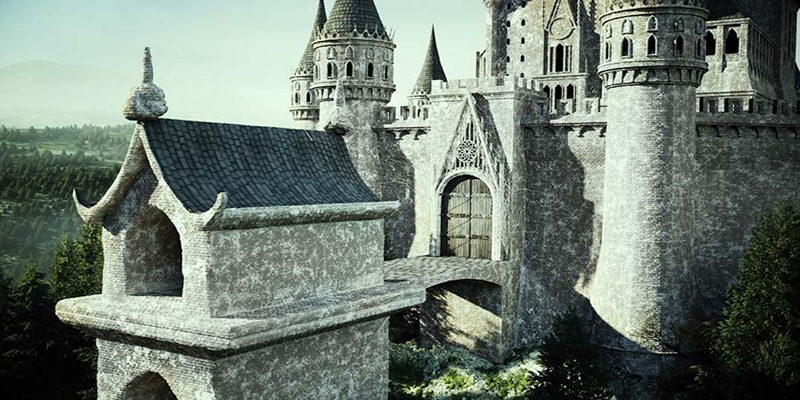
We’ve been getting a lot of questions in the comments and emails of Hughday snippets, and since not everyone reads the replies, here they are in one convenient place.
Hugh 2– when does it happen?
The action picks up right after Iron and Magic (three weeks later according to chapter 1).
As the notice in front of Iron and Magic says, the entire Hugh series happens before Magic Triumphs. That has not changed.
The chronological order is: Hugh series (all installments) – Magic Triumphs- Sanctuary- Wilmington Years (all installments)- Blood Heir series.
How long will Hugh’s series be?
Currently, House Andrews are thinking of it as a duology, but since the manuscript of volume 2 is being written as we speak, things may change.
Does Hugh 2 have a title?
Not yet. We’ve been calling it Hugh 2, Iron Covenant 2, Iron & Magic 2, Elara’s book, the d’Ambray Bake Off – at the moment, whatever you recognize works.
Will Steve West narrate the audiobook?
The manuscript for Hugh 2 has not yet been finished. That means there is no known exact date when it will be ready for publication, how many pages it will have etc. Which in turn means we cannot yet go to the very busy Steve West and ask whether he is free to take on the project, this is how long it would take, this is when it’s needed by, and all the other necessary details.
What I can guarantee is that House Andrews, the agency and everyone involved believe as much as we do that Steve West is perfect for the role of Hugh and no effort will be spared to book him if that is at all possible.
Will it be a blog serial?
I think House Andrews will be generous with snippets up to a point, but not a traditional serial that shares most of the book in regular installments, as updated this past Friday.
Yes, admin, very interesting, very interesting, I’m not snoring at all. What about spoiler spoiler spoiler spoiler?
No one knows about spoiler spoiler spoiler spoiler yet in Hugh 2.
Stop mentioning spoiler spoiler spoiler spoiler in the comments and spoiling spoiling spoiling spoiling fellow Horde colleagues who want to follow the natural course of the story.
Your comment will be hidden asap, but it might be too late. W*it for questions to be answered by the book and PUT DOWN THAT SPOILER, you Dushegubs!
That’s a good point, what about Blood Heir and put down that cow?
Blood Heir is currently the furthest in time KD World has ever gotten, and it’s roughly a decade after Hugh 2. Whatever bovine developments took place will require our p*tience.
The story was published somewhat out of schedule, because of the pandemic, and the similarities between what we were going through and what Julie was called to do. Like us, she couldn’t go home and see loved ones, or risk losing them. House Andrews wrote it and shared it with us in weekly chapters, as another loving hug in hard times, and I am very grateful it came when it did, even if it jumped the publication queue.
It will be followed by Blood Heir 2, which will be a sequel.
Let me clarify that: Blood Heir 2 will not be the story of Derek’s missing years and Julie’s time with Erra. That rumor started around the fire pits of my people, the proud pioneers of Team Facts be Damned. Love you guys, but no.
What House Andrews said was that it will explain what happened to Derek, but it will take place after Blood Heir 1. That’s why we need Wilmington 3 to come first, so we can fully understand some of the developments in Atlanta. ::cough Pack cough cough:: Oh dear, I really must have that seen to.
Yes, what about Wilmington Years?
The Wilmington Years series, in its entirety, happens between Magic Triumphs and the Blood Heir series.
There is a Wilmington 3 in plan, but not in progress. We have been given a tiny snippet from it here.
Currently, though, IA are working on Hugh 2. As much as we want all these books at once, and that once better be right now, and actually with Maud’s Innkeeper wedding on top, and you know Puffles … – we must attain fluffy awareness that they each take time and effort to be written.
What about Sanctuary 2?
Not on the schedule right now.
Where can I find any extras to tide me over?
All of them can be found on the Free Fiction page, organized by series.
For Kate’s World, they are :
A Questionable Client – prequel to the main Kate series
A bit more Roman – prequel scene to Sanctuary
Purpose, No Heroes – Wilmington Years extras
King of Fire– prequel to Blood Heir
Sandra – Kate’s POV during Blood Heir
Damian Angevin– the Order’s report of the events from the main series
And the fun fan service fiction of Kate and Curran texts, Luther and Roman’s Frinnterviews, Don’t Mess with Fate (Hugh and Roman).
I have a very important final Hugh question. Very very adminy, you have to answer. Don’t think too hard though, first thing that comes into your head, just tell us. Does Puffles fly home?
Nice try.
The post Hugh’s Question Corner first appeared on ILONA ANDREWS.
7 Author Shoutouts | Authors We Love To Recommend
Here are 7 Author Shoutouts for this week. Find your favorite author or discover an…
The post 7 Author Shoutouts | Authors We Love To Recommend appeared first on LitStack.
Say It Ain’t So
You’ve heard. I know you’ve heard. And I know what your reaction was — first, surprise… shock, even. Then sadness, and probably anger too. “Please, not again, Goddammit! And not him!” (And if you really haven’t heard, forgive me for being the bearer of bad news.)
Those were my reactions, anyway, when I read about the New York Magazine story that was published early this year (“There is No Safe Word,” by Lila Shapiro; the article may be paywalled), a story that contains appalling, sickeningly detailed accusations from multiple women of thoroughly vile conduct (up to and including outright sexual assault) by Neil Gaiman, one of the most successful and admired writers in contemporary fantasy.
Whatever the results of the inevitable adjudication, civil or criminal, I think it is safe to say that Gaiman (who has naturally denied everything, because that’s what a guilty and an innocent man alike would do) has, at the still relatively young age of sixty-four, entered the “public and professional pariah” stage of his life. This has been confirmed by the panicked corporate scramble to cancel any and all Gaiman-related film, television, and literary projects that were in any stage of discussion or production when the accusations began to surface.
I don’t know the truth about any of these allegations, of course, but given their number and scale and specificity, it’s extremely difficult to believe that the predicament Gaiman finds himself in is merely the result of a “misunderstanding” (his characterization). What I do know is how depressing and disheartening the whole thing is.
The strength of my reaction surprised me because I don’t have a deep relationship with Neil Gaiman’s work. He came to prominence writing the Sandman for DC, but that was in the late 80’s, after I had quit reading comics and before I started up again, so I’ve only read a few of those issues. Beyond that, I’ve read a half a dozen short stories and four of his books — his adult fantasy novels Neverwhere and Stardust, both of which I liked a lot, and his children’s fantasies Coraline and The Graveyard Book, which I liked more than just a lot.
The Graveyard Book (which I read last summer, right before the first cracks began to appear in Gaiman’s reputation) was, I thought, absolutely magnificent — deliciously eerie, bloodcurdlingly frightening, genuinely wise, deeply humane, flawlessly imagined and above all, beautifully written. I had tears in my eyes when I finished it, and I immediately began enthusiastically recommending it to anyone I knew who hadn’t read it. The Gaiman book that most people think is his greatest achievement, American Gods, is one that I’ve never gotten around to, though a copy has been sitting close to the top of my TBR pile for the past few years; I was thinking that maybe I would finally read it this summer.
My feelings about this awful news are based as much on the attractive public persona that Gaiman has so successfully projected as it is on his work itself, of which I’ve read only a fraction. I personally experienced his charm and magnetism at the San Diego Comic-Con once, where he was a guest at the annual Jack Kirby Tribute Panel; I was sitting just a few feet away as he spoke about his regard for the King, and talked movingly about how heartbroken he was for Kirby when he first read the 1970’s Eternals series and reached the point where it became clear that Kirby had, because of Marvel’s editorial interference, just given up on the story and characters he had invested so much in. (It was issue #15, actually.) I thoroughly approved of Gaiman at that moment — we all love it when a smart, successful, famous person echoes thoughts that we’ve had ourselves. (I too had noticed the big change in issue #15.) We’ve probably seen the last of that witty, convivial public figure.
I guess my dismay mostly stems from a feeling that I (and a lot of other people) had, that Neil Gaiman was one of the Good Guys, someone who championed all the right things, someone emblematic of all that’s best about the genre, a big-hearted, generous mentor, a major writer who always took the time to encourage and support other writers everywhere. Certainly no one was ever readier with an appreciative forward or an enthusiastic blurb. I’m not sure which author I’ve read the most of in my life, but I know I’ve read more blurbs by Neil Gaiman than by anyone else, by a couple of orders of magnitude; if I added them all up, they’d probably make a whole book in themselves. (The first thing I read this year, V.E. Schwab’s The Invisible Life of Addie LaRue, came emblazoned with a rapturous Gaiman recommendation. We’ve probably seen the last of those, too.)
This news has sparked so many emotions (always understanding that the real victims here are not paperback readers with hurt feelings) — the shock, sadness, and anger that I mentioned before, along with disappointment and resentment, too, resentment at being reminded of something that I would rather not be reminded of, something that all of us who love books and writers (any art, really) would much rather forget. You know what it is.
Baldly stated, it’s this: there is no necessary connection between a person’s moral character and the quality of his or her art.
In practice, this means that second-rate books (or mediocre music, or uninspired paintings, or worthless films) may very well be the sincere productions of otherwise admirable people, upright, honorable men and women of unshakeable integrity.
Good character, in other words, is no guarantee of talent. We know that and don’t have too much trouble acknowledging it; even if it doesn’t seem altogether fair, it’s something we can live with. There’s an obverse side to the coin, though, and that’s something we’re not nearly so comfortable looking at: a morally bad person may nevertheless be capable of producing great art, and we definitely don’t like that. We feel that it shouldn’t be so, because it somehow seems wrong in a way that the other side of the principle doesn’t. But the paradox is still true, even though we may wish it were otherwise.
We’re happier when the two halves come together neatly, when the artist and the art perfectly mesh, as in the case of Mary Anne Evans, who was, by all accounts, one of the finest people ever, and who wrote (under her pen name George Eliot) what I think is the greatest novel in the English language, Middlemarch, a book that glows with the decency, compassion, and generosity that exemplified its author’s private character. Mary Anne Evans poses us no problems.
Not everyone is Mary Ann Evans, though, and the number of people with very serious marks against their character who have produced great works of art is legion. (Dickens treated his wife abominably, Tolstoy was a monster of selfishness, Caravaggio was a murderer, and don’t even get me started about Roman Polanski.) For that reason, I guess this story shouldn’t have surprised me at all — but I’m glad it did. Though Gaiman may have played us all for suckers with his glowing public persona, I’d rather be a sucker than be so cynical that I couldn’t be shocked and depressed by such revelations. If you’re taken off-guard by something like this, it at least means that you still have faith in people; you don’t automatically expect everyone to be a hypocritical scumbag.
Now that this dreadful news is out, though, I’m stuck with the question — how can I reconcile the Neil Gaiman who could write the wonderful, uplifting, life-affirming Graveyard Book with the Neil Gaiman who could commit the atrocious acts that he is accused of? How can they be the same person?
I don’t know… but it looks like it may be necessary for me to make room for both the revulsion that I feel towards Neil Gaiman the man, and for the genuine joy and pleasure I received from this strange thing that he was somehow able to separate from himself, The Graveyard Book. I can do it, I guess. I’ll have to.
I’m not sure, though, if now I’ll ever read American Gods; I’m not sure I want to anymore.
Thomas Parker is a native Southern Californian and a lifelong science fiction, fantasy, and mystery fan. When not corrupting the next generation as a fourth grade teacher, he collects Roger Corman movies, Silver Age comic books, Ace doubles, and despairing looks from his wife. His last article for us was In Dreams: David Lynch: 1946 – 2025
The Chaos Weaver - Book Review
 The Chaos Weaver (The Chaos Chronicles #1)by Aubrey Winters
The Chaos Weaver (The Chaos Chronicles #1)by Aubrey WintersWhat is it about:A dragon took my brother.I’m going to get him back.
My entire world changes when a scheme-gone-wrong results in my brother being taken by a dragon.
I’ve followed them into a strange and dangerous world filled with magic and enemies, but its handsome king has promised to help me hone powers I never knew I had.
Can he help me find my brother, or will I lose my heart—and everything I ever knew—in the process?
What did I think of it:So on social media the author was giving people the opportunity to sign up for an Advance Reader Copy. At her mention of necromancy and a mysterious king, I immediately signed up. And I got an ARC!
This is a really cool read!
I loved Everly from the start. She and her twin brother had a bad start in life and are surviving by conning people and stealing. I didn't really like her brother, but to Everly he is the world. So I could understand she follows and wants to do anything to get him back when a dragon drags him off to another world.
I really enjoyed getting to know this other world together with Everly. She immediately lands in trouble, manages to get out of it, to fall in the next mess. At times she is a bit too trusting, but as the world she landed in has very different rules and she's on her own for the first time in her life, I could understand .
And then there's the mysterious king!
Without giving away too much I can tell you he was my favorite character (although long time blog followers might be fearing for his life now, I know I do).
The ending although not a complete cliffhanger was exciting, leaving lots of questions, and made me hungry for more!
I might need to get this in print when it releases (ebook releases January 31st, go preorder!), and I already got a book from another series by this author to try soon.
Why should you read it:Necromancy and a Mysterious King!Need I say more?!
Review: A Letter to the Luminous Deep by Sylvie Cathrall

Buy A Letter to the Luminous Deep
OFFICIAL AUTHOR BIO: Sylvie Cathrall writes stories of hope and healing with healthy doses of wonder and whimsy. She holds a graduate degree in odd Victorian art and has handled more than a few nineteenth-century letters (with great care). Sylvie married her former pen pal and lives in the mountains, where she dresses impractically and dreams of the sea.
FORMAT/INFO: A Letter to the Luminous Deep was published by Orbit Books on April 25th, 2024. It is available in paperback, ebook, and audiobook formats.
OVERVIEW/ANALYSIS: One year ago, a disaster struck the underwater residence known as the Deep House, leaving its two inhabitants, E. and Henerey, presumed dead. After a year of grieving, E.'s sister Sophy and Henerey's brother Vyerin begin to investigate the events that led to their siblings' death. Sifting through correspondence between the many individuals involved, the two begin to uncover a much more ominous mystery than they expected.
A Letter to the Luminous Deep is a charming underwater tale that ultimately dragged too much to keep me hooked. This is a very slow-paced affair, told largely through letters written in the style of the late 1800s. This is certainly a difficult form of novel to pull off. For one, there are occasional moments where the author has to do some narrative contortions to explain why certain events or conversations were put to paper. While I understand the necessity in order to convey certain key information to the reader, it does strain the credulity a bit in some places.
That said, there were also numerous ways the narrative structure worked. I did enjoy the subtle ominous foreboding that builds up over the course of the story. Certain innocuous observations of things that are "off" in the world begin to create an unsettling pattern, especially as we have a rough idea of how events end. Several people each have a piece of the puzzle, but it's only in assembling those pieces by collecting these letters that they (and the audience) start to see the whole picture.
I also liked the slow romance between the two characters of E. and Henerey. Each is a shy or reticent person for various reasons. Through the letters, however, we can see two people being understood in a way they haven't before. The use of aborted "first drafts" of letters also lets us see a little glimpse of their respective nervousness as they try to fumble through how to address a person they've developed feelings for, even though they've never met in person.
The author has also built up a fascinating maritime culture. Some calamity 1000 years ago left this fantasy world with minimal inhabitable land. As a result, whole peoples live one boats or floating collectives. As our focus in this story is on the colleges and scholarly life of these people, most of the details do remain frustratingly out of sight, but perhaps not unreasonably. The people writing the letters are focused on their own narrow slice of life, not on the workings of society as a whole.
CONCLUSION: While I did enjoy my read of A Letter to the Luminous Deep overall, I found it struggled to hold my attention towards the end. The narrative structure of letters just dragged events out. We have a good idea of what happened some thirty pages or so before the ending, with the rest of the characters trying to catch up through their long-winded missives. As someone who struggles with slow books, ultimately this just didn't click for me. While the set up for part two of the duology is intriguing, this tale simply isn't my cup of tea.
How to Survive “Interesting” Times
 Image by Ervin Gjata from Pixabay
Image by Ervin Gjata from Pixabay
Good afterevenmorn (or whenever you’re reading this)!
Welp, what a start to 2025. Personally, it hasn’t been great. I kicked off the year very ill (thanks, Covid), languishing in bed wondering if this was the moment I drown without ever touching water. ‘Twas not pretty. Looking wider, the world appears to be literally on fire, or underwater, or deliberately reduced to rubble. It’s not been a good time for a whole lot of folks. I have been taking care of myself by largely staying off social media (sorry if I was missed. But I was already overwhelmed and unable to cope with my own busy-ness, let alone the worries of the world at large), and engaging in art. Not creating physically, as I’ve been very unwell, but consuming, art. Okay, I’ve been watching lots of Chinese dramas (some of which I don’t remember because I was in a feverish haze). That still counts, though.
I’ve also been daydreaming a lot, which is usually the important first step in my creative process. I have a new book in my head. All I need to do is finish the book I’m working on now, and then sit down and draw out this story word by word. I expect that it will become my next free online serial.
Though I’m sick… again (not Covid this time, just an annoying flu)… I’m in a much better place, coping-wise. And I owe that to art.
 Some art, to cheer up the page.
Some art, to cheer up the page.
It has been a recent (or not so recent, depending on your perspective) trend toward denigrating the arts; removing funding for it, making absurd claims that those who provide it should not be properly compensated, or ignoring complete just how important the arts are and how much we rely upon them.
Think about it.
What usually happens when we’ve had a rough day? Most folks will go home, mix themselves a drink, and then turn on the television, or fire up that console or gaming PC. Those shows that you watch? Art. Those games you play? Art. Someone wrote, blocked, shot, and edited those episodes/games. Actors and voice actors stepped in to fill those roles. Composers created the score. This is also true for those of us who turn to films to make us feel better. I often watch movies that make me cry when I’ve had a rough time. It helps me get the angst out (as I usually struggle to feel at all. Yay, depression!). Sometimes, I’m not in the mood to cry, so I’ll put on a really dumb action flick because explosions and absurd situations make me happy. Sometimes it’s to laugh at the movie. Sometimes it’s to experience the catharsis of evil getting what it deserves. We so infrequently see that in the real world.
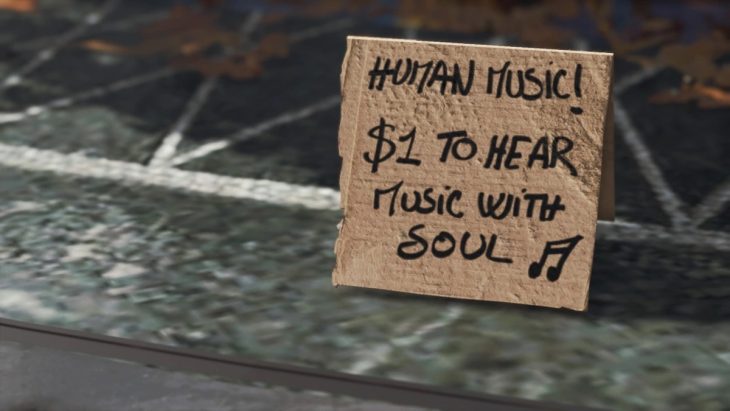 From the game Detroit Become Human – a fantastic exploration of AI what makes a person a person.
From the game Detroit Become Human – a fantastic exploration of AI what makes a person a person.
Television and film aren’t the only way we interact and lean on art.
I cannot tell you the number of times I have been struggling with, well, everything, and unable to find a way to express or clear it away. Then the right piece of music hits, and suddenly I’m a puddle on the floor, or my mind is hijacked and taken on a really impressive adventure. I lean on music a lot for coping with the world. It is even an incredibly important part of my writing process. I have crafted entire novels off a single song (the most recent example would be Skylark, which was written the moment I listened to a song, and then also with that one song on repeat for the three months it took to get that story out onto the page). I have listened to a song, and a critical scene plays out like a movie in my head, guided by the music. The most striking example is this song:
One day, if that story is ever published, I’ll let you all know which scene in particular this song engendered.
Books, of course, including audio books and comics, are other ways the arts create space for us. There are so many reasons and ways literature of all kinds can help. The simplest is a brief escape. I’m no longer me, sitting on the sofa, utterly destroyed by the state of the world. I’m a silent observer; part of adventuring party, or even the main character in another story. And in this story, however high the stakes may be, I am still safe on my sofa. It doesn’t matter what kind of escape. A low stakes, cozy read? Excellent escape. A dire, world-ending threat full of struggle and grief? Excellent escape (and also an opportunity to let those tears out at last). Escape is so important. It’s not forever. And it won’t solve the real-life problems for you.
 Image by Mystic Art Design from Pixabay
Image by Mystic Art Design from Pixabay
But rest is important. If you don’t have a rest day in your workout regime, your muscles will have not time heal, recover and grow. If you do not get adequate sleep, your cognitive function will be severely impacted. It’s no different for your mind/heart. If you don’t take a break from what is causing you distress, you’ll collapse beneath the weight of it all. It’s important to escape. Do it, and don’t feel guilty for it.
Literature also helps navigate terrible situations and scenarios for those of us who struggle with doing so in the real world. It helps give voice, using someone else’s words, to our experiences with enough separation that we remain safe. And sometimes, sometimes it can unlock the tings we need released in order to move forward. I have often been struggling with a completely separate grief, read a particularly tragic incident in a story that has nothing to do with whatever is weighing on me, and then cried. And cried. And cried. Not about the events in the book. But about the situation I’m facing. It’s just that the book helped unlocked the emotions that were trapped behind a dam I didn’t know I had built. Visual media has also helped with this; more with videogames than television shows or films of late, admittedly.
It’s no mistake that nearly all of us turn to the arts when things start going wrong. The arts are important and necessary.
So this is how you survive these interesting times. Consume art.
 Image by Jose Antonio Alba from Pixabay
Image by Jose Antonio Alba from Pixabay
And make it.
I know it’s incredibly difficult to create with the world literally on fire. Or if you’re sick in bed with all the energy of a sloth after a big meal. All the same, human beings are creators by nature. It doesn’t matter what art you create. Or if other people think that art is good. You don’t have to share it at all. It’s just for you. Just create.
That can mean something as simple as buying yourself a colouring book and going to town with crayons or pencils. Hell, even a ball-point pen will work if you’re in a pinch. Got some time between tasks at work? Doodle. Write a short poem. A piece of flash fiction. It doesn’t have to practical. It doesn’t have to be monetized. It does not have to appeal to anyone else. It’s just for you, unless you want otherwise.
If you want, share your art. But that is not required.
It is hard right now. It’s alright if you’re struggling to create. Lord knows, I am. Finding motivation is tough in the current clime. Sometimes I think that’s by design. If you’re too busy trying to stay afloat, how can you imagine anything better for yourself, your neighbours, or the world? So, if anger, frustration and rage is all you have left, use that. Create from that.
Create out of spite.
Create. Make it a giant middle finger to the people who are trying to hold you down, make it hard, steal your joy, stop you from imagining.
Create art. Consume art. It is good for your soul, and the world could use more soul, I feel.
And if you have the means, consider tossing a coin to your Witcher (artist), for their skills have kept the monsters at bay for a little while longer. And in a world full of monsters, that is not nothing.
When S.M. Carrière isn’t brutally killing your favorite characters, she spends her time teaching martial arts, live streaming video games, and cuddling her cat. In other words, she spends her time teaching others to kill, streaming her digital kills, and a cuddling furry murderer. Her most recent titles include Daughters of Britain, Skylark and Human. Her serial The New Haven Incident is free and goes up every Friday on her blog.

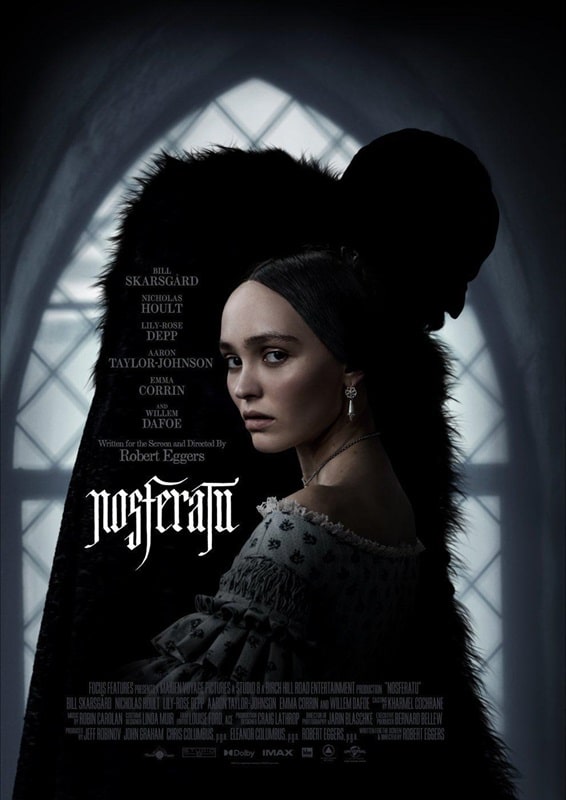
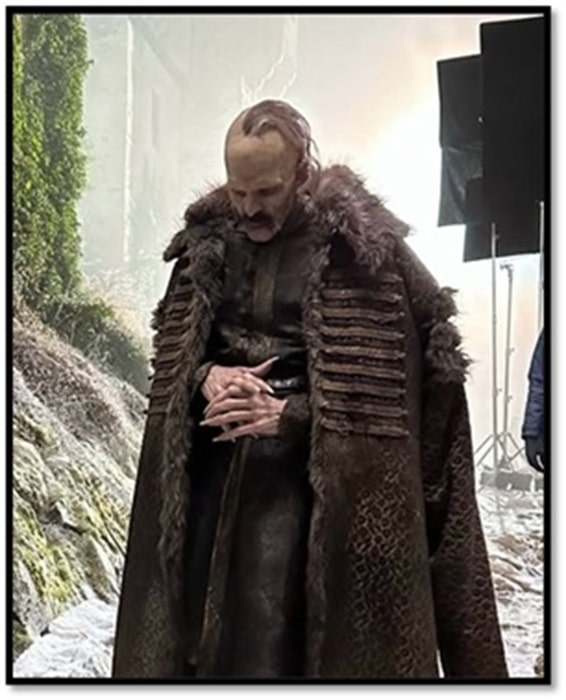
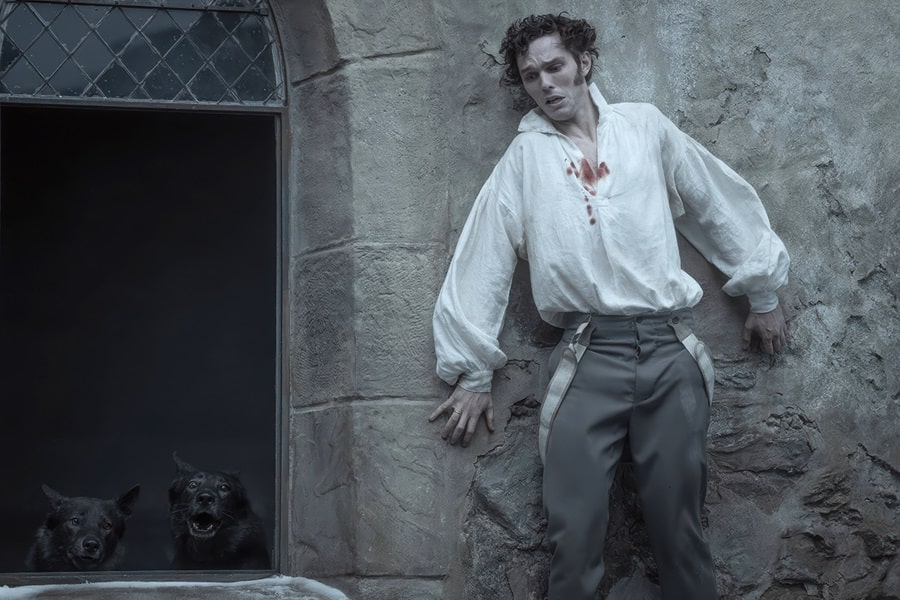
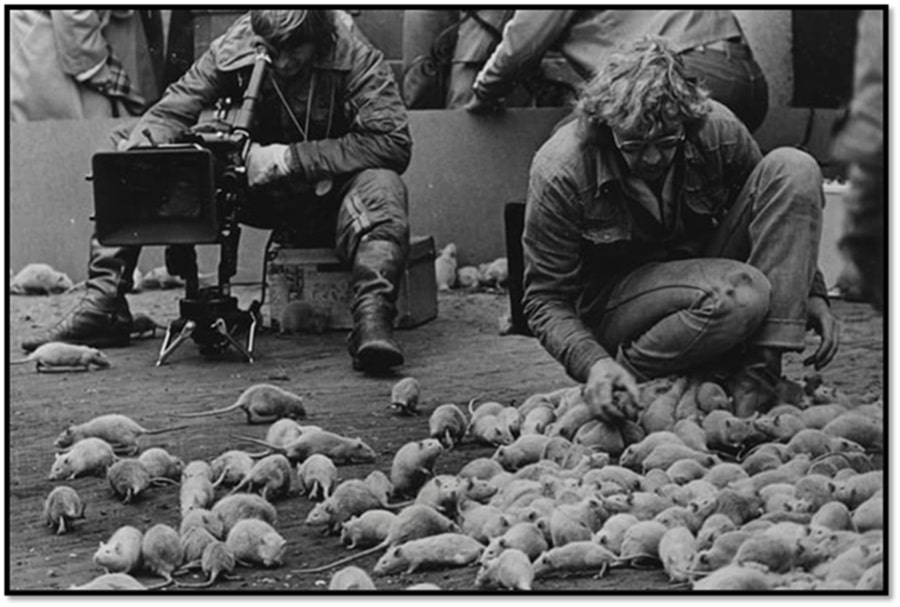
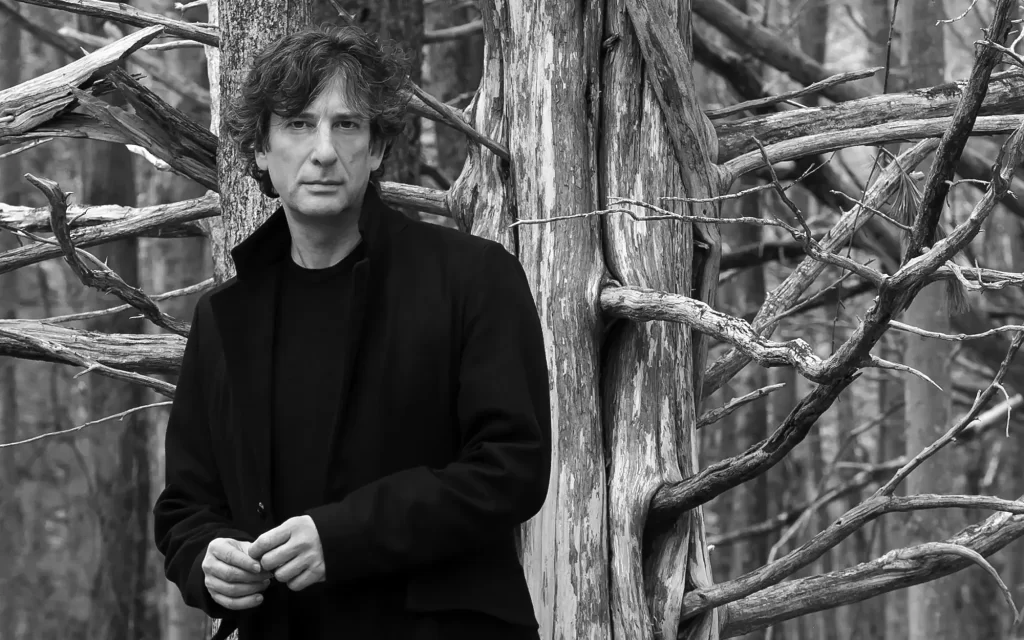
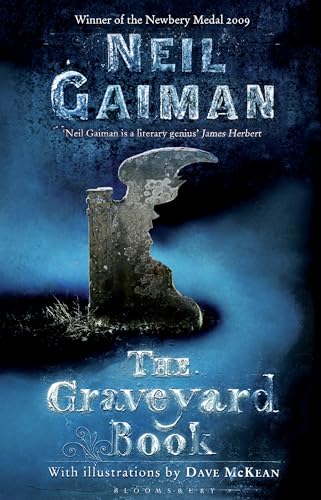
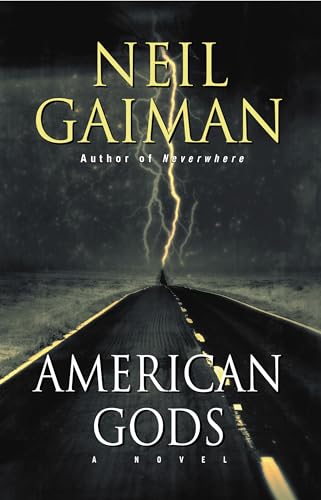
Recent comments